





Scottish farm income figures reflect volatility
PAGE







Scottish farm income figures reflect volatility
PAGE















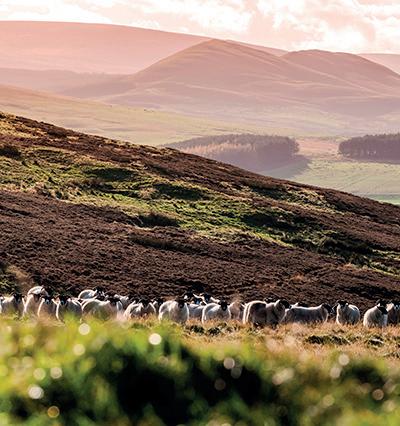
Drilling underway despite tough conditions
PAGE
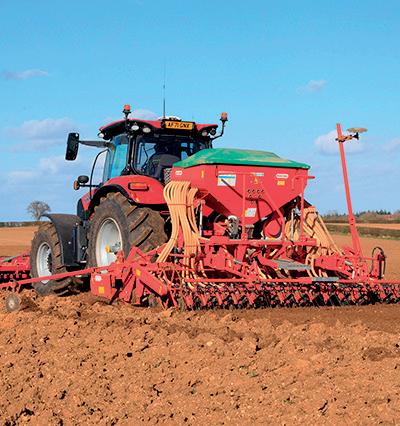
Young farmer pursues childhood dream
PAGE
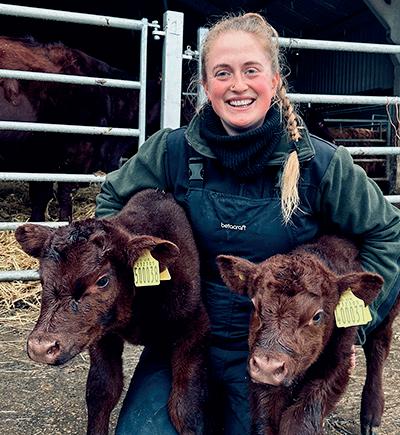
THERE was a positive mood around the auction rings in the lead up to Easter, owing to high prices, tight numbers and a good demand for lambs.
Prices eased back slightly in the last week of trade before Easter, but farmers at marts remained ‘delighted’ with the sums they were achieving for their stock.
Iain MacDonald, market intelligence officer at Quality Meat Scotland, said the coming weeks looked ‘positive’ for farmers in terms of price run, although the market in the second quarter could be ‘tight’.
He said: “The signals are good, owing in part to last year’s reduced lamb crop, which was down about 6 per cent across the UK.
“All the numbers point to fewer lambs being about, but abattoir numbers have so far held up and slaughter figures have been pretty strong.
“We have obviously had a lift in the supply for Ramadan, Eid and Easter, but it could mean there will not be a lot of hoggs about for the next couple

of months and overall supply could be tight in the second quarter until the new season lambs come into market.”
Mr MacDonald said although prices had softened over the past week as the main Easter buying period had passed, preparations for Eid, which takes place on April 10, meant prices were expected to remain fairly stable over the coming weeks.
He said: “There have been some record high prices this year – even above previous new season prices.
“This is all good news for the farmer, but maybe not so good for the processor as they have to sell these lambs they have paid a high price for.”
Harrison and Hetherington auctioneer James Little agreed prices had eased in the past week.
Spring lambs had also started to come forward, with the best lambs making towards £5/kg.
He said: “Demand from both the ethnic community and export seem to be really strong. Other countries either do not have the volumes or have sold it to other markets. It has created a perfect storm.
“The mood is as expected, [farmers] are elated with the prices. But they are not stupid; they realise the levels sheep are trading at cannot go on forever. They are enjoying it while it is here.”
Mr Little also said he had heard a lot of ‘horror stories’ about spring lambs in the south of England.
He said: “If that is the case and numbers do not come out through May and June, the sheep will stay at a good trade. Obviously, it is all dependent on the numbers and what is going to be available.”
John Walton, auctioneer at Longtown Mart in Carlisle, said trade had never been so dear for prime hoggs.
“It has just eased this week, close to
CONTINUED ON PAGE 14

Red
Scottish farm
Brazilian
This
Young
Food Standards Scotland’s five steps to prevent lead and copper poisoning at grazing 76
A focus on beef farming, including a look into lungworm control
84
Open Farm Sunday gives industry chance to connect 94
With James Robinson in Cumbria and Helen Stanier in Yorkshire 94
‘We need to see change in Welsh agricultural policy’, says Ian Rickman
Global
A closer look at trailers, including Bunning’s
Beef
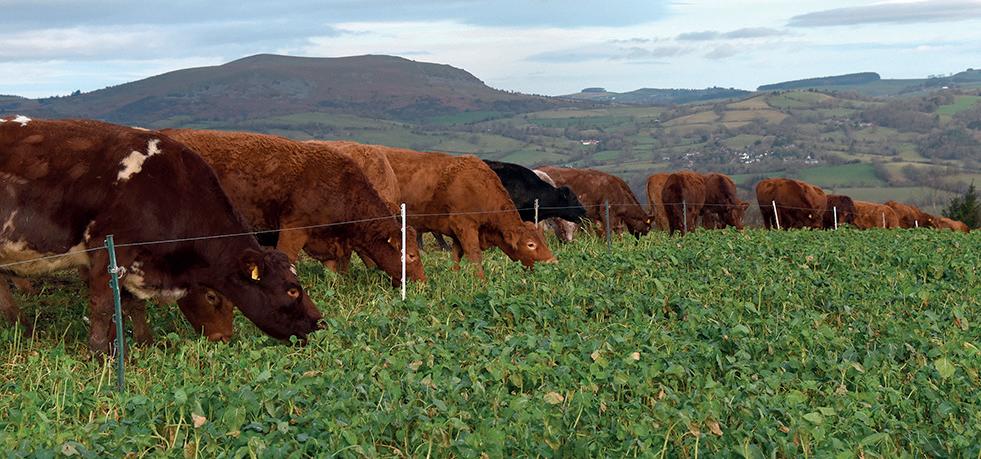
DEFRA Secretary Steve Barclay has confirmed a decision on both the Tenant Farming Commissioner and Code of Practice for the tenanted sector is expected to be announced ahead of the Government’s next Farm to Fork summit.
Mr Barclay made the statement during his debut appearance before the Environment, Food and Rural Affairs Select Committee this week in which he detailed the department’s response to a raft of key issues including bovine TB, flooding, the Rural Payments Agency (RPA), the new Sustainable Farming Incentive (SFI) and the introduction of the long-awaited Land Use Framework.
He told MPs: “I am very, very conscious of how hard it has been for farmers. But we are actively listening. No-one would sit here and say that there is not more to do. But you can see the direction of travel and it is very much to secure food production.”
Mr Barclay also revealed the Defra budget for the coming year would benefit from two years of underspending, which meant there was around £400 million extra available.
“While we have stuck to our manifesto commitment of £2.4 billion, it does mean there will be more money next year which I think is essential given the wider volatility that the sector faces.”
The Minister was keen to assure MPs the department was working hard to relieve the pressure on farmers and that issues surrounding men-
tal health was something he was ‘most concerned about’.
Mr Barclay said he was keen to amend the nature of on-farm inspections and that he had met with the RPA to ‘discuss how we change the relationship’ between farmers and inspectors which many farmers feel is based on ‘suspicion’. Mr Barclay added it was important the role was changed to be more ‘advisory and supportive’.
“I want to see the change so farmers are helped to do the right thing rather than feeling they are caught on a technicality and not paid. At times of volatility that causes huge amounts of distress,” he said.
In what was a very measured yet confident appearance, Mr Barclay sought to reassure farmers about land use and said he too did not ‘understand’ why Grade 1 and Grade 2 land would be allowed to be taken out of production for solar schemes. He also pledged to work more closely with other departments to redress the balance between agriculture and other demands such as energy and levelling up.
However, while the Secretary of State received many nods of approval on various topics from the MPs present, the area of border security appeared to be a sticking point, with chair Sir Robert Goodwill suggesting more needed to be done – and quickly – to ensure the correct border measures were in place to protect UK biosecurity before more changes come into effect at the end of April.
THE chair of the Environment, Food and Rural Affairs Committee, Sir Robert Goodwill, has criticised the Government for its ‘non-committal’ response to soil health and failing to adapt its farming schemes.
The committee urged the Government to put soil health on the ‘same footing’ as water and air quality policy.
It recommended the Government looks at issues in the food
supply chain which encouraged poor soil management, including low profitability for farmers and unsustainable consumer and retailer demands.
In its response, the Government pointed to its June 2022 Food Strategy and its ongoing engagement with the agri-food industry. But the committee said it set out ‘few concrete proposals for change’.

AS farmers head into the busiest time of year throughout Scotland, Ally
the Scottish
BUYERS from the public sector including the NHS gathered on former NFU deputy president Stuart Roberts’ farm to learn more about British produce. The event, organised by Love British Food, was aimed at connecting public sector decision-makers with British food producers, farmers and suppliers.
Attendees included Phil Shelley, chair of NHS Food Review, and Tim Radcliffe, national lead for Net Zero Food. The aim was to inspire public sector providers to work with farmers and food producers to achieve robust supply chains of nutritious food.
Organisers also stressed buying from British farmers will help the sector meet sustainability and net zero targets, as well as deliver social value.
THE Welsh Government cannot afford to wait until the beginning of May to publish its report on the Sustainable Farming Scheme (SFS) consultation responses if it intends to launch the scheme in January 2025.
That was the message from NFU Cymru president Aled Jones at the union’s first meeting with both
the new First Minister Vaughan Gething and his newly-appointed Cabinet Secretary for Climate Change and Rural Affairs, Huw Irranca-Davies MS.
Mr Jones said while he applauded the Welsh Government’s ‘ambition’, he was ‘resistant to launching an SFS that was not ready’, adding he felt there was a lack of comprehension on ‘the enormity’ of what was still left to be done with SFS, including piloting and an up-to-date impact assessment.
The appointment of Mr Davies has, on the whole, been positively
received, with a feeling that he was a ‘good choice’ out of those rumoured for the job at the time.
Farmers and union leaders recorganised his wealth of experience, and the fact he is a familiar face to the industry, having served as a former Shadow Defra Minister.
Mr Jones acknowledged while many would instead ‘look for a place to hide’, given the ‘anger and fear’ out there in the industry, Mr Davies said he was determined to get the industry to a position that it can work with.
But Mr Jones said he did not want to ‘expand hope beyond what it is’ right now, and that there were no ‘tangible actions’ yet to judge the new team on.
Mr Jones reiterated in the meeting that farmers feel ‘disengaged’ with Welsh Government, adding if they wanted to restore relationships they must demonstrate that they are listening.
NFU Cymru has requested regular meetings with Mr Davies, in order to keep up momentum, and urged him to take a personal role in policy design.


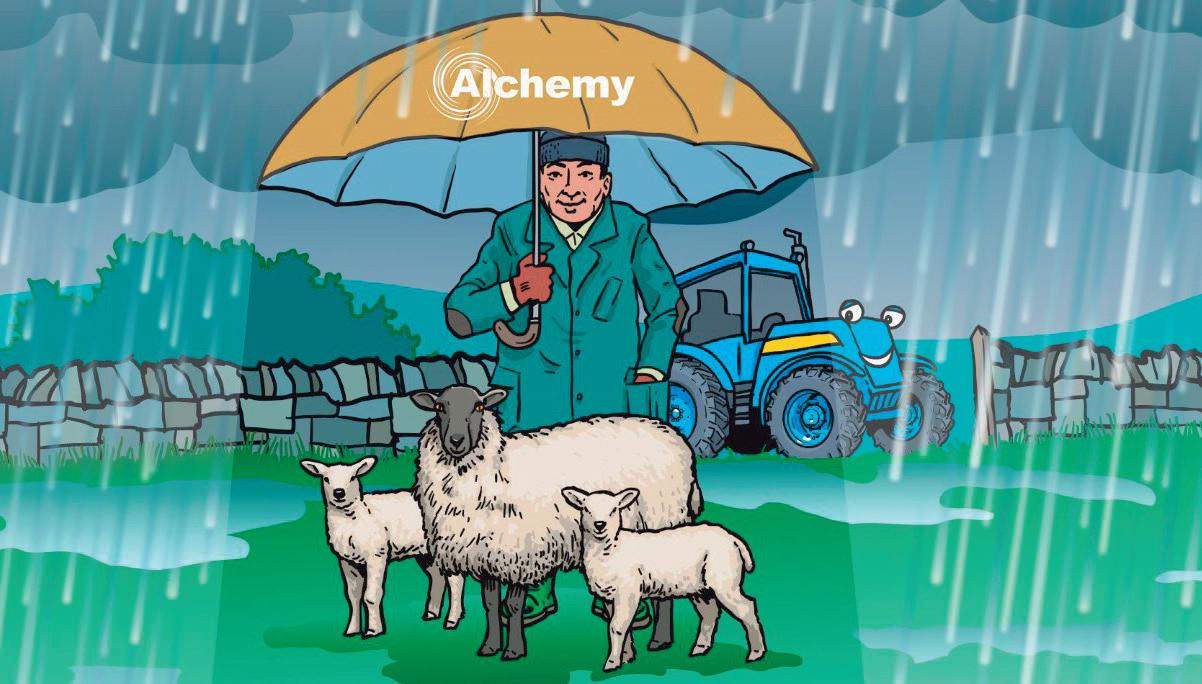
Farmers Guardian, Unit 4, Fulwood Business Park, Caxton Road, Fulwood, Preston, Lancashire, PR2 9NZ
Editor
Olivia Midgley, 07787 240 750 olivia.midgley@agriconnect.com
Head of News and Business Alex Black, 01772 799 409 alex.black@agriconnect.com
Chief Reporter
Rachael Brown, 07974 039 778 rachael.brown@agriconnect.com
News and Business Reporters
Jane Thynne jane.thynne@agriconnect.com
Chris Brayford, 07773 110 733 chris.brayford@agriconnect.com
Business Reporter
Cedric Porter cedric.porter@agriconnect.com
Arable Technical Specialist
Ash Ellwood, 07786 190 188 ashleigh.ellwood@agriconnect.com
Head of Machinery and Farm Technology
Toby Whatley, 07583 054 831 toby.whatley@agriconnect.com
Machinery Reporter
James Huyton, 07787 242 185 james.huyton@agriconnect.com
Head of Livestock
Katie Jones, 07786 856 439 katie.jones@agriconnect.com
Head of Livestock Sales
Angela Calvert, 07768 796 492 angela.calvert@agriconnect.com
Livestock Specialists
Ellie Layton, 07814 997 407 ellie.layton@agriconnect.com
Katie Fallon, 07815 003 227 katie.fallon@agriconnect.com
Online Editor and Features Editor
Emily Ashworth, 01772 799 446 emily.ashworth@agriconnect.com
Creative Services
Mike Begley, 01772 799 405 mike.begley@agriconnect.com
Katie Haydock, 01772 799 561 katie.haydock@agriconnect.com
Picture Editor Marcello Garbagnoli, 01772 799 445 marcello.garbagnoli@agriconnect.com
Sales Director Stephanie Ryder, 07917 271 987 Stephanie.ryder@agriconnect.com
Circulation Subscription hotline 0330 333 0056 help@subscribe.farmers-guardian.com
Newstrade enquiries 01772 799 434
UK print subscriptions £189; Europe: £226.80; RoW: £283.50.
FG digital subscriptions: £109
News trade distribution
Seymour Distribution Ltd, 2 East Poultry Avenue, London, EC1A 9PT.
Tel 0207 429 4000, Fax 0207 429 4001
PublishedbyAgriconnect
The




FARMERS have welcomed the news Red Tractor has dropped its controversial Greener Farms Commitment (GFC), admitting errors were made in the process.
Christine Tacon, chair of Red Tractor, said while the module had been conceived with the best of intentions, errors had been made.
“We take responsibility for those issues and are sorry. We hope that by dropping the module we can close the door on this chapter and move forward,” she said.
“We will only be involved in future environmental standards when all
constituencies across the UK food and farming chain, by sector, ask us to and with full consultation.”
Red Tractor’s Assured Food Standards Board also accepted the conclusions of the Campbell Tickell review of Red Tractor’s governance and confirmed its commitment to implement all the recommendations.
Ms Tacon added: “While the review found that ‘Red Tractor governance is sound’, it also sent a clear message about the frustration farmers are feeling.
“We will act now to improve our communications to farmers, including the transparency of our operations, purpose and benefits and we will strengthen our stakeholder engagement.”
She also said they would listen ‘more closely’ to farmers.
In a joint statement, the NFU, NFU Cymru, NFU Scotland, the Ulster Farmers Union and AHDB, welcomed the move.
The statement said: “It is also pleasing to see a commitment from Red Tractor that it will only consider future environmental standards with sector consensus and full consultation.
“This is essential in rebuilding trust with farmers from across Britain, something we are pleased that Red Tractor has said is a priority and is already acting upon.”
British Farming Union spokesman Humphrey Mills said it had been against the GFC from the beginning.
He added it was not a case of being ‘anti-green’, but that farmers could not afford to give away their natural capital without receiving a premium.
“We have all got businesses to run,” he said.
He added there was ‘so little trust in Red Tractor now’.
“Anything coming from there is greeted by most farmers with a complete lack of trust,” he said.
ALL four farming unions have stressed the need for governments to back farming and food production.
At their annual summit hosted by the Ulster Farmers Union (UFU) last week (March 22), union leaders discussed the importance of building profitable and resilient farm businesses to ‘safeguard the nation’s food security’.
UFU president David Brown said to achieve this ambition there must be a ‘closer partnership between farmers and politicians’ to ensure farmers can produce the high quality food which consumers expect, while delivering for both the environment and the economy.
Mr Brown said: “Across the UK
there needs to be a balanced approach at a policy level, not just to look at the environmental side of agriculture, but at the economic and social consequences of agricultural production.
“Farmers cannot be sacrificed for other societal objectives. They are essential to both a healthy world and a healthy population.
Essential
“Investing in our farming and growing sector is essential for productivity, job creation and economic and environmental delivery. This year we will see where all UK parties stand on support for local agriculture. Food security must be a top priority for any Govern-
ment and we need unwavering commitment for local farming and food production from all UK parties.”
Mr Brown, alongside other union leaders, called on processors, retailers and the foodservice sector to get behind domestic food production to support fairness in the supply chain and ‘not to undermine’ the market.
“Consumers have recently been very clear in communicating this at retail level having made the distinction between local and imported food which our farmers appreciate greatly,” he said.
Other key discussion points raised by the unions included trade standards, bovine TB, labour and land tenure.
SCOTTISH farmers and crofters are set to receive their annual payments under the Scottish Suckler Beef Support Scheme (SSBSS), with some being offered higher rates following the ‘concerning reduction’ in calf and cattle numbers last year.
NFU Scotland has welcomed the commitment from Scottish Government that owing to the new conditionality around calving intervals, the SSBSS will remain part of any future support arrangements.
However, the union also said it had concerns over figures from 2023, which showed a worrying decrease in the total number of mainland and island businesses making a claim – down from 6,499 in 2022 to 6,423. There was also a 4 per cent decrease in the total number of beef calves claimed, which was down from 379,740 to 366,371.
Although with fewer animals claimed, it means there has been a small increase in the payments per head, with mainland beef calves receiving £105.24 and island calves receiving £151.24 per head.
Aberdeenshire farmer and NFUS vice-president Andrew Connon said
while he welcomed the ‘prompt payments’ of SSBSS this year, the 4 per cent fall in claims was ‘concerning’.
He said: “It signifies our iconic beef sector still faces ongoing uncertainty and vulnerability despite the very robust prices for store and prime cattle being seen just now.”
Mr Connon added it was important the Scottish Government provided further details on the new conditionality rules attached to the scheme as spring calving was already in full swing across Scotland.
Neil Wilson, executive director of the Institute of Auctioneers and Appraisers in Scotland, said there was not ‘sufficient clarity’ around the budget for the scheme which was initially put in place to support suckler beef farming.
Mr Wilson said: “This could easily be corrected by a further Government announcement committing allocation of associated funding through to 2028 and ring-fencing the current budget for all eligible calves.”
He said the reduction in cattle numbers across Scotland had been a ‘longterm trend’ that challenged the ‘critical mass’ of the country’s beef sector.
“This conditionality does little to aid a recovery in the beef sector, rather creating another hurdle for farmers. The whole agricultural industry needs to play a part in reducing emissions, however the food security of the nation cannot be set aside in this carbon ‘tunnel vision’.”
Scottish farmers and crofters are set to receive annual payments as part of the Scottish Suckler Beef Support Scheme.
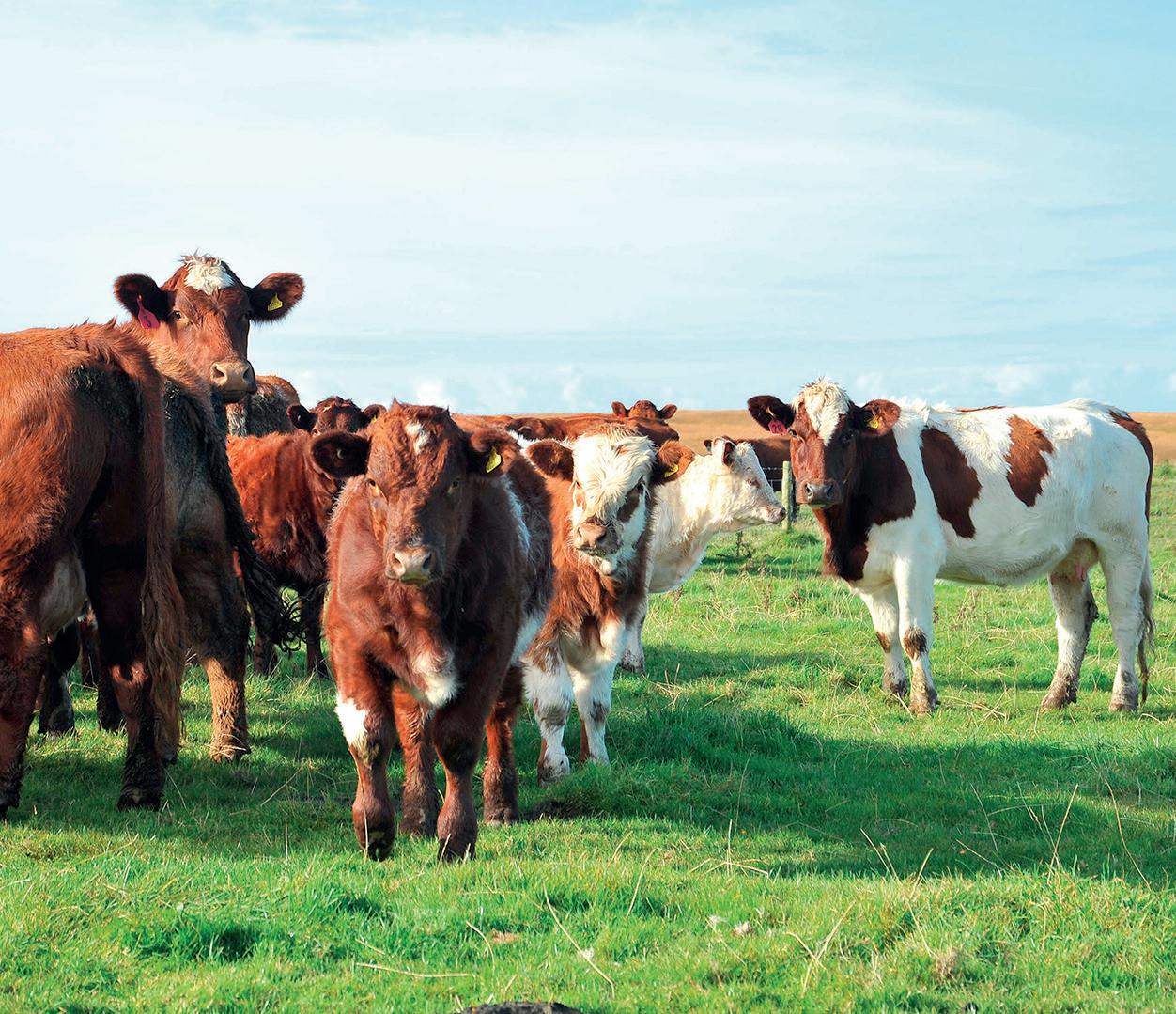








Designed as a true multi-tasker with a combination of levelling boards, heavy duty spring tines, seeder unit and option of towing a roller, the new Grass-Combi is capable of rejuvenating grassland but also acting as a cover crop establishment tool.
• Sprung shattaboards
• Hydraulically adjustable spring tines
• Fitted with Cat II linkage hooks and clevis hitch
• Folds to within 2.5m for transport



•
• Water ballasted - increase weight to around 1 ton/m
• Chamfered roller ends - prevents damage on headland turns
• 610mm & 710mm diameter rolls
• Working width 3m – 8.2m
THE Government has been accused of turning the Environment Agency (EA) into a ‘leaky bucket of low morale’ as new figures revealed almost 9,000 staff have quit their jobs amid funding cuts and repeated sewage scandals.
According to figures obtained by the Liberal Democrats, an estimated one-in-five staff left the agency in 2017 following cuts. Since 2016, 8,836 staff have deserted the body, which the party said all but wiped out the Government’s recent recruitment drive.
The party said the crisis had been brought about by continued real-term budget cuts. In 2022, research by public


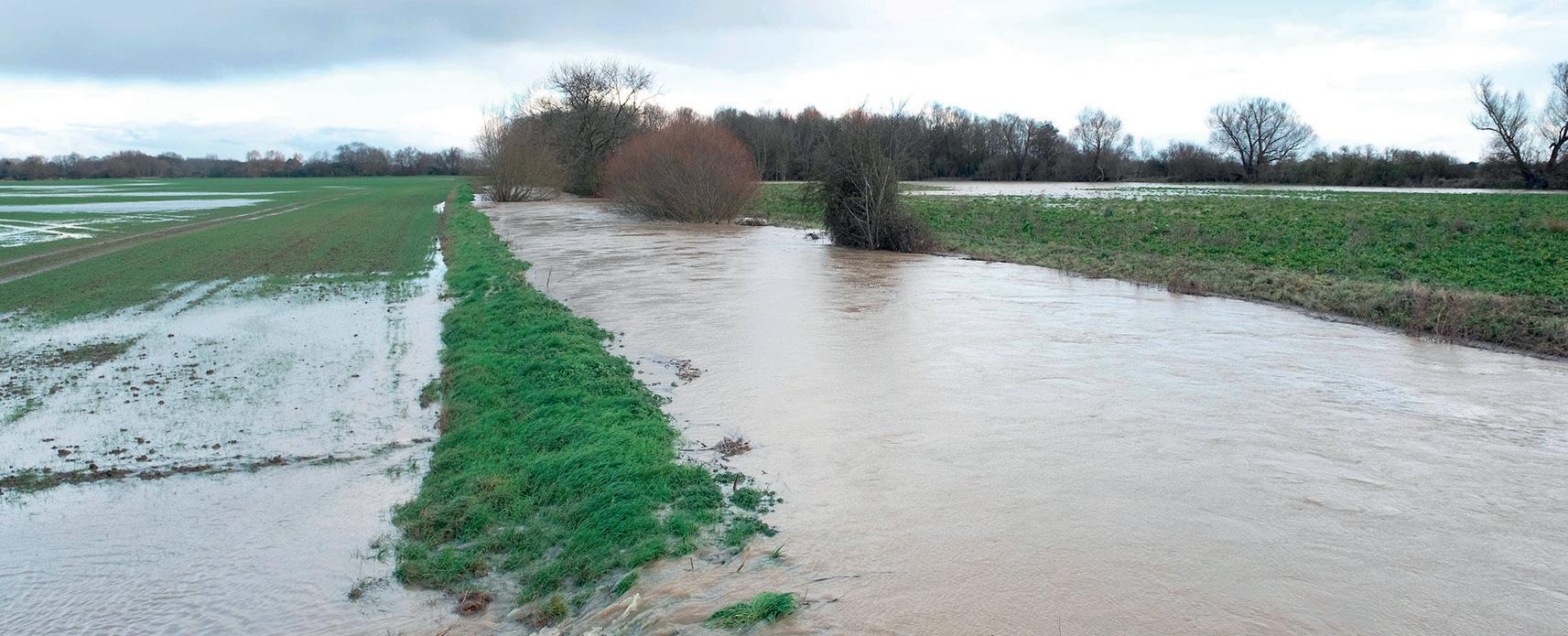
sector trade union Prospect said Government funding for ‘environmental protection’ was 56 per cent lower in real-terms than it was in 2009-10, as it




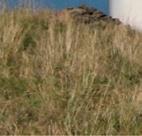
The Environment Agency’s emergency response teams said they were stretched too thin to protect communities from environmental dangers.

more than halved the £170 million budget of 2009-10 to £76m in 2019-20.
In 2021, the allocation for environmental protection stood at just over £94m. More than a decade earlier, and allowing for rising inflation rates, the funding was £213.8m.
According to the Liberal Democrats, the agency has been plagued by complaints of low pay, understaffing and low morale from staff. In particular, its emergency response teams said they were stretched too thin to protect communities from environmental dangers.
The party’s environment spokesman, MP for Westmorland and Lonsdale Tim Farron, said there was a direct correlation between ‘massive Conservative cuts’ to the agency and an exodus of staff.
He said: “Under this Government,

the EA has become a leaky bucket of low morale. The only people celebrating these damning figures will be the polluting water firms, who get away scot-free for their sewage spills.
“Communities are left to suffer from floods and sewage in their rivers because Ministers slashed the Environment Agency to the bone.”
An EA spokesperson said: “Our staff are vital to our work to protect the environment, people and wildlife from harm, which is why we are committed to providing a healthy and high-quality working environment.
“Since April 2021, we have seen more than 4,800 people join the EA, with a drop in those leaving in the last year. A survey of new starters in the past 12 months found 90 per cent would recommend the EA as a good place to work and 88 per cent hoped to stay and progress their career.”
Tompkins to make the most of them.
















OUTGOING NFU dairy board chair Michael Oakes has warned farmers and processors must not revert to an ‘us and them’ attitude, but should instead focus on ‘building relationships’ which benefit the dairy industry as a whole.
Mr Oakes, who has spent 14 years on the NFU dairy board and eight years as chair, has now passed on the baton to Vale of York dairy farmer Paul Tompkins. When asked what words of advice he had for his successor, Mr Oakes said there were ‘lots of allies out there’ and encouraged Mr
Mr Oakes said: “They [the processors and retailers] need us and we need them. While we will not agree all the time, by any means, I think actually working together means we are so much stronger.”
A key moment for the Midlandsbased farmer was the introduction of new legislation to ensure fair and transparent dairy contracts. Mr Oakes said he was proud of the legislation, which he readily admits took longer than he thought owing to ‘Brexit, the pandemic and Defra’s lawyers’.
LEADERS of a farming protest which brought around 100 tractors to London on Monday (March 25) have hailed the event as a ‘huge success’.
The tractors set off on a go-slow demonstration, leaving New Covent Garden Market at 5.30pm.
The focus of the protest was on substandard imports, dishonest labelling and concerns for food security.
Liz Webster, founder of Save British Farming, which organised the protest alongside Kent-based group Fairness for Farmers, said the support had brought her to tears.
“It was an amazing experience,” she said.
“The police were hugely supportive and seeing all the media about it,
we have dominated the news which is fantastic. We got the balance just about right. It was seen as peaceful.”
Ms Webster said around 100 tractors were in attendance and Parliament Green was full of people.
“There was massive support from everybody,” she said.
Looking forward, Ms Webster said the conversation needed to continue around the group’s three main demands.
This latest action follows similar protests which have taken place across the UK as farmers campaign for fairer treatment from governments and retailers.

rPeople want healthy food available to allBy Rachael Brown
THE British public have called on the Government to ensure farmers are treated fairly and to make sure healthy food is affordable to everyone.
It came as a tractor go-slow took place in Westminster on Monday to ‘sound the alarm’ on the future of farming, organised by Save British Farming and Fairness for Farmers of Kent.
Polling commissioned by the
Food, Farming and Countryside Commission (FFCC) showed 68 per cent of the British public want to see the Government take more action to make sure healthy food is affordable, amid increasing financial pressures and a ‘worsening food environment’.
On support for farming, 62 per cent wanted greater intervention to ensure farmers are treated fairly.
It is part of the FFCC’s next phase of ‘The Food Conversation’ – a series of workshops across the UK – to find ‘urgent solutions to the British growing food crisis’.
The FFCC said the results un -
earthed a ‘real food crisis in Britain’, in which an estimated 11.3 million people nationwide experience food insecurity.
The poll found four-in-five people thought healthy food should be something that everyone should be able to have, yet only 8 per cent thought it was affordable to most people, with almost half stating that financial pressures have made them cut back on the quality of food which they eat.
Sue Pritchard, chief executive of the FFCC, said: “Of all the elements of our everyday economy, one of
This spring we should not overlook the potential of fortifying grass for grazing, or for silage with selenium (Se). Data from Yara analytical services shows that more than 90% of grass and grass silage samples tested are deficient in selenium. Increasing the Se levels in grass can significantly reduce health problems and improve reproductive performance in livestock. Using a fortified fertiliser ensures that grass or silage has Se levels which meet the animal’s requirements of 0.2-0.3 mg/kg DM.
We might believe that using fertilizer fortified with Se, such as YaraMila STOCK BOOSTER S (25-5-5 + 5 % SO3 + Se), is only useful for grazing livestock but this is not the case. If grass silage is fertilized using our
01472
the things we simply cannot manage without is healthy food.
“How did this basic necessity become a luxury that few can afford?”
Dr Courtney Scott, director of policy and research at the FFCC, added: “The public are telling us they want change. We are hearing a clear message that how we grow, make and eat food just is not working for everyday people anymore.
“Citizens want farmers to be paid fairly, for food to be produced in ways that limits damage to the climate and for everyone to be able to afford healthy food.”
with Philip Cosgrave Agronomist, Yara UK Ltd.
YaraMila SILAGE BOOSTER (20-4.5-14.5 + 7.5% SO3 + Se), this silage will have enough Se to meet the needs of ewes and cows. Livestock utilise the Se in grass and silage more efficiently than the Se found in boluses, licks and TMR mineral mixes.
As spring calving dairy and suckler cows reach peak milk in April and May, which coincides with the start of breeding, it’s crucial that Se intakes are adequate for lactating cows at grass to ensure good reproductive performance. By using YaraMila NUTRI BOOSTER (25% N + 5% SO3) or YaraMila STOCK BOOSTER S, you are effectively increasing the selenium levels in every bite of grass for your grazing livestock. For more information on selenium in grass search “Yara selenium”
With Easter bringing increased numbers of walkers into the countryside, Chris Brayford looks at livestock worrying as the public are urged to keep dogs on leads.
FEARS of sheep worrying over the holiday period have raised tensions among farmers as they deal with the repercussions of dog attacks on livestock, affecting their health, welfare and the viability of their businesses.
To mark Sheep Worrying Awareness Week, a campaign to highlight the challenges of incidents, the National Sheep Association (NSA) has published a new study which revealed 78 per cent of officers said there had been an increase in dog attacks on sheep over recent years.
According to the survey, 33 per cent of officers said they were dealing with incidents on a weekly basis, while 57 per cent said sheep worrying by dogs was their most frequently reported category of rural crime.
Important
NSA chief executive Phil Stocker said it was important for farmers to report every single incident to the police, even if they have reservations about how the situation will be handled.
He said: “We know that cases continue to rise, however only a fraction of those do actually get reported to the police, due to farmers believing there may be little this action can do.
“However, the NSA urges farmers to report all attacks as we continue to strive to reveal the true alarming level of this problem.
“Only then can we hope for
We know that cases continue to rise, however only a fraction of those do actually get reported to the police
PHIL STOCKER


much-needed legislation to be brought forward to punish those responsible for these crimes and to act as a true deterrent to those who continue to ignore the recommendations to keep dogs on leads near livestock.”
NFU Mutual had warned owners following the revelations earlier this year that sheep worrying costs had risen by 30 per cent in 2023 and had left farmers footing a £2.4 million bill.
Martin Malone, NFU Mutual regional manager for Scotland and Northern Ireland, said farmers were worried about an influx of ‘out-ofcontrol’ dogs during the Easter break which could cause ‘unnecessary carnage to newborn lambs’.
NFU Scotland policy adviser for rural business, Rhianna Montgomery, said it was important to stress the importance of responsible dog ownership during the Easter break and advocated for owners to place their dogs on a lead.
Inspector Jordan Low, of Police Scotland, said the damage and distress caused to farmers and animals affected by livestock worrying was ‘considerable’ in its reach.
He added a failure to keep dogs on a lead could result in a £40,000 fine or a 12-month prison sentence.
Rob Taylor, Wales rural and wildlife police crime coordinator and National Police Chiefs’ Council livestock lead, said they had continued to witness the behaviour of ‘irresponsible’ dog ownership on farms, which had ‘tragic consequences’ for farmers and livestock.
Dumfries and Galloway farmer Sam Hutton said the stress of sheep worrying incidents since lockdown, including two cases in February, had led to around 20 per cent of his flock not being able to produce lambs.
“I am toying with the idea of getting rid of everything, all my sheep, because I cannot bear the risk of this happening again,” he said, adding he felt ‘broken’.
“Do we need to reshape everything that needs to be done, the wording of the Countryside Code or make it more serious?
“I have never put a price on it, because I reckon if I do that it will bring it
further home, but it could be £4,000£5,000 in losses if you add it together.”
A spokesperson for Defra said the Dogs (Protection of Livestock) Amendment Bill, currently progressing through Parliament, would provide police with ‘tougher powers’ to tackle livestock worrying, by detaining dogs and collecting evidence.
FREE signs warning dog owners to keep their dogs on a lead near livestock are available through Farmers Guardian’s Take the Lead campaign, in association with the National Sheep Association.
To request yours, send a stamped selfaddressed A4 envelope to: FG Take the Lead, Farmers Guardian, Unit 4 Fulwood Business Park, Preston, Lancashire, PR2 9NZ

With customer input, we have created tailored speci cations on selected Fendt 200, 300 and 500 Vario models to o er all the bene ts of a Fendt in an a ordable package.
Fendt 200 Vario
O er spec includes:
• Fendt 211 Vario: 114hp max / 124hp with
•
•
• 4 Hydraulic Valves
•


Fendt 500 Vario Fendt 300 Vario
O er spec includes:
• Fendt 312 Vario Power: 123hp max
• Fendt 314 Vario Pro +: 142hp max / 152hp with DP
• CCLS pump, 4 valves and 3 Speed PTO
• Front and Cab suspension
• Fendt 312 Vario includes Cargo Loader Package (4X75C inc 3rd Service)

O er spec includes:
• Fendt 514 Vario Power: 156hp max
• Fendt 516 Vario Power+: 171hp max
• Front Power Lift, 110l/min CCLS pump, 4 valves
• Available with Cargo Loader Package (4X80 inc 3rd service)
• FendtGuide (516 Power+)

Be a leader for less – speak to your local dealer to find out more today.
With unbeatable quality, renowned levels of reliability and excellent efficiency, there’s never been a better time to talk to your local Fendt dealer about upgrading to a Fendt.
You can find your local Dealer at www.fendt.com.

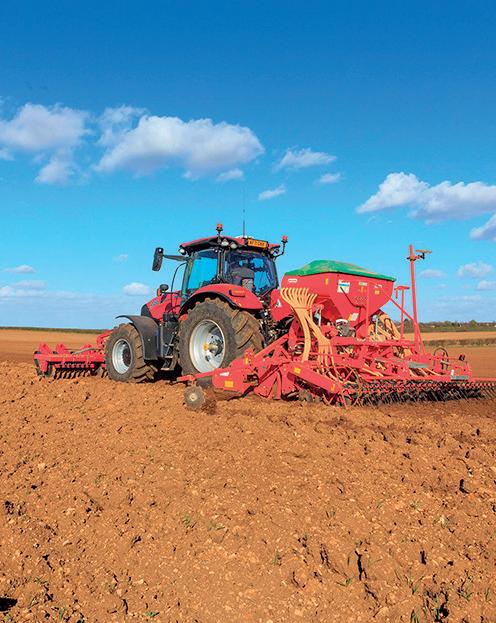
And finally...
With the public expected to descend on the countryside over the Bank Holiday, we are sending out press releases to regional and national media to remind walkers to keep their dogs on a lead.
WHAT a difference a week makes.
The better weather has not only brought with it an opportunity to finally get onto the land, but an air of positivity too.
Machinery finally came out of the shed (admittedly some of it got stuck soon after) and many farmers grasped the opportunity to get on and commence long overdue spring fieldwork.
Social media has been alive with pictures and videos of cattle being turned out after a winter that has felt like a lifetime.
And as we approach Easter and the key Islamic festivals, the sheep trade, as you would expect, is buoyant.
Our lead story this week also shows that with the sheep breeding flock in decline, coupled with rising export demand, prices could remain firm for longer. It is a fine balance which the UK is striking for now.
With Britain’s food security finally coming into focus in Westminster’s corridors of power,


Government and retailers have been clamouring to throw their weight behind British production.
It can be no coincidence that on the same day dozens of tractors rolled through London to demonstrate in Parliament Square, Defra capped the amount of land that can be taken out of production in the Sustainable Farming Incentive.
While by some it will be seen as the Government once again flip-flopping its way through the formulation of the new agricultural policy, others will see it as policymakers being agile and listening to feedback as they strive to develop a scheme which balances environmental protections with food production.
As governments break for the Easter recess, let us hope the industry’s message is finally getting through and that Ministers across all nations return to their desks with a renewed determination to help British agriculture thrive long-term.
From all at FG, we wish our readers a very happy Easter.
‘It is rewarding to have a positive impact on-farm’
Childhood: Ihaveaveryproud farmingheritagewhichspansover fivegenerationsinBedfordshire.
Mygranddad,now87,stillloves farmingandhelpstokeepour24-hectare familyfarmgoing;thearablefarmstill operatesathreshingsystem.
Asachild,Ilovedbeingoutdoors duringharvestandIrememberthe communityaspectofitall,when everyonecametogetherand celebratedfarming.
Afterschool,Iwouldgetstuckin helpingoutonthefarmwhilemostof myclassmateswouldgohometositin frontofatelevisionwithouthavingany responsibilities.
At16,Ithoughtaboutstudying criminologyorbusiness,butneverreally understoodwhatIwantedtodo.Itisso hardtosuddenlydecidewhatyouwant todowithyourlifeatsuchayoungage.
Aroundthistime,Ialsoreceiveda
diagnosis for dyslexia which affects howIabsorbinformation.
Forinstance,tofullyunderstand something,Ineedtoreaditatleastfour orfivetimes.Atthetime,itmademefeel differentandthatIdidnotbelong.
Determination: However,Ididnotlet itstopmefromachievingmygoals.
Withmypassionfortheoutdoorsand mynaturalabilitywithproblemsolving, Ibeganaveterinarymedicinedegreeat theUniversityofSurreyandhavenever lookedbacksince.
IdidaplacementwithHampden Vetsforfourweeksduringmylastyear ofstudyand,thankfully,madeagood impression.Theyofferedmeagraduate positioninSeptember2022,andithas beenmyhomeeversince.
Theteamhasbeenoneofthemain reasonswhyIhavebeenabletogrow anddevelopinmycareer.
Theykeepmyspiritsupduringsome

difficulttimes,andwereallydobounce offoneanother.
IamalsochairofSilsoeYoung Farmers’Club,whichisbothaprivilege andanhonour.Theclubwasactually foundedbymygranddad,sothefamily connectionrunsdeep.
Career: Beingavetisanarduousand demandingrole.Thejobcanbevery lonelyattimes,andyoucanbecalled outalltimesoftheday.
Thereisnothingworsethanwhen thingsgowrongon-farm,andithasa profoundeffectonyouasavetbecause youfeelthefarmer’spain.
Itcanplayonyourmindforweeksor
Sally Kitchiner, 24, is a veterinary surgeon at Hampden Vets. She is from Shillington in Bedfordshire.
evenmonths–youoverthinkifyoucould havedonethingsdifferently,anditcan beupsetting.
Worthwhile: Infarming,youhaveto makelotsofsacrificeswhiletakingup ahugeamountofresponsibility.
Despiteitall,farmersaretheloveliest peopletoworkwithandtheyreally dolookafteryou.Theymakethejob worthwhileanditisveryrewarding whenyouhavehadapositiveimpact onafarm.
Everyday,wearesavinglives,and farmersareveryquickatspotting problemsbeforetheygetoutofhand. Iwouldnotwanttoworkinanyother industry.
MORE INFORMATION
If you would like to be featured, email chris.brayford@agriconnect.com
NEIL Parish’s letter (March 22) was excellent and timely.
We as farmers ‘can do both’ –produce food and enhance biodiversity. We have to remember many of our bio-diverse habitats are man-made – hedgerows and stone walls to manage sheep and cattle, canals to transport coal, iron and pottery and even motorway grass verges and reclaimed slag heaps.
The Norfolk Broads were created by centuries of peat digging.
Maybe trees have been over venerated and grassland under valued.
A recent study by Dr James Weber, of Sheffield University, says: ‘trees produce tiny particles called aerosols which can act as greenhouse gases’.
Grassland absorbs and recycles millions of tonnes of C0 2 and produces millions of litres of oxygen as a by-product. The climate change industry has become political and does not seek to educate the public about natural biogenic cycles.
No-one wants monoculture – 90 per cent of agricultural land should be used to produce food economically, the other 10 per cent should contribute to biodiversity – and should receive public money for doing so.
This 10 per cent should include hedgerows, stone walls, woodlands, old fashioned hay meadows, ponds, grazed parklands, rough grassland, bird seed field margins and managed nesting sites, or even a maximum of 10 per cent of solar panels.
If farmers and environmentalists could work together we could
Contact us
■ IF you would like to send us a letter for consideration, please note that our email address has now changed to fgeditorial@agriconnect.com



If you have a classic picture you would like to share, please email it to marcello.garbagnoli@agriconnect.com
indeed do both and England could be a blueprint for other nations.
Jesse Bostock, Biddulph, Staffordshire.
THE letter by the chair of National Parks England in reply to John Thorley’s Farming Matters article ‘National Parks Bring No Benefits’ (March 1) , extolled the financial benefits to the parks.
Much of that money pours into the coffers of tourism businesses, the National Trust and the Royal Society for the Protection of Birds. Tourism is promoted above all else, but not farming.
Most farmers in the National Parks would agree with Mr Thorley
about all the bureaucracy stifling their enterprises. Their great knowledge of how to care for their land and the environment is ignored by Natural England and Defra, resulting in flawed and often unworkable environmental schemes.
The latest environmental schemes are going to leave most upland farmers much worse off and, with many considering quitting, our landscapes and food security will deteriorate further.
Suzanne Greenhill, Bishops Cleeve, Gloucestershire.
AMY Wilkinson’s In Your Field column (March 15) struck a cord with me, particularly the bit about her
discussion with Charlie Flindt regarding chubby, ginger kids, becoming witty kids.
I am not sure if I am witty, but as a mature ginger-haired Cornishman, my colouring has been my ‘trademark’ for the past 77 years.
I too, started off as a chubby, ginger kid, not really athletic, until at the age of 15 and six feet tall, I discovered rugby. This was a game-changer for me, excuse the pun, and I too grew a personality.
I never had to train to keep fit because, like Amy, there was always cattle to handle or in my case, sheep to catch.
All my life I have been known as ‘Ginger’ or ‘Ginge’ to everybody and I would not have changed a thing. Redheads be proud.
John Hart (Ginge), Via email.

provided to us by filling in the form on our website www.fginsight.com OR printed form when entering the Competitions. If you have entered the Competitions via our site we may also collect some technical information about how you use our site, for example, the type of device you are using, your operating system, IP address, uniform resource locator (URL), clickstream and length of visit. How we use the information you provide: We will use your personal information: • to administer the Competitions, on the basis that the use of your personal data for this purpose will be necessary to enter you into the competitions and, if you are successful, contact you to notify you of your prize; and, • if you are new to Farmers Guardian and where you have agreed to this, to provide you with news and updates from time to time about our services; and, if at any point in the future you do not wish to receive any news and updates from us or from, you can unsubscribe from our marketing list at any time by following the steps below. To unsubscribe from any communications using the link on the email we send you or by emailing us at dataprotection@farmersguardian.com. We will not use your information for any purposes except those listed in this policy without letting you know and getting your permission, if necessary, first. Who do we share your information with? We will not disclose your information to any third parties without your consent, except where: • it is necessary to enable any of our staff, employees, agents, contractors, suppliers or commercial partners to provide a service to us or to perform a function on our behalf; • we have a legal obligation to disclose your information (for example, if a court orders us to); or • there is a sale or purchase of any business assets, or where Farmers Guardian or any of its group companies are being acquired by a third party. Where we use third parties as described above to process your personal information, we will ensure that they have adequate security measures in place to safeguard your personal information. For how long do we keep your personal information? We keep your personal information for 36 months for the purposes for which it was collected or for any period for which we are required to keep personal information to comply with our legal and regulatory requirements, or until you ask us to delete your personal information. Your rights: You have a number of rights in relation to your personal information. These include the right to: • find out how we process your personal information; • request that your personal information is corrected if you believe it is incorrect or inaccurate; • obtain restriction on our, or object to, processing of your personal information; • ask us not to process your personal information for our own marketing purposes; and • obtain a copy of your personal information which we hold about you. We will take steps to verify your identity before responding to your request and will respond as soon as possible and in any event within a month. If you would like to exercise any of your rights or find out more, please email us at dataprotection@farmersguardian. com. Complaints: If you have any complaints about the way we use your personal information please contact us at dataprotection@farmersguardian.com and we will try to resolve the issue. If we cannot resolve any issue, you have the right to complain to the data protection authority in your country (the Information Commissioner in the UK). If you need more information about how to contact your local data protection authority please let us know. Contact us: Please read this policy carefully and if you have any questions, concerns or comments about this policy or, specifically, how we might use your personal information, please contact us by email at dataprotection@farmersguardian.com.
THE Labour party had lost connection with the countryside at the previous election, failing to give rural and farming communities the respect they deserve – something the Shadow Defra Secretary openly admits to.
Speaking exclusively to Farmers Guardian, Steve Reed said he hoped to turn that around before this year’s General Election and was determined to ‘win the connection back’.
Mr Reed said he was on a mission to ‘give farmers their future back’ –a bold statement which promises a lot to the industry. But the question remains as to whether this Labour Party has got a detailed enough plan to get that all-important rural vote.
With some record swings in rural by-election seats over the past few months, it has not gone unnoticed
Sirthat the Labour Party has started to ‘get a hearing’ in the countrysidesomething it has not experienced for a couple of decades. But Mr Reed stressed the job ‘was not done yet’.
When probed on what would be the minimum number of rural seats he would want in the next General Election, there was a definite reluctance to give an exact figure.
Instead, he wished ‘for a majority to be able to form a Government’.
“At the last election, we had only three MPs elected in rural seats. But in 1997 and 2001, we had a majority of rural seats,” Mr Reed said, adding that a Labour Government would listen, respect and work in partnership with farmers and producers, ensuring they played a valued part in decision-making.
“We have a package which is going to put money directly into the pockets and bank accounts of farmers and producers, whereas
At the last election, we had only three MPs elected in rural seats. But in 1997 and 2001, we had a majority of rural seats STEVE REED
this Government has undermined them.”
When asked what the plan was to get the farming industry back on track, Mr Reed kept on script and did not deviate from his party’s fivepoint plan, which included renegotiating a veterinary agreement with the
LABOURpartyleaderSirKeirStarmer saidBritainmust‘takebackcontrol ofournationalenergysecurity’, withapublicly-ownedcleanenergy companywhichhesaidwould‘get Putin’sbootoffourthroat’aspart ofhisparty’sambitionforamore ‘patrioticeconomy’.
MrStarmersaidakeypillar ofa‘modernBritisheconomy’was asecure,homegrownBritishenergy, addingthiswasabasicdutyof Governmentanditwas‘unpatriotic fortheConservativestoopposeit’.
TheLabourleaderwasinNorth Walesthisweek(March25),where hejoinedthenewWelshFirstMinister VaughanGethingtopromote‘Great BritishEnergy’,whichwouldcreate jobsandcutbillsforfamilies,including farmingfamilieslivinginrural communitieswhohavebeenhit hardbyincreasedenergyprices.
MrStarmersaidtheseplans wouldbea‘legacyofthenextLabour Government’,addingthepotentialfor offshorewindwasenormousinWales andthathewasexcitedtoworkwith MrGethingastheyentereda‘newera’.
EU to help remove trade barriers for UK farmers; to focus on public procurement following the likes of France and Denmark to get more local food in schools and hospitals; the introduction of a public sector sustainable energy company - GB Energy - to reduce farmers’ bills; cutting planning from years to months; and the creation of a flood-resilient taskforce.
On the agricultural budget, Mr Reed failed to give a concrete answer. Instead, he pointed out that the party’s so called ‘new deal’ was already fully funded.
He said: “I have outlined an entire new deal for farmers which is not going to cost anything more, but will shovel in total billions of pounds into the bank accounts and pockets of our producers.”
Throughout the interview, Mr Reed took a noticeably careful approach to his answers, not wanting to give too much detail away – per -




haps learnings from his party’s previous campaign mistakes.
Mr Reed’s go-to defence, when asked about improving uptake on agri-environment schemes, dealing with tenant issues and land being taken back to hand, was to criticise the Government’s failure to publish an impact assessment.
He said a Labour Government would commit to publishing one.
Mr Reed added: “I will publish it because I have always thought the more open you are with your data, the more eyes there are on a problem and the more likely you are to resolve it.”
At a troubling time for parts of the tenanted sector, with claims of farmers being ‘turfed off’, Mr Reed said he understood the worries, and despite hearing anecdotally the issues, he would need to see the impact data.
When questioned if he was in favour of a Tenant Farming Commissioner, he said in principle it ‘sounded sensible’, but that he needed ‘time to work it out’.
As a lot of these issues concerned the management of land, Mr Reed said he was confident a land use framework could make a difference.
He said: “We have a limited amount of land for the size of population we have here. And there are a lot of things we want to do with it.
“Food production obviously is an absolute priority, but so is clean energy generation.
“There would be a framework which decisions could be judged
against so we can make sure we have put enough land in use for food production to meet the requirements we have.
“The same for energy, the same for housing and the other purposes we have. I would much rather have a strategy, than take ad-hoc decisions one by one.”
When asked about Welsh Labour’s proposed Sustainable Farming Scheme, Mr Reed acknowledged there was a ‘clear problem’, adding ‘we have no intention of copying what has happened in Wales’ and that proposals ‘must make sure farmers can do what farmers do best and that is food production’.
On the subject of whether a tree planting requirement, which has again proved unpopular in Wales, would be introduced across England under Labour, Mr Reed said: “We have not published our manifesto yet and we do not actually have a target for tree planting.”
But he said it was something which ‘needed to be negotiated’ with Government and the interests of different groups which care about the land.
Tackling bovine TB and the badger cull was another area of concern for many farmers under a Labour Government.
Despite being challenged on further delays to the vaccine and whether countries would accept cattle with the vaccine, Mr Reed said he was going to stick to the ‘multi-pronged approach’ in the Godfray review and would ‘focus



evidence that the badger cull is effective. Godfray proposes that it should be phased out over time.

“But what we are not going to do is come in and end the existing licences.”
Mr Reed has now been in this role for more than six months and said the passion and care for what farmers do is what ‘really sings out’.
down’ on getting the vaccine over the line.
He said: “There is not scientific
He added if Labour got into Number 10 and he was asked, the Defra Secretary was the job he would want.





THE Scottish meat chain is at risk of being rendered ‘uncompetitive’ in comparison to the rest of the UK due to hikes in Food Standards Scotland (FSS) costs.
From April 1, the provision of official veterinarians (OVs) will rise by 20 per cent, with the cost of meat hygiene inspectors (MHIs) rising by 17 per cent.
Ian Bentley, president of the Scottish Association of Meat Wholesalers (SAMW), described the increases as ‘excessive and unacceptable’.
He said: “The Food Standards Agency [FSA] in England and Wales is, in contrast, raising its OV rate by 4 per cent and MHI rate by 10 per cent, leaving both charges well below the levels our members are being required to pay.
“If the FSS increases are allowed to stand without any abatement, they will impact our businesses, the staff our members employ and the wider farm-based rural economy from which we draw our raw materials.”
Mr Bentley said SAMW had discussed the issue with senior staff at FSS and written to the Scottish Government Minister for Public Health, Jenni Minto, warning that

the planned increases ‘will have a detrimental effect on the industry’ to the extent of ‘jeopardising’ member businesses’ ‘competitiveness and sustainability’.
“Individual members are shocked at the level of OV and MHI increases they are now facing, especially when compared to their own efforts to keep processing plant cost rises closer to the 4 per cent level which FSA is achieving,” said Mr Bentley.
One business owner said that they would never be able to negotiate a 20 per cent rise with their own customers.
DISCOUNT supermarket Lidl is set to increase space allocated to its own-label fresh chickens by 20 per cent above the current industry standard, the retailer has announced.
The company said it will increase its investment in its suppliers to ensure the commitment is ready to be introduced over the summer months.
The change will see the maximum stocking density reduced to
30kg/sq.metre and has been designed to positively impact the living conditions of the birds.
Richard Bourns, chief commercial officer at Lidl, said: “Animal welfare is a priority for us and we are dedicated to ensuring all animals within our supply chain lead good lives. This initiative is a testament to our strong supplier relationships and underscores our continued commitment to championing British food and farming.”
“We understand the pressures under which FSS has been operating, with its need to absorb the Scottish Government’s civil service wage rise of 7 per cent for 2023/24 and the introduction of a 35-hourweek from October this year,” added Mr Bentley.
“According to FSS, this equates to a cost recovery requirement of £424,000.
“Our members are perfectly happy for the Scottish Government
From page 1
Easter,”hesaid,withtwofour-day weeksaffectinghowmanylambs wouldbeprocessed.
“Theexportmarkethasbeen prettystrongtoo,”hesaid.
MrWaltonpointedtothe Spanishmarket,wherehistorically Spanishlambhasbeencheaper thanitsUKcounterpart.
Lookingforwardtotheperiod afterthereligiousfestivals,MrWalton expectednumberswouldsubside andtradewouldstaystrongat leastuntiltherewasanyquantity ofspringlambscomingforward.
“AlotoftheSouthhashadbig problemswithSchmallenbergvirus.

to take such steps, of course, especially if they can fund the increased costs. We just do not see why we should pay for them.
“The other major cost increase, as identified by FSS, relates to difficulties it has experienced in recruiting sufficient OVs and MHIs to operate the statutory controls in Scottish red meat plants.”
SAMW is calling for a postponement to the April 1 increases to allow the matter to be examined further, considering the increases were presented on March 7.
“Idonotthinknumberswillcome onthatsoon.”
Healsohighlightedtheweather, sayingithad‘neverbeensowet’, andaddedmanyfarmerswere ‘pullingtheirhairout’overdelays toturningoutlambs.
ThroughputdatafromDefrafor May2023toFebruary2024indicated thatatotalof10.2millionlambshad beenprocessedintheUKsofarthis year,whichwassimilarto2023levels, despitetheJunesurveyrevealing thelambcropwassome6percent smallerthanyear-earlierlevels.
THE extreme volatility farmers face has been highlighted by the latest farm income figures for Scotland, underlining the need for more certainty in the sector.
That was the message from NFU Scotland president Martin Kennedy who said the figures were ‘a mixed bag and illustrate the severe volatility that they routinely face, making it a constant challenge for long-term business planning and investment’.
“Farmers and crofters have not only faced significant volatility in output prices in the past two or three years, but also have endured extreme volatility in input prices for fertiliser, feed, fuel and energy in the same time period,” he said.
“While it was good to see that some sectors performed strongly during 2022, their economic performance has had a complete reversal over the
past year, whereas the outlook for other sectors has improved.”
The farm income figures showed average income increased to its highest level since 2012/13, after adjusting for inflation. Average farm income, a measure of farm profit after costs, was estimated to be £69,100 in 2022/23.
This is an increase of £14,600 on the previous year.
For the first time since 2012/13, when these records began, agricultural activity alone was profitable for the average farm, mostly driven by increases in cereals, milk, and livestock output, reflecting strong wholesale prices.
General cropping farms saw the strongest growth with average incomes rising by 83 per cent to £167,100, its highest value. Income for average dairy (£248,700), cereal (£99,700), and mixed (£85,700) farms were also at record values in 2022/23. However, income fell for livestock farms on average, with


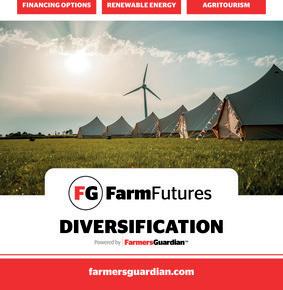





The latest farm income figures for Scotland highlight the need for more certainty over policy.
rising costs exceeding smaller increases in output.
Livestock farms continued to be more reliant on support payments to make a profit, with sheep farms in Less Favoured Areas the least likely to make a profit without support.
Mr Kennedy added this underlined the need for certainty in respect of
future policy and support and better and more consistent returns from the marketplace.
“Farmers must be able to make a reasonable profit from their core function of farming and producing food, otherwise there will not be an industry in the future and food security will be the casualty,” he said.




SALES of hay and straw are thriving, with outlets recording prices of up to £150 per tonne for barley straw.
According to the British Hay and Straw Merchants’ Association (BHSMA), big squared-baled barley straw stood at £88/t – a £38/t rise on last year’s price.
Big squared-baled wheat straw currently stands at £81/t, almost a third higher than its 2023 figure.
BEEF steaks remained a firm favourite on Valentine’s Day this year, but increased demand for lamb and chicken was also seen.
According to AHDB, beef steaks were a standout option, with overall volumes purchased in the two weeks ending February 18 up 7.6 per cent year-on-year.
Consumers were also seemingly less restricted by budgets, with shoppers switching to more expensive cuts from rump steaks.
Charlotte Forkes-Rees, AHDB retail and consumer insight analyst, said: “Lamb is not classically associated with Valentine’s Day; however, this year saw volumes purchased increase by 5.7 per cent and outperform the total meat, fish and poultry market.”
A key driver of this was the success of added value products, as well as a small increase in the volumes of stewing, leg roasting joints and mince purchased.
Chicken also saw volume growth, however there was a reduction in the number of shoppers purchasing chicken products compared to Valentine’s Day 2023.
Big bale hay has seen a more modest rise at £88/t, £5/t up on last year.
BHSMA secretary April Gingell said the stronger prices were to be expected following ‘a hard winter and a difficult spring’, but that supply remained good.
“We had anticipated strong prices after the past few weeks as many farmers pulled their winter crops in favour of beans and such. But there is certainly no need to panic. Crops are already drying out and things are looking better. There is actually a strong supply.
“What we do not want to see is a lot of talking up of prices which over-inflates them and can be very damaging for the market,” she said.
Ms Gingell added while exports to the European continent had slowed, trade with the Republic of Ireland had increased owing to its environmental policies which can see crop growers earn EU€250/ hectare (£214/ha) for incorporating the straw of oats, rye, wheat, or barley, and EU€150/ha (£128/ha) for incorporating oilseed rape straw in
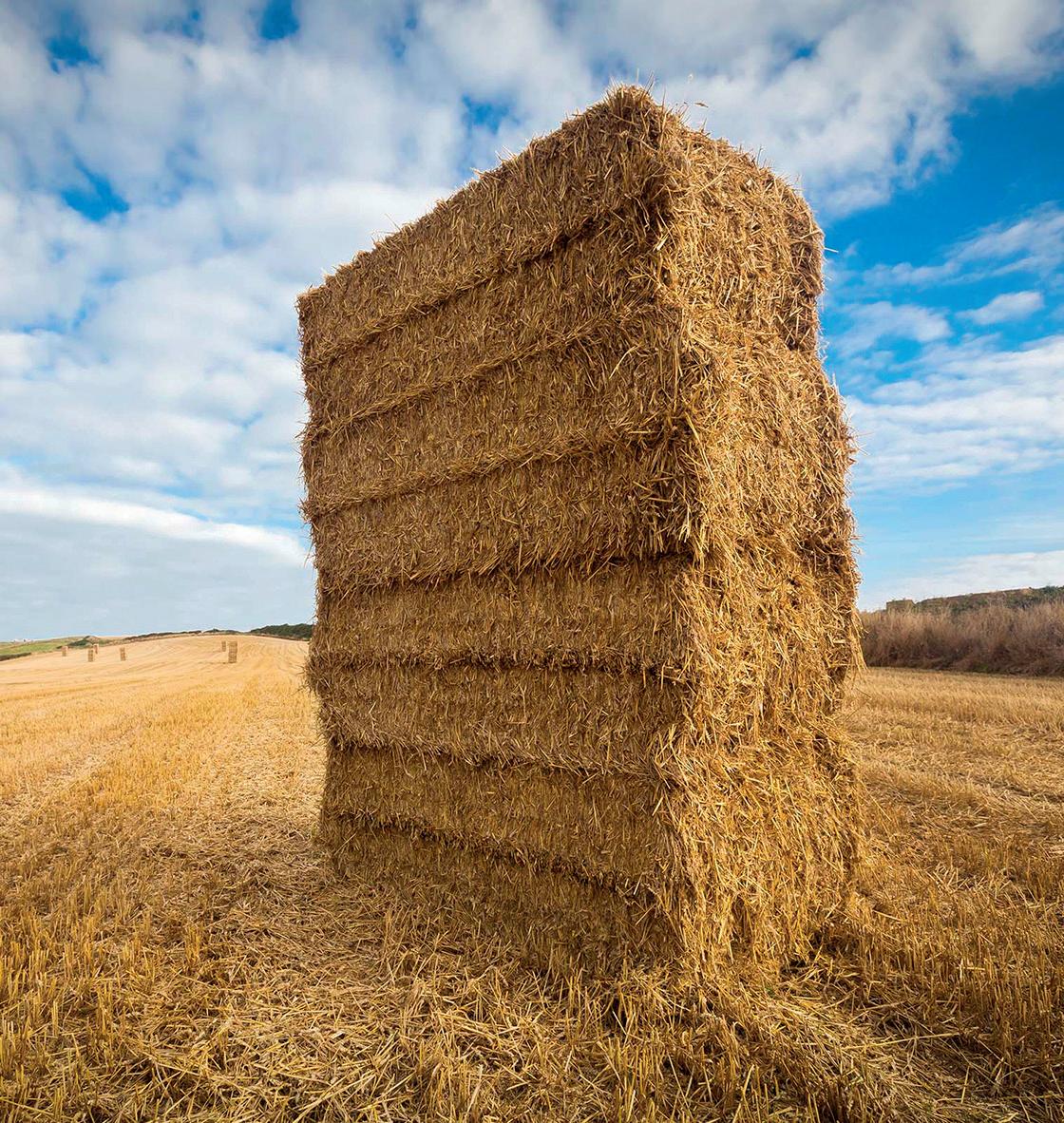
The extended period of wet weather has meant a price rise for hay and straw this spring.

order to boost carbon sequestration from the soil. This, combined with the heavy rains of winter, has had an impact on livestock farmers.
Roy Waller, auctioneer for machinery and agricultural produce at Ashley Waller Auctioneers in Lower Withington, Cheshire, said the past five weeks had revealed an ‘upward trend’.
“We are getting more entries to the auction and trade is improving. Last week we saw one load of barley straw reach £150/t and have also seen prices hit £160/t for hay £120/t for haylage.”
Ms Gingell said: “Hay and straw are not static markets and while prices are higher than they have
Crops are already drying out and things are looking better. There is actually strong supply
APRIL GINGELL
been for a couple of years, they have been higher in the past. A lot will depend on the next few weeks and, hopefully, a kind harvest.”
AN agricultural machinery business in Aberdeenshire has entered administration, with 24 members of staff made redundant.
Balgownie and Balgownie Rentals, with premises in Inverurie and Turriff, confirmed that the business – selling a range of agricultural machinery including tractors and livestock trailers – had entered administration on Friday (March 15).
Balgownie managing director Mike Singer said the board of directors had been ‘deeply saddened’ to announce that the
company, which has been open for business since 1907, had sought administrators with immediate effect due to ‘cashflow’ issues.
Richard Bathgate and Graeme Bain, of Johnston Carmichael, have been appointed as the joint administrators.
Both companies will remain closed to the public while the administrators undertake an assessment of the stock and asset position.
Despite this, Ifor Williams
Trailers has confirmed that its products and parts will continue to be sold at Balgownie to ‘avoid disruption’ for its customers.
Mr Bathgate said the company had made 24 members of staff redundant, while 17 employees had been retained to assist the joint administrators in marketing and selling the company’s assets during the transition.
He encouraged anyone interested in acquiring the business and its assets to contact Neil Woodgreaves, of Johnston Carmichael.
With discussions so far focusing on the benefits to Brazil from UK-Brazilian trade, Promar’s Edwin Reyes takes a look at opportunities for UK exporters. Farmers Guardian reports.
FOCUS on trade with Brazil has so far concentrated on the potential for Brazilian exports of beef and poultry, as well as fruit, coffee and soybeans.
Yet, there has been limited discussion of opportunities for UK exporters, said Promar agri food consultant Edwin Reyes.
He said: “At the moment, based on data from the Food and Drink Federation, Brazil does not feature in our top 20 export markets. A closer look at the key features of the Brazilian market might well suggest this is a missed opportunity to date.”
Brazil is a rising economic power and one of the world’s biggest democracies. In 2023, the Brazilian population was 216.4 million people, representing an increase from 2022 of 0.52 per cent. About 14 per cent of households have an income of more than £43,500 per annum.
In addition to the growing population, Brazil’s GDP in 2023 was about US$2.13 trillion (£1.69trn). This was set to increase to US$2.47tn (£1.96tn) by 2026, which would rank the country as the eighth largest economy in the world, according to the International Monetary Fund.
Despite macro issues in areas such as exchange rate volatility, Brazil has maintained its position as a major importer of agricultural products from the world and the largest importer in South America.
Consumer-oriented
Mr Reyes said: “This is the basis of any future UK export opportunities. In 2022, Brazil’s imports of consumer-oriented food products amounted to £4.1 billion [the EU accounted for 30 per cent of these], increasing approximately 20 per cent from 2021.”
UK opportunities could include dairy products, food ingredients, spirits, condiments and sauces, as well as confectionery, bakery goods and cereal-based products.
With 85 per cent of food consumed in Brazil undergoing some sort of industrial process, there could also be an opportunity for UK agri-tech


ards and being high-quality, which could benefit British exporters.
“There is a debate about this in both Brazil and the UK at the moment.”
Future engagement with markets such as Brazil, which is seen as a less traditional market to do business in, should be seen as positive EDWIN REYES
and food processing technologies.
The Brazilian food industry is well-developed and the presence of major multinational companies makes the sector very competitive.
Imported products from the EU, UK and United States do not compete with domestically-produced foods or Mercosur-origin products due to price, and are therefore likely to be positioned as a premium product. European-imported food is perceived as having high stand-
The Brazilian retail sector, with a revenue of £106.7bn in 2022, is the most important channel in the food distribution system. The industry is well-integrated, dynamic, and sophisticated.
However, distribution is still quite fragmented overall and includes various food retailing formats, such as neighbourhood stores, supermarkets, hypermarkets, cash-andcarry, and – in more recent years –the development of the e-commerce route to market. The French-owned Carrefour is by far the single biggest retailer in Brazil, but still only has a share of 15 per cent.
The foodservice sector is also an important industry, and sales via this channel were about £83.9bn in 2022.
Mr Reyes added: “As always when there are efforts to develop and grow trade partnerships with other countries considered as big/important players in the global food market, the main areas of discussion are around how the local industry could be negatively affected.
However, he said this could sometimes ‘cloud’ the significant opportunities the markets represented.
In Brazil, the UK is characterised as having a sophisticated business and industry which is able to compete in any market.
Mr Reyes said: “Future engagement with markets such as Brazil, which is seen as a less traditional market to do business in, should be seen as positive. This is especially at a time when the UK Government strategy is to open new markets in regions such as Oceania, Asia, and Latin America.”
He said that to succeed in the Brazilian market, aside from building relationships with key partners, identifying the most efficient ways to access the market was vital.
Mr Reyes advised that a mid- to long-term view of this potential needed to be taken by UK companies, adding it was not a ‘short-term proposition or market for the speculative in and outer’.
He added the size of the prize for those who took a longer term view was ‘clear to see’.









Thursday,


The British Farming Awards is back for 2024 and open for entries and nominations. The aim is to shine a light on the phenomenal work taking place across the industry and the driving forces behind it.
Now in its 12th year, the event is supported by Morrisons and will celebrate the diversity and resilience of UK farmers and their businesses.
Alongside core farming sectors – arable, beef, dairy and sheep – the awards, run by Farmers Guardian’s parent company Agriconnect, also recognise the importance of sustainable farming practices, innovations within agritech and those who have diversified successfully.
Crucially, the awards champion the role of family farms, new entrants and agricultural students – all of which are vital to the future of the industry.
The British Farming Awards welcomes nominations of businesses which have introduced positive changes, streamlined production and efficiency and adapted structures to tackle ongoing challenges presented by policy, legislation, the environment and volatile global commodity markets.
Sophie Throup, head of agriculture, fisheries and sustainable sourcing at Morrisons, says: “As long-term supporters of British farming, we want to thank farmers across the country for all the work they continue to do.
“That is why we are pleased to once again be supporting the British Farming Awards, recognising the effort, skills, care and innovation British farmers put into making and providing the food we all enjoy so much.”
OUR sector is brimming with people with the enthusiasm, dedication and talent to bolster British agriculture’s place as a world-leading food-producing nation and these awards are all about celebrating those people.
As well as providing an opportunity to celebrate among peers, this event also highlights the sheer commitment and drive of our farming community and shines a light on the often unsung heroes who make the industry tick.
XThe British Farming Awards is launching two new awards for 2024 – Agricultural Influencer of the Year and Agricultural Employer of the Year.
The introduction of social media influencers in farming is booming, with more and more farmers recognising the benefits of multimedia platforms.
The British Farming Awards
As with any busy job, it is difficult to appreciate how far you have come until you take a step back. But the British Farming Awards are a chance to do just that.
Many of our previous entrants credited the application process as offering a chance to reflect and think objectively about their business or product and what a successful future looks like.
As agriculture continues to go through major change, events such
aims to champion an influencer within the industry who is using digital mediums to raise the profile of farming, educate wider non-farming audiences on the challenges they face daily and the many triumphs British agriculture has to shout about.
The new Agricultural Employer of the Year award looks to celebrate
X The Farmers Guardian Farming Hero, sponsored by Eternit, is a prestigious award designed to recognise one individual’s dedication to the farming industry.
The award is given to a member of the agricultural
industry who has worked tirelessly for UK farming, either through delivering innovation, championing the needs for fellow farmers, spearheading change and/or promoting the industry to the wider public.
You can nominate someone you
as the British Farming Awards are more important than ever to shout about all the benefits farming provides, from shaping and preserving landscapes and habitats, to ensuring quality food is a mainstay on the nation’s plates.
 OLIVIA MIDGLEY Editor of Farmers Guardian
OLIVIA MIDGLEY Editor of Farmers Guardian
an agricultural organisation which goes the extra mile to support not only its employees, but also the community in which it operates.
The organisation will be actively attracting new talent into the industry and investing in developing its employees.
feel is working tirelessly for UK farming. They will not be notified that they have been nominated unless they are chosen as the winner of the award. This award is chosen by the British Farming Awards team and announced during the awards night.
For more information, go to britishfarmingawards.co.uk




















PREVIOUS WINNERS HAVE THEIR SAY
It feels wonderful to have an award from farmers, as we are farmers at heart and it is all we have ever wanted to do
Robert Nicholson
Cannon Hall Farm, South Yorkshire
Winner of last year’s Farmers Guardian Farming Hero


There are a lot of misconceptions about the industry in the wider public, so to show what we really do and the truth behind farming is really important
Holly Atkinson
Carswell Farm, South Devon
Winner of last year’s Farm Worker of the Year award
It is exciting and inspiring to see the energy in the room and so many farmers doing amazing things. Everyone here is so passionate
Alex Crawley
Grazing Management, Gloucestershire
Winner of last year’s New Entrant: Against All Odds award
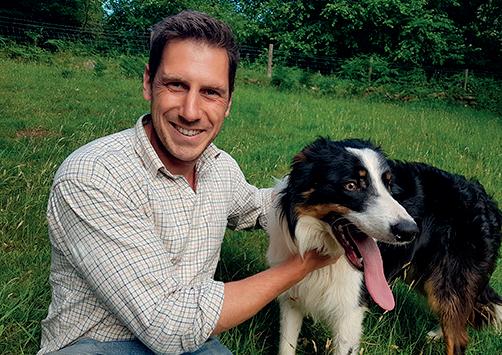





Last year’s winners celebrate together after winning their awards.

KEY DATES
MARCH 29
Entries and nominations open JUNE 21
Entries close AUGUST 1
Shortlist announced AUGUST 15
Judging and interviews take place
OCTOBER 17 Awards night




















Going it on her own has been quite the journey for 31-year-old Izzi Rainey.
After years of juggling jobs while also running her own highly successful textile business –which is based on-farm – she decided to solely focus on her farming business, with plans to increase its profitability.
Although Izzi has a loose farming background, she has had to find –and fund – her own way into the industry.
She says: “In a former life, which I do not remember, my dad was an accountant.
“My mum’s dad was a butcher and my great-grandpa – my granny’s dad – so I grew up going to market with my grandpa and things like that.
“But while my dad was still working, he started a hobby herd of Highland cows. He had always worked on farms at weekends as a child, and that is where he fell in love with it, but he never realised he could do it as a job.
“In 1994, we moved to Norfolk, and he bought a little farm called


Bates Moor, and that is when he thought: ‘Right, I am going to do this properly’.
“Me and my sisters grew up showing cows and had a pretty idyllic childhood.
“I remember saying at 16 years old that I wanted to farm, but it was squashed and I went to art college instead.”
Izzi attended Glasgow School of Art and set up a textile business
with a friend post-graduation, which is based on the family’s farm. With countryside-inspired prints and patterns, the business has gone from strength to strength and is still thriving now.
But when Izzi’s dad decided to sell the cattle, she could not let the idea of farming in her own right go.
“I did not want that to happen, so my dad gifted me three Highlands and sold everything else,” she says.
“In 2017, I introduced the Lincoln Reds, and in 2019, I wanted to turn this into something viable.”
Saying goodbye to the various jobs she had off-farm, she has built the herd up to a total of 90 cattle.


There are 18 hectares (45 acres) at the farm in Dereham, but she has also managed to secure a further 40.5ha (100 acres) in various locations, gradually investing in parts of the farm and building infrastructure. This has been helped along by a couple of grants, including a lump sum from The Henry Plumb Foundation.
She says: “I have re-fenced the whole farm and adapted everything. Dad had a small shed and two pens to rear calves, but I have put an 80-foot shed up. I also have a container which was built so the public can come on-farm and wash their hands.
“I am trying to secure more [land] because that is the one thing that sometimes buffers growing.
“To begin with, it was a bit of a worry because if you cannot find the grazing and the grass to make hay you are a bit stuck.
“We are in quite a heavily arable area, so everyone is vying for grass around here.”
Izzi is very passionate about her cattle. Lincoln Red heifers were purchased from the Yarn Hill herd in Woodbridge, and she has gone on to introduce bloodlines from Ancona, Houghton and Beverley.
With both the Highlands and the Lincoln Reds being native breeds, they work well on her extensive system and are hardy with good maternal instincts. However, the Lincoln Reds grow faster and are slightly better commercially.
The two breeds are run in separate herds, with both being put to a








■ A mix of Lincoln Reds and Highlands are run across a total of 58 hectares (145 acres) split between various sites
■ Cattle are sold straight to consumers through meat boxes
■ Pedigree bulls and heifers are sold through the farm
■ A flock of 20 Texel crosses was recently introduced, with plans to build this up to 60 next year

■ Lambing takes place in March and most of these will be sold though the market

separate bull of each breed. Calving takes place in spring, and most go through Izzi’s meat box business, with the Lincoln Reds finishing at about 650kg and the Highlands at 500-550kg.
Pedigree bulls and heifers are also sold from the farm – this is something Izzi enjoys and says she will keep investing in.
She adds: “Now I have got the numbers up, I want to build this side of the business. I am always trying to improve – selling bulls to buy better ones to create better stock.”
Izzi and her partner Dean have also recently introduced a small flock of sheep, spurred on by a conversation she had with a farmer where she keeps the cattle.
She says: “At one of the places I graze, the site is owned by the Countryside Regeneration Trust and one of their tenants said they were interested in this way of farming. I am interested in this too – a lot of my farming methods are this way inclined. I do not spray anything, and I am sympathetic to habitats.
“They mentioned introducing sheep and asked if I would consider it.
“I was a little worried; I had heard about blanket worming sheep and I was hesitant, thinking it would bring issues in because I try not to worm my cattle – they are really resilient, and it is for biodiversity reasons too.
“But it would bring in a different income stream, so Dean purchased a small number of shearlings.
“I said to him, though, that we were going to have go back and buy more, because if we were going to do this then we should go for it –if you can look after five, you can look after 20.”
A friend lent them a Beltex cross tup, and they have just completed
[Showing] is reassurance I am doing a good job. I have done a lot of this on my own for a long time and I really value people’s opinions
IZZI RAINEY
their first lambing season. Next year, they hope to lamb 60, and most of these will go through the market.
Izzi is also involved in numerous educational activities, including school visits and Highland grooming workshops. Last year, 190 people visited to help prep a Highland for the show season.
“It was scary, and I got the NFU to come and do a risk assessment for me,” says Izzi.
“But it has been a good addition – I do this anyway; I wash them and blow-dry them to get them ready for shows, so they are used to it.
“It has opened doors for me. Photographers have come to use my cows for photoshoots, and the council has approached me about cattle handling for Trading Standards courses on-farm, so it has brought in revenue streams.”
As the industry heads into show season, Izzi is gearing up to do what she loves most, having caught the showing bug early in life.
There is a photo of Izzi on the Bates Moor Farm website from


A small flock of sheep has been recently introduced on-farm, and the first lambing season has just been completed.


August 1998 at Aylsham Show, which is captioned: ‘It was the first time I had taken part in young handlers. I was over the moon to have come first with my Highland calf, Rufus, after months of training in the garden’.
Izzi says: “I filled in my first three entry forms last week, and the thing I love about showing is just getting off the farm. I know you are basically
still working when you are there, but I get so much satisfaction, and for me it is reassurance that I am doing a good job.
“I have done a lot of this on my own for a long time and I really value people’s opinions.
“Last year, I managed to sell two bulls, so it is nice to know you are doing a good job – as farmers, you do not really get that recognition a lot.”

In 2017, Izzi Rainey added Lincoln Red cattle to Bates Moor Farm’s herd.

Izzi and her partner Dean.


















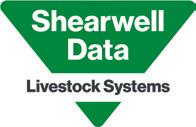





After an exceptionally wet autumn and winter spring drilling seems to be making a steady start, with growers on lighter land making use of the irregular dry weather windows. Ash Ellwood finds out more.



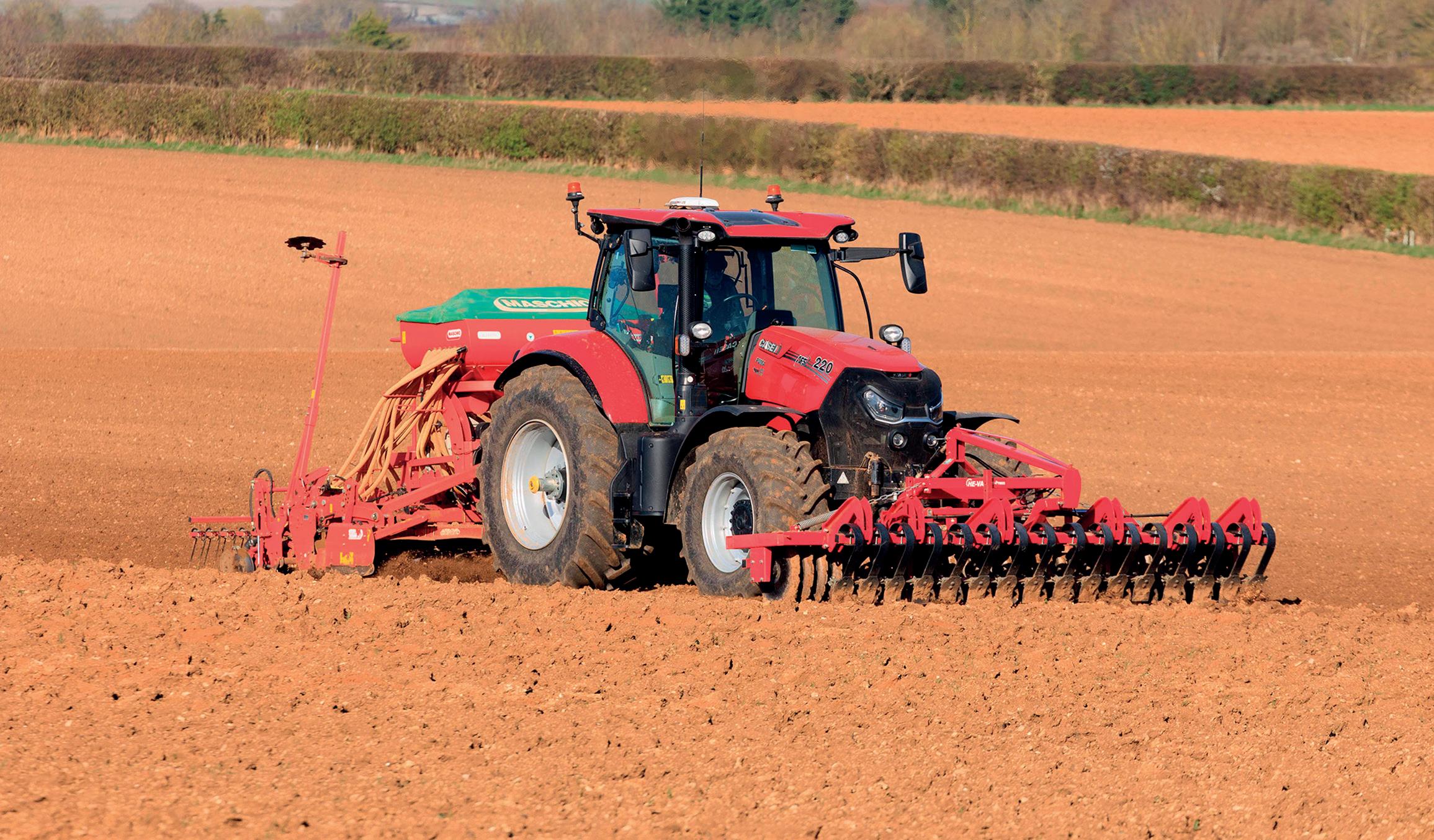
rGrowers on heavier soils advised to wait
FARMING on the Lincolnshire Wolds, estate manager Paul Barnes, of South Ormsby Estate, has managed to plant just short of 40 hectares of LSPB Lynx spring beans, after the dry weather window opened last weekend (March 23-24).
The farm standard seed rate of 60 seeds per sq.metre was used to aim for an establishment of 55 beans/sq.m, as the crop will go through a mechanical weeding process, so Mr Barnes adopted a slightly thicker seed rate to accommodate potential plant losses.
He says: “We have been fortunate to have a couple of dry days. The soil looks dry on top, but once you break the surface and get to any depth [the soil] is still looking a bit cold and wet.”
Based on an organic system, Mr Barnes uses a conventional plough as a mechanical control of weeds.
He says: “We have stuck with the same cultivation method this year, which enabled us to get the top off the soil, let it dry out and then go drilling.
“Overall, the beans have gone in well so far, we are fortunate that the particular field is free-draining.
“Once you come off the Wolds onto lower lying fields it is a different story.”
Covering Wiltshire and Dorset, independent agronomist Dan Dines says the dry weekend brought drilling opportunities to growers, particularly on greensand and chalky soil types, due to the soil’s light, free-draining and quick drying properties.
He says: “It is mainly spring barley that growers have planted locally, with the odd field of spring beans and spring oats.
“It has gone in okay on the whole, it has not been perfect planting conditions, but with the
small weather window offered –time will tell how the crops fare.”
Due to the challenging conditions, Mr Dines adds very few crops have been planted using a direct drill and most situations are requiring cultivations.
“Moving the soil is so important to enable it to dry out before planting.
“On soils that do not drain as freely – if there are a couple of small patches that are really wet when the rest of the field will cultivate, growers may be better off driving around and missing the small patches for the sake of getting the rest of the field established,” Mr Dines says.
Based within the South East, regional agronomist for NIAB, Keith Truett, says growers in the region have had brief respites from the wet weather, which has enabled those with lighter soils to make progress with drilling.
“There are some very good spring barley crops that established well in early February in east
Kent on soils over chalk or where conditions enabled drilling,” says Mr Truett.
However, at the other end of the scale, the heavy and poorly draining silts that are common for growers around the Weald are facing challenges even where soils have previously been cultivated.
He says: “Even if soils were moved to enable drilling, the seed has often rotted in the subsequently very wet seedbeds.”
For zero tillage growers on heavier soils, where the land often dries slower, Mr Truett says their only option is to wait for a longer dry spell to enable the soils to dry out prior to drilling.
“There are now alternatives in the shape of Sustainable Farming Incentive options which, if managed well, should enable better winter wheat production in terms of improved fertility and reduced grassweed burdens,” he adds.



THE UNDO Carbon trial, in collaboration with Newcastle University, is in its second year at Nafferton research farm, based just outside Newcastle.
In 2022, a spring oats crop had 20 tonnes per hectare of basalt rock dust applied with a conventional lime spreader, and promising results were recorded by the university trial combine when the crop was harvested.




With an ability to provide a 15 per cent yield increase, basalt rock dust is being investigated in trials at Newcastle University’s Nafferton research farm. Ash Ellwood reports.


Jez Wardman, chief agronomist at UNDO, says: “We saw huge agronomic benefits from the first season, including a 15 per cent yield increase in the spring oats compared with a control plot.”
The trial compared multiple sets of 12- x 96-metre plots, investigating the difference in yields and soil health between a plot with basalt rock dust applied and a control plot. Within


each rock dust plot, two cultivation systems – including ploughed and direct drilled – were also analysed.
First-year trial results suggested that major nutrients, such as magnesium, calcium, and potassium, could be accessed by the crop through the rock undergoing the weathering process when in the soil. According to
THE material used within the trial is an existing aggregate product produced by rock quarries when processing basalt rock for roadstone or asphalt. Up to 10 per cent of the overall material falls in the ‘less than 4mm’ category, which the quarries do not have much use for, says Jez Wardman.




Rock weathering is a natural process that happens on rock faces as mountains weather away. The CO2 in the atmosphere dissolves in the rainfall, forming a weak carbonic acid, and it is the carbonic acid that slowly wears the rock, he adds.

“As it wears away it creates bicarbonate ions, which are a soluble form of carbon, and that is the actual carbon capture mechanism,” says Mr Wardman.
Although the rock weathers on


Mr Wardman, 220kg/ha of potassium is reported to become available to the crop over a 20-year period.

the rock face, this process can take thousands of years. But when it is crushed down to a small size, it increases the surface area significantly; 1kg of rock will have a surface area of 1ha when crushed.
“This means that the weathering process that took thousands of years can now occur in 20-50 years, which is relatively quick for a geological process,” adds Mr Wardman.

“We are taking this existing product from the quarry – not changing it in any way – and applying it to agricultural fields to enable the weathering to take place quicker, farmers to reap the soil and crop benefits, and CO2 to be permanently taken out of our atmosphere.”




He says: “This process is not to replace fertiliser or lime, but it should be seen as a useful and nutrifying contribution that can also provide a carbon sequestration benefit.”
The pH levels of the plots were also either maintained or increased in areas with basalt rock dust applied, recording a 0.22 pH unit increase when evaluating treated with non-treated plots.
“We believe the pH and nutrient contributions aided the yield increase, meaning that the crop was potentially suffering from nutrient deficiencies.

“The pH will have allowed access to the nutrients, enabling a more efficient rooting system and creating contact with the released minerals,” adds Mr Wardman.


While UNDO’s main priority within this trial is to evidence the agronomic co-benefits of the material, the business’ mission centres around community-based permanent carbon sequestration.




the rock weathers and at what rate it can capture carbon within the soil.
Mr Wardman says: “20t/ha of material spread can capture up to 5t of CO2 over a weathering period of 20 to 50 years.

To measure the carbon sequestration potential, UNDO has developed a geochemical model that predicts how






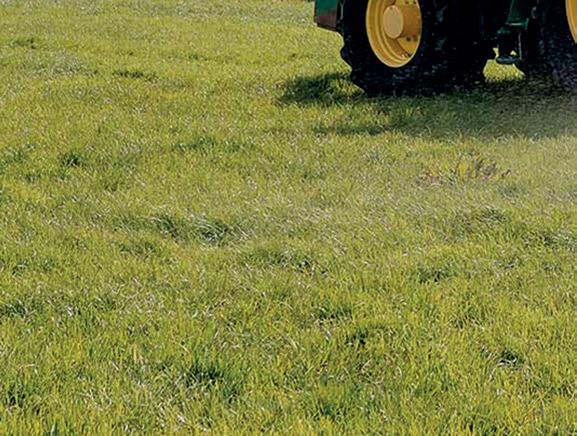

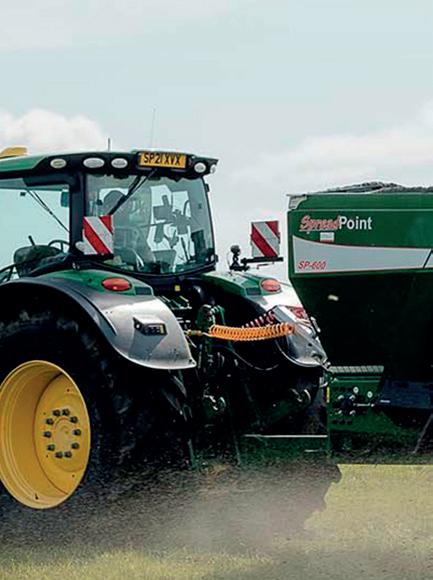


“The model predicts this, but we have set up trials in our operational areas to measure, verify and report how the carbon is being captured to confirm the model predictions are correct,” he adds.
For more information on the trials and future results, visit: un-do.com
The trials investigated agronomic benefits within spring oats, but the material can also provide benefits to grassland.




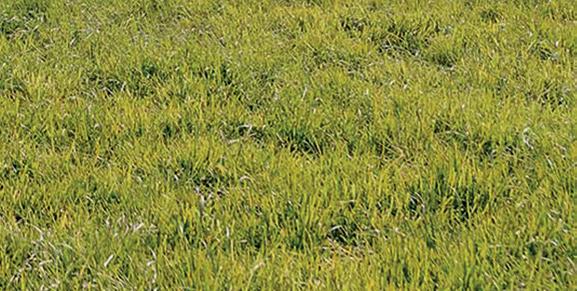

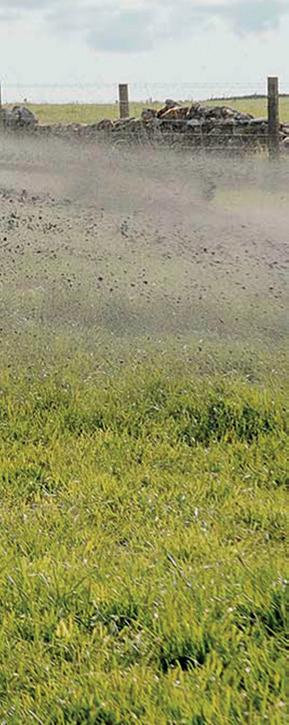







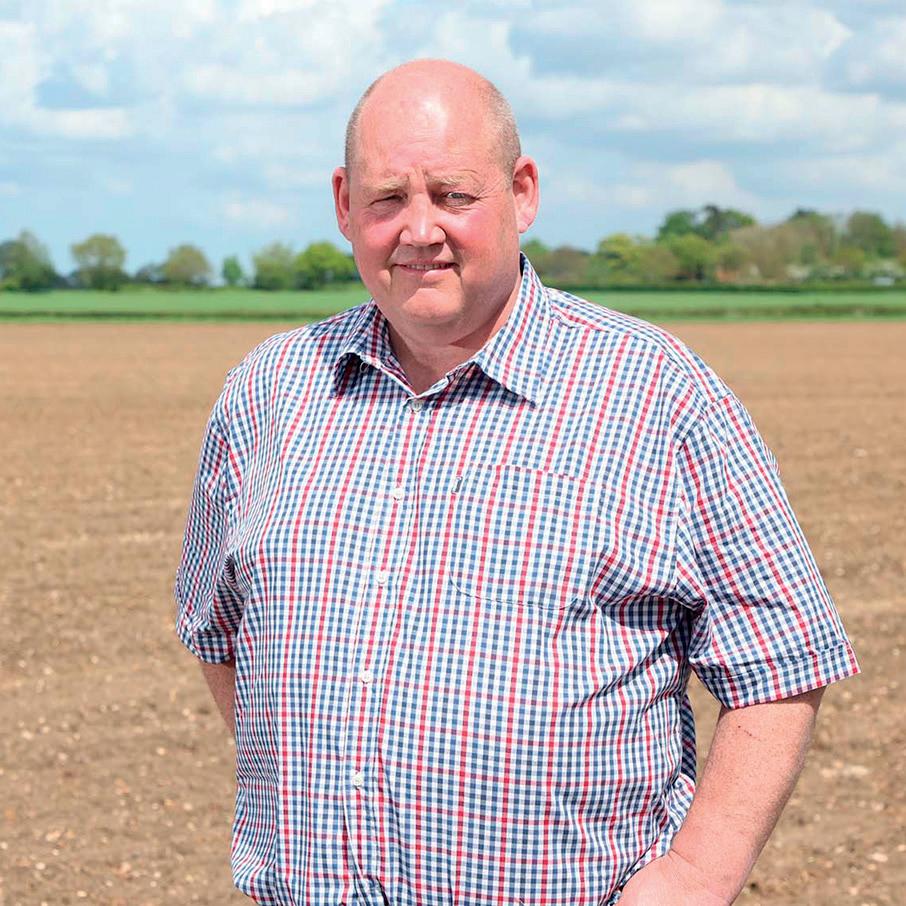



Morley Farms has a rich research history and a passion for developing practical results for farmers. Teresa Rush reports.
Norfolk farm manager David Jones is a man with a lot of questions.
Fortunately, he is wellplaced to find answers – as manager of Morley Farms, the commercial farming arm of The Morley Agricultural Foundation (TMAF) (see panel) , he is closely involved with the planning and management of one of the largest agricultural trials hubs in the UK.
Situated close to Wymondham in South Norfolk, 750-hectare Morley Farms hosts field trials for NIAB, the John Innes Centre and the British Beet Research Organisation, extending to more than 10,000 plots over an area of about 20 hectares. TMAF also funds its own programme of research, focused on soil management and improvement, and increasingly on air and water quality.
Farming is of course a long-term business; something that, for various reasons, is not often reflected in research. However, via Morley Farms, TMAF can support research projects examining the long-term impact of agricultural practices.
In autumn 2018, in conjunction with NIAB TAG, the foundation implemented the Morley Soil and Agronomic Monitoring Study (SAMS) (see panel). The project will investigate soil health and its impacts on yield, profitability and
resilience, and the intention is that it will run for at least 25 years.
Given this tradition of agricultural research and a commitment to sharing knowledge, combined with its ability to host multi-year research projects, Morley Farms is a natural successor to Suffolk farming business E.J. Barker and Sons as the AHDB Strategic Cereal Farm for the East.
Cousins Brian and Patrick Barker hosted a programme of trials and knowledge exchange at Westhorpe Lodge, near Stowmarket, between 2017 and 2023.
Last autumn, AHDB launched Morley Farms as the second Strategic Cereal Farm East, with the programme set to run between 2023 and 2029. As host farm manager, Mr Jones is aiming to bring context to farm trials, and continue TMAF’s commitment to bridging the gap between research and farming to help farmers make better decisions.
He says: “There is no point in doing research unless you are going to disseminate the results to the industry or the sector that needs them.”
Supported by a farmer steering committee, Mr Jones has recently set out the aims of the new six-year Strategic Cereal Farm East programme, together with the work that will be needed. A reduction
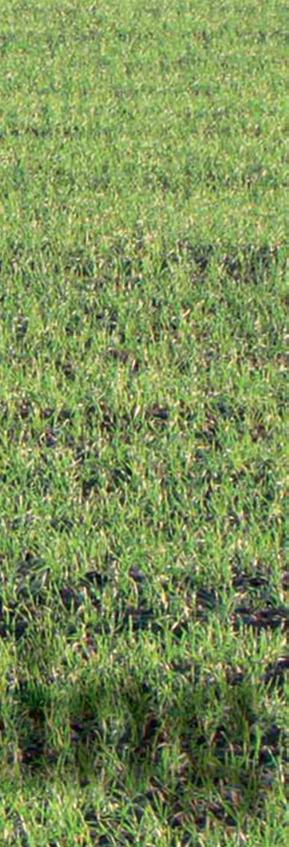


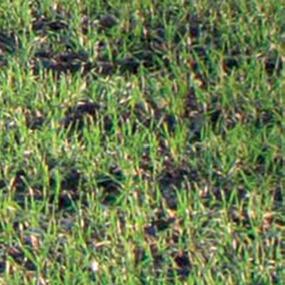

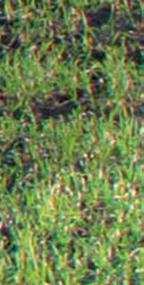


in inputs, while at the same time maintaining yields and quality, is top of the list.
The first year of trials and assessments will start to address three themes: cultural weed control strategies, with Italian ryegrass as a target; integrated pest management (IPM), with Barley yellow dwarf virus (BYDV) as a target; and efficient nitrogen use, with N as a target.
Ryegrass is a growing problem at Morley Farms.
The SAMS project is investigating soil health and its impacts on yield, profitability and resilience.

“We have a population of ryegrass that continues to elude me,” says Mr Jones, who is seeking to reduce ryegrass populations with less reliance on herbicides.
Field-scale trials will exploit variations in grass-weed pressure on-farm and will include:
■ Cultural control methods, including drilling date, seed rates and variety choice.
■ Non-chemical control methods –such as inter-row cultivation with a camera-guided hoe supplied by
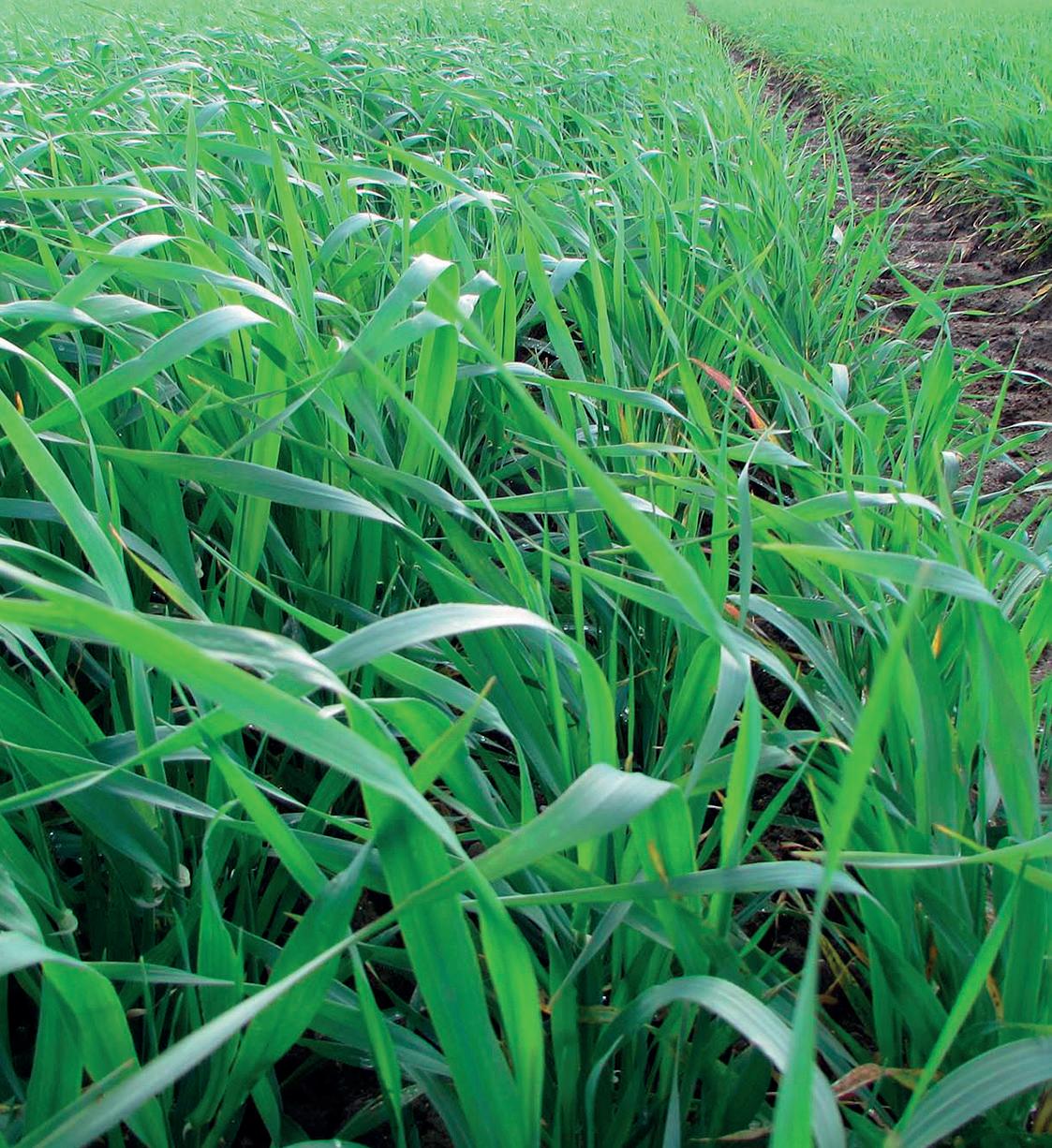

Garford Farm Machinery, and weed surfing with a Bionalan weed cutter – combined with cultural control.
■ Non-crop stewardship options.
Further work will see baseline weed seedbank measurements taken down through the soil profile and weed seed germination from soil layers measured to determine where viable ryegrass seeds are located.
The significance of any weed seed transfer across the farm via farm machinery will also be assessed. Mr Jones plans to collect ryegrass seed off the plough, drill, combine and baler, and see what grows on in a polytunnel. Many farmers will focus on cleaning the combine between fields, he says, but may never clean the plough, which could prove to be the bigger culprit when it comes to weed seed spread.
“I believe this sort of thing has never been done before in a measured way,” he says, adding that while results will vary from farm to farm, he hopes other farmers will be motivated to replicate the experiment on their own farms if the findings at Morley Farms can be shown to be of value.
Ultimately, he hopes to understand ryegrass better by identifying and filling the knowledge gaps associated with the weed.
He says: “A weed is a plant in the wrong place at the wrong time. It just turns out that we have created good conditions for these weeds to grow. But what can we do differently to create conditions that are less favourable to the

weed? That is the mindset to have –not ‘which herbicide works best?’”
The IPM work will assess aphid vectors and their natural enemies, as well as BYDV levels in resistant and susceptible winter wheat varieties.
It will also build on recent AHDB research to examine the role of decision support tools in reducing or eliminating the use of insecticides, with interest in the latter increasing after Defra’s introduction of a Sustainable Farming Incentive action (IPM4) worth £45/ha.
Treatments include:
■ Use of T-Sum model for direct assessment of second aphid generation.
■ Use of pilot ACroBAT model for direct assessment and treatment guidance.
■ No insecticide application.
The third research theme is nitrogen use efficiency (NUE). Analysis of 10 years’ worth of Morley Farms’ yield maps revealed a large degree of variation in yields across sites and seasons.
This finding was one of the key drivers behind the setting up of the Morley SAMS project, which is now into its sixth year and is already a valuable source of sitespecific soil, nutrient and yield data. NUE is being measured at some of the SAMS sites.
The Strategic Cereal Farm East NUE work will include assessment of variable rate application technology in the form of the Yara ALS1 N-Sensor against the current farm standard.
In a previous trial on the farm, the foliar-applied, controlled-release N fertiliser MZ28 had been compared with a traditional soilapplied N dose, applied at the final split.
To build on this initial work, a replicated tramline trial will seek to establish which approach delivers the best NUE.
“I found that our yields were as good as when we were using normal fertilisers, and I believe it works as a product, but we are going to test it out in a more robust way on some tramline strips,” says Mr Jones.
Grain near-infrared protein mapping has been used on-farm since 2022, and part of the NUE work programme will be to investigate the fertiliser N that is utilised and allocated to grain yield.
Carbon emissions are also now part of the N use equation, adds Mr Jones.
“If we look at these products that have a much lower carbon footprint, then maybe we can find a new sweet spot from a carbon point of view and an economic point of view,” he says.
Mr Jones is determined to think differently and motivate his fellow farmers and managers to do the same.
Commenting on the IPM project, he says: “I need to think like an aphid.”
He is only half-joking.
For more information on the four Strategic Cereal Farms (East, North, South and Scotland) go to: ahdb.org. uk/strategic-cereal-farms
THEMorleyAgriculturalFoundation isacharitywhichhostsand facilitatesscientificagricultural research,educationandtraining. Itsaimistopromoteeffective husbandrytechniquesforhighyieldingandprofitableagriculture withminimaleffectsonthewider environmentandecosystems.
MORE INFORMATION
Find out more at tmaf.co.uk
MORLEYSoilandAgronomic MonitoringStudy(SAMS)isalongtermproject(25years+)thataims tolinksoilhealthanditsimpacton yield,profitabilityandresilience.
TheMorleyAgriculturalFoundation hopesthattheprojectsanditsdata setswillbeusedbyother organisations,researchersand farmersasaplatformforexploring theinteractionsbetweencrops, soil,weatherandagricultural management,helpingto underpinsustainableagriculture forgenerationstocome.
INTERACTIVE MAP
SAMS data is available in an interactive map at tmaf.co.uk
TWO fresh pedigree heifers from the Aireburn herd of G.B. Moorhouse, Skipton, topped Gisburn’s dairy sale at £3,450 and £3,400 respectively.
Sale leader was a Cherry-Lily Zip Lister daughter from the Rilla family and the heifer at £3,400 was a Redcarpet-sired Miss America. Both sold to the same Lancashire buyer.
H. and V.E. Jolly, Great Eccleston, took a £2,600 bid from a Cheshire buyer for Fieldside Enid 12, a Nortonhill R2D2 daughter giving 37kg.
At £2,550, they also sold their 36kg Fieldside Diana 7 by Denmire Minefield to the same buyer, who also took a third Fieldside heifer by Peak Altamaui at £2,450.
Also making £2,450 and to the same buyer, was Airebank Renegade Gem from D.C. Hall, Coniston Cold.
Pedigree cows peaked at £2,320 for a 45kg third calver by Seagull-Bay Silver, from B. and J.M. Crowe’s Yewbarrow herd, Grange-over-Sands.
Leading the 26 non-pedigree heifers at £2,420 was an entry from N. and K. Forshaw, Preston.
796

rAkaushi Wagyu
heifers lead online sale
THE first Akaushi Wagyu cattle to be offered in the UK sold for 10,500gns to top the Global Connections online sale hosted by Harrison and Hetherington.
The sale leader was the heifer K Honey 300173, a Heartbrand Terminator daughter out of Rapid Bay Towa, from South West Wagyu, Bude, which sold to Messrs Lee, Kidwelly, Carmarthenshire.
South West Wagyu also sold
AVERAGES
Pedigree newly-calved heifers, £2,320; pedigree newly-calved cows, £1,962; non-registered newly-calved heifers, £1,755; in-calf heifers, £1,810. Auctioneers: Gisburn Auction Marts.

SKIPTON’S online sale of working sheepdogs topped at £19,100 for Mirk, a two-year-old dog from Dewi Jenkins, Ceredigion.
A grandson of Mr Jenkins’ dog, Jock, with which he won the international supreme championship trials in 2022, it sold to Monty Motto, Shetland Islands.
Making £5,000gns was two-yearold Fern, from S. Massey, Dumfries, which went to Ross Clark, Dumfries.
Adam Ledgar, Cheshire, sold the one-year-old bitch, Vicky, for £4,300 to H. Chapman and Son, Carnforth.
Part-broken dogs topped at £6,500 for Hilltop Stan, from David Wood, Derbyshire, which sold to Karen Karkow, USA, who also paid £1,100 for
an unbroken pup from Carol Mellin, Oakworth.
Aran Jet, a nine-month-old partbroken bitch, a granddaughter of Mr Jenkins’ Jock, from John Bell, Howden, made £4,200 to Elaine Hill, Holmrook.
AVERAGES
Fully broken bitches, £3,202.50; fully broken dogs, £4,546.50; 5 partbroken registered bitches, £1,701; 2 unregistered part-broken bitches, £1,155; 10 part-broken registered dogs, £1,706.25; pups – 2 registered bitches, £1,680; 1 unregistered bitch, £525; 2 registered dogs, £708.75; 1 unregistered dog, £525. Auctioneers: CCM.
L Cheesecake 300194, an April 2023-born Heartbrand Raymond Terminator daughter out of Rapid Bay Akaibara, for 10,000gns to the same buyer.
Distinct marbling
Akaushi Wagyu is known as the Emperor’s breed, renowned for its distinct marbling and did not exist outside of Japan until the 1990s.
Leading the trade for dairy heifers at 3,000gns was the All Breeds All Britain Jersey champion, Blythbridge Chocochip Reagie from Blyth Farms, West Linton.
This November 2022-born Avonlea Chocochip daughter sold to Messrs Millar, Kirkpatrick Fleming. Selling at 2,800gns was Panda Alpha O Kiwi, an October 2023born Blondin Alpha daughter from Panda Holsteins, Cumleigh, which sold to Messrs Tinney, Co Donegal.
AVERAGES
2 Akaushi Wagyu heifers, £10,250; 11 Holstein, Jersey, Brown Swiss and Guernsey heifers, £2,204.55; 38 Holstein embryos, £675. Auctioneers: Harrison and Hetherington.

Breaghey Netflix 22, from Andrew Clarke, Tynan, which sold for 5,800gns to Richard Houston, Rostrevor.
THE December 2022-born Simmental bull, Breaghey Netflix 22 from Andrew Clarke, Tynan, Co Armagh, made 5,800gns to lead the breed society sale at Dungannon.
By Woodhall Ferrari 14, and out of Breaghey Vida 2, a Dermotstown Delboy daughter, it sold to commercial producer, Richard Houston, Rostrevor.
Selling at 4,600gns was the pre-sale show champion, October 2022-born Craigy Neo by Keeldrum Gamble 15, from W.J. Dodd, Ballynahinch, Co Down. The buyer was Raymond Bowden, Stewartstown.
The Dodds also sold another Gambler son, Craigy Nash 22, for 3,200gns to Eric Speers, Hamiltonsbawn, Co
Armagh, and two Craigy heifers also by Gambler sold for 2,700gns, and 2,600gns respectively.
The reserve champion, Ashland Nobleman by Omorga Volvo, from P. Kelly, Ballreagh, Tempo, Co Fermanagh, was knocked down for 3,400gns to Neill Donaghy, Co Londonderry.
Also at 3,400gns was Bridgewater Farm Newry, a Auchorachan Hercules 16 son, from J.N. Glasgow, Cookstown, Co Tyrone, which sold to Kathleen Kearney, Downpatrick.
AVERAGES
10 bulls, £3,580.50 (+£505.50 on 2023); 2 heifers, £2,782.50.
Auctioneers: Dungannon Farmers Mart.

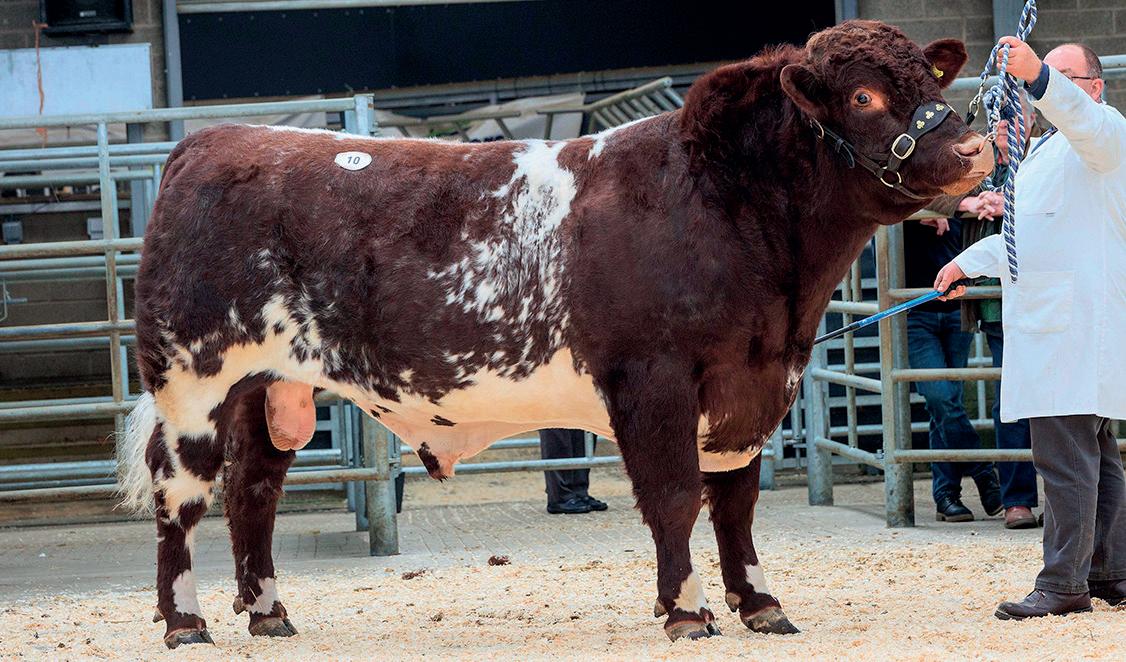
THE Farmers Guardian-supported pedigree multi-breed show and sale at Melton Mowbray topped at a centre record of 10,000gns for the Lincoln Red champion.
This was Holegate Bandit, a twoyear-old bull by Sharlock Extreme out of Donnington May 4 from Ed Middleton, Spilsby, which had been male champion at Nottinghamshire and Royal Norfolk shows last year. It was knocked down to the judge, Graham Parkinson, Donnington on Bain. Brackenhurst Beretta, a two-yearold Lincoln Red bull by Auchmacoy Xeno consigned by Nottingham Trent University, sold for 6,700gns to R.I. Clough, Spilsby.
Iken Hall Farms, Woodbridge, sold Yarn Hill Bandit, a two-year-old son of Walmer Yara for 5,500gns to Severalles Farms, Newbury.

To find out where we will be next, go to farmersguardian.com/mth-roadshow
Lincoln Red females topped at 2,500gns for Chestnut Tree Mattie, an April 2022-born maiden heifer by Beverley Samson from T. Green, Irnham.
Beef Shorthorn bulls sold to 8,000gns for two-year-old Podehole Solomon by Podehole Magician out of Podehole Madeline Lisson from the Horrell family, Peterborough, which went to Gates Farming, Oakham.
Beef Shorthorn females peaked at 3,250gns for three-year-old Langhams Rianna Broadhooks and its bull calf from A. and C. Farms, Oakham, with heifers from the same home selling to 3,100gns.
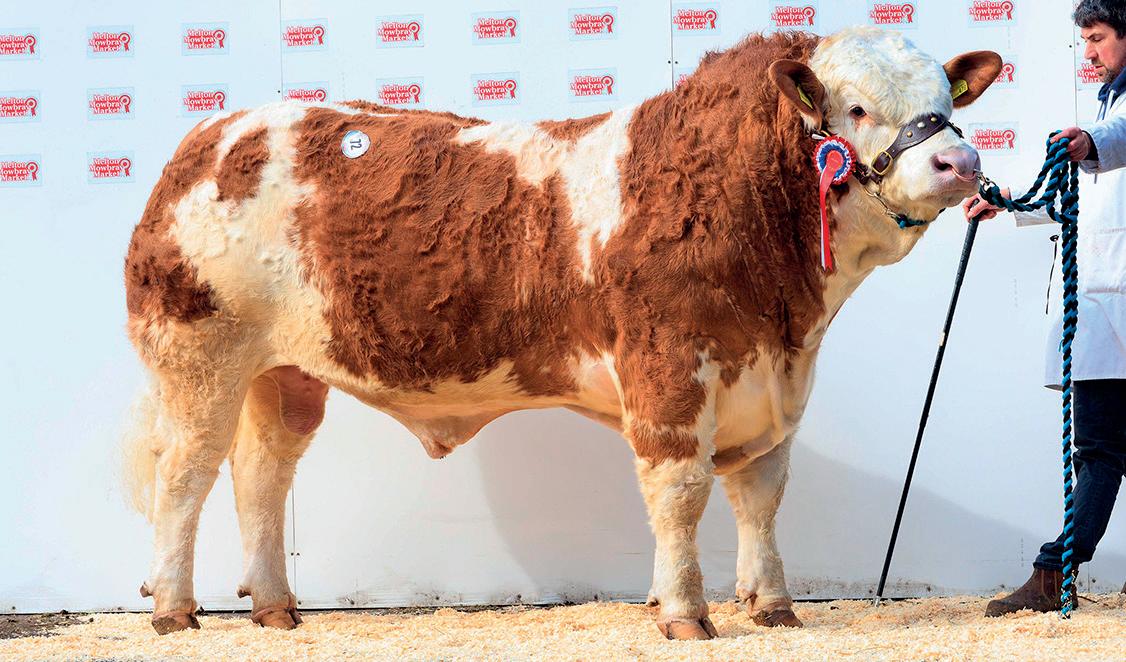
Reserve inter-breed and Simmental champion, Scotland Hill Newman 22, from Tom Hill, Doncaster, which sold for 5,000gns to A. Hurn, Norwich.
The reserve inter-breed and Simmental champion, Scotland Hill Newman 22, a two-year-old bull by Clonagh Mighty Ab Fab from Tom Hill, Doncaster, topped the section at 5,000gns selling to A. Hurn, Norwich.
Aberdeen-Angus bulls sold to


There

3,300gns for Wensleydale Black Bert Y`07, a son of Gretnahouse Blackboot from C.D. Timm, Pickering, which sold to Wilfred Bothwell, Stretton.
The inter-breed and Salers champion was Seawell Selector by Omarsy from P.M. and S.M. Donger, Towcester, which was unsold through the ring.
Commercial bulls topped at £4,000 for a Limousin cross British Blue from Ben Beckitt, Newark, which sold locally to Rob Mason.
Auctioneers: Melton Mowbray Market.
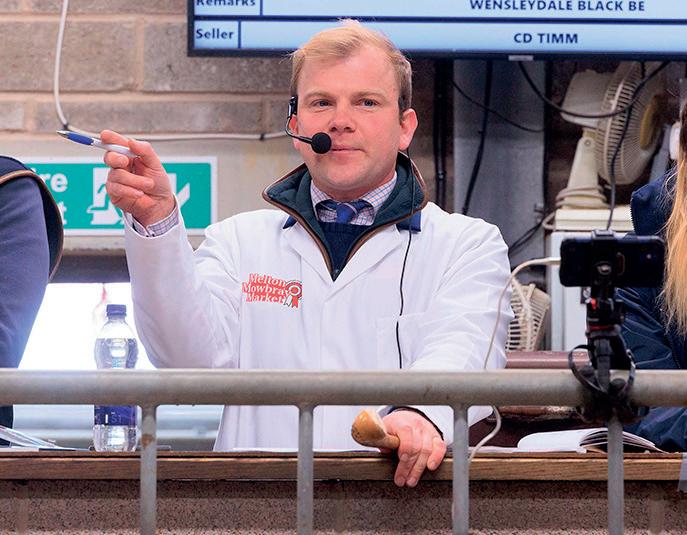

A 10-month-old British Blue cross heifer – shown by Rathamell Young Farmers’ Club (YFC) member, 17-year-old Thomas Capstick, Swinden Moor – won the championship in Gisburn’s young handlers’ overwintering competition.
The steel grey heifer, bred by Susan Lord, Littleborough, had been bought at Gisburn last autumn. It won the best presented heifer and best female in Thomas’ age group, before going on to take the top award. It sold to Martin Wilcock, Ashton-in-Makerfield, for £1,700, leaving a £300 margin after a 1.0071kg daily gain.
The judges, Michael Everett, Goole, and last year’s winner Katie Aiken, Wennington, chose as reserve champion a black yearling Limousin cross heifer from 19-year-old Pendle YFC member Freddie Shorrock, which had been second best female in the 16to 26-year-old group. It sold for £1,550 to Isaac Sharpe, Paythorne, leaving a £560 margin, having achieved a daily gain of 0.8857kg.
Topping the daily gain figures at 1.5206kg was a British Blue cross steer from seven-year-old Olivia Bretherton, Blackburn, which had stood third in her age group.
Achieving a daily liveweight gain of 1.4964kg was a 12-month-old Blue
AT Bentham’s East lamb show and sale, the championship went to Rosie Wilson, Grafton, with her 48kg Beltex cross lamb, which sold for £255 to Liam Broster, on behalf of Worsley Wholesale Butchers, Liversedge.
Dan Stainthorpe, Saltburn, took second prize with a 44kg Beltex cross, which made £224.
Robert Towers, Ingleton, showed the best of the Charollais lambs,
with 46kg lambs at £240, just ahead of Charles and Valerie Marwood, York, with their best, a 54kg lamb, at £232.
Overall spring lambs averaged 413p/kg. The 6,526 hoggs averaged 380.6p/kg, with 1,147 hoggs selling for more than £200, topping at £265 for A.L. Thompson, Foulridge, with the supreme hogg.
Auctioneers: Richard Turner and Son.
AT Lancaster’s sale of ewes with lambs at foot, aged Texel ewes with Beltex cross twin lambs from T.R. Gorst, Bay House, sold to £310, with other twins from the same home to £295.
A Texel ewe with a single Beltex lamb from the same home sold for £290, with their other singles to £270 twice.
H. Swales, St Michaels, saw his best aged Texel ewes with singles sell to £260. A run of broken mouthed Mule ewes with young Texel twins from Myerscough College sold to £235.
At the Easter show and sale

cross steer from Ribble Valley competitor, 11-year-old Freddie Taylor, Balderstone, which sold at £1,450, leaving the second highest margin of £530.
Winner in the YFC member section was Aire Valley club’s Lucie Culpan, Queensbury, with her 16-month-old Charolais cross heifer, which had been the best presented heifer in her eight- to 12-year-old group. It gained 1.0649kg/day and sold for £1,100, leaving a £310 margin.
Sale leader on price at £1,800 was 16-year-old George Webster,
Scarisbrick, with a 15-month-old 522kg Limousin cross steer, which had a daily gain of 1.142kg and left a margin of £230.
The Best Newcomer Award attracted 19 entrants. Junior winner was 14-year-old Thomas Thornber, West Bradford, who sold his 10-month-old Limousin cross heifer at £1,120, giving him a £190 margin.
The senior winner was 15-year-old Emma Burnop, Pendleton, who sold her British Blue cross steer at £1,200, leaving a margin of £250.
Auctioneers: Gisburn Auction Marts.
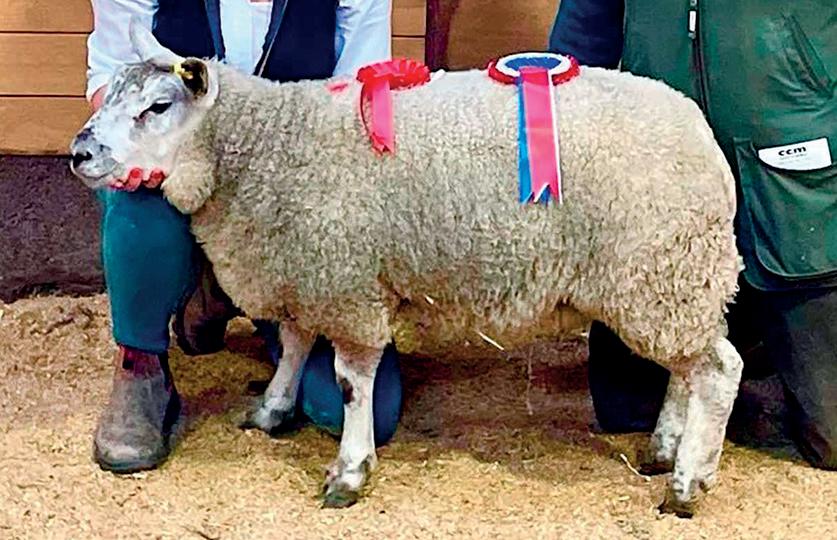
Champion, a 48kg Beltex cross lamb, from Rosie Wilson, Grafton, which sold for £255 to Liam Broster, on behalf of Worsley Wholesale Butchers, Liversedge.
of spring lambs, the first prize and champion rosette went to a Charollais cross Beltex from R.J. and J. Towers, Ingleton, which sold for £215 (500p/kg).
Topping the spring lamb sale at £220 was a Charollais cross also from Messrs Towers.
Suffolks sold to £170 from S. Wilson and Son, Scotforth, with Dorsets from the same home to £166. Auctioneers: North West Auctions.
April 1. CO DONEGAL, Charityopenand intermediatetrialinaidoftheKevinBellRepatriation Trust,Bavin,Kilcar,CoDonegal,F94EK88,bykind permissionofWilliamandLiamGallagher,8am start,entriesontheday.
April 21. CO MAYO, Opensheepdogtrialsinaid ofMayoRoscommonHospice,heldatPortagh, MayoAbbey,Claremorris,CoMayo,F12XC64,8.30am start,threeormoredogsby10am,twoormoreby 11am,entriescloseat12noon,contactMichaelor MaryHopkins,tel:0868590482or0876116376.
April 1. HOLME, Opentrial,CloughHead, Haslingden,BB44AT,8.30amstart,enteron field,contactShirley,tel:07980545437.
April 20. AVON VALLEY, OriginallyMarch16 trialbutpostponed,morningandafternoonsessions, 30dogspersession,what3words:foster.vanish. originals,LE176DH,bykindpermissionofFrank
andDeeHodgkin,limitoffourdogsperhandler persession,samedogscanrunineachsession, £8perrun,cateringavailablethroughouttheday,preenter,contactCaileigh,tel:07860716467,entriesonly acceptedonreceiptofpayment,entriesfortheoriginal trialwillautomaticallybetransferredtothenewdate.
April 6. LLYWYNBEDW, Llanpumsaint,Carmarthen, SA336JU,8.30amstart,spectatorswelcome. GARNDOLBENMAEN, NorthWalesSheepdog SocietyAffiliatedSocietiesTrials,Opentrialonly, LL519AJ,8amstart,tel:07876552285.
April 13. POWYS, OrwerthDaviesMemorialTrial, heldinBrecon,contactA.Prothero,tel:07795178 451,email:anna_prothero@hotmail.com.
April 20. FFOS Y FRAN, heldinCarmarthen, contactA.Prothero,tel:07795178451,email: anna_prothero@hotmail.com.
April 27. LLANGADOG, heldontheoldracecourse fieldsonA4069towardsLlangadog,pre-entry required,contactC.Price,tel:07815289410.
THERE was a good entry of spring lambs at the Farmers Guardian-supported Easter show and sale at Market Drayton which averaged 532p/kg.
The overall championship went to the winning single lamb, a 41kg Beltex from Liam Swinnerton, Cheswardine, which went on to sell for 840p/kg (£344.40) to the judge, Jeff Plant, of Plant and Wilton Butchers, Newcastle-under-Lyme.
The second prize-winning single lamb, a 42kg Beltex from Madders and Johnson, Hopton, made 660p/ kg (£277.20) to W. and G. Yates, Yarnfields.
The winning pair of lambs, weighing 38.3kg each from J.R. Pimlott, Hookgate, sold for 720p/kg (£275.15) to Mr Plant.
The second prize pair, 37kg lambs, from P. and C. Swinnerton, Adbaston, made 595p/kg (£220.15) to Vivers Scot Lamb, Annan.
Commercial lambs sold well, topping at 630p/kg (£266.80) for 36kg lambs from Claire Tomlinson, Agden.
The 2,917 prime hoggs on offer averaged 390p/kg, with lightweight topping at 386p/kg (£122.75) for

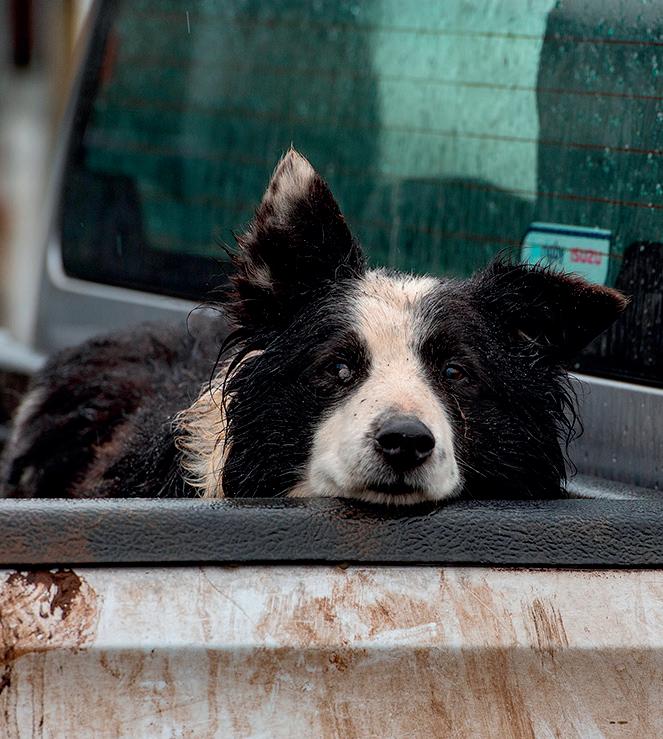

To find out where we will be next, go to farmersguardian.com/mth-roadshow
31.8kg hoggs consigned by A. Jackson, Gawsworth. Standard weights sold to 453p/kg (£175.31) for 38.7kg hoggs from P.R. Jones, Ranton.
Medium weights topped at 509p/kg (£214.29) for 42.1kg hoggs from D. and J.M. Williams, Basford, with heavies to 450p/kg (£212.85) for 47.3kg hoggs from Madders and Johnson.
Top price per head was £277.50 for a 75kg hogg from T.M. Evason, Sharpley Heath.
Cull ewes peaked at £200 for a Beltex cross consigned by Madders and Johnson. Rams sold to £180 for a Texel from Eamonn Vaughan, Springwood.
Auctioneers: Barbers.
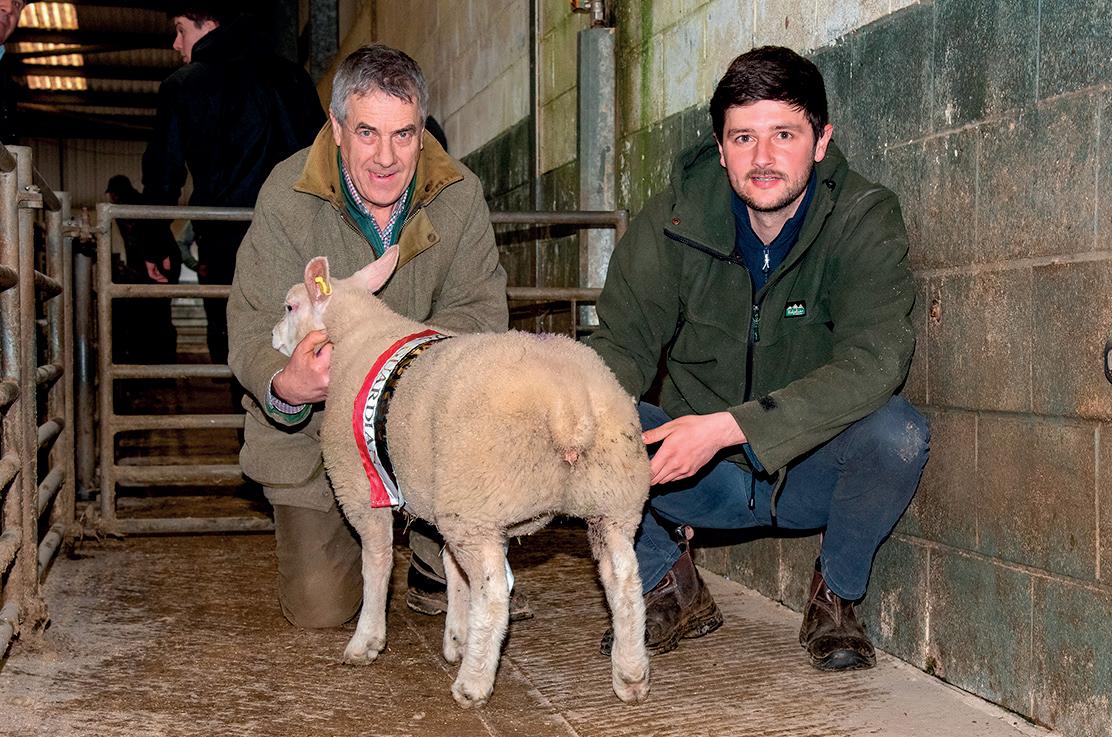
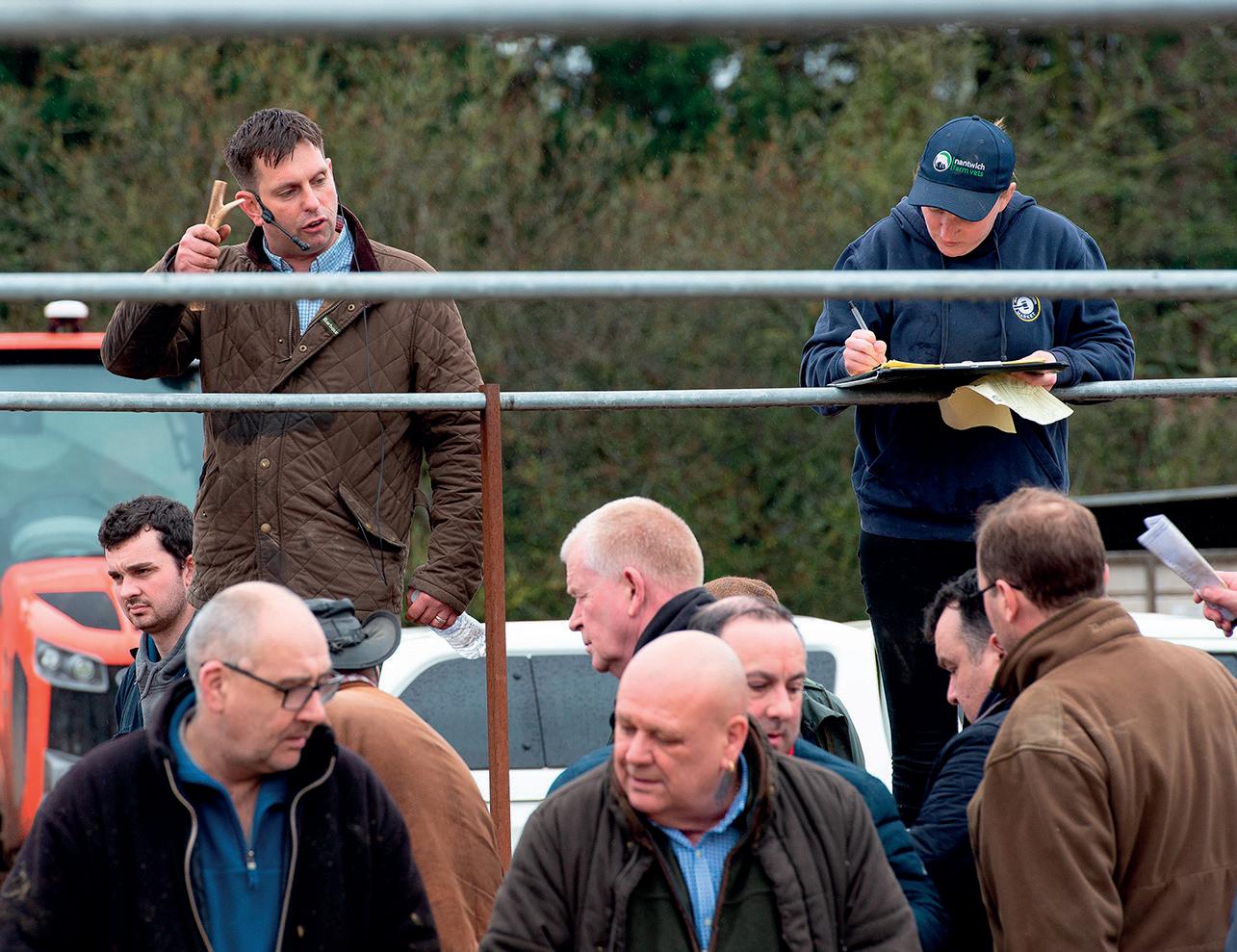


Future-proof your farm business, gain insight and exchange knowledge with a FG Farm Futures membership

Included in your membership:
52 magazines a year
Farmers Guardian delivered directly to your door every week including full digital access. Plus, check out our brand-new features exclusive to FG Farm Futures members.











Insight – Quarterly, in-depth, analytical reports into the latest agricultural trends, from diversification, to climate-friendly farming and understanding the latest grants available.
Exchange – A series of digital events focused on learning from real case studies and exchanging knowledge with agricultural thought leaders


Weekly Digest email – From the desk of FG’s editor every Sunday morning, gain insights into how the week’s news impacts your business.
Members’ Lounge – Enjoy an exclusive space for members to network at leading events, such as LAMMA, CropTec and Farm Business Innovation.






















































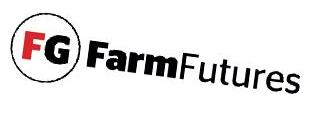













































Friday 5th April
35/40 DAIRY CATTLE, Spring Show & Sale.

Wednesday 3rd April
8am - Sale of Cast Ewes and Rams followed at 10am with Prime Hoggs (Prime Hogg ballot 10am).
Monday 8th April
Sale of Store Cattle and Feeding Bulls of all classes. Entries close Noon Tuesday 2nd April.
Wednesday 10th April
2pm - Opening Sale of Ewes & Hoggs with Lambs at Foot Entries close Noon Wednesday 3rd April.
www.penrithauction.com

AT LOUTH LIVESTOCK MARKET LOUTH, LINCOLNSHIRE, LN11 9HF
FRIDAY 5TH APRIL

In milk cows & hfrs; i/c cows & hfrs & bulling hfrs. Judging 12.00 noon. Sale 12.30/1.00pm.
Store Cattle Show & Sale at 10.30am.
Entries noon Mon 1st April.
With Junior Store Cattle & Rearing Calf entrants. 120 Rearing Calves & Stirks at 11.00am
FARM SALES NOTICE
Edgley Park, West Burton. Saturday 20th April.
Sale of two tractors; large amount of workshop tools, collectables and sundries. Small quantity of farm machinery.
Low Houses Farm, Low Row, Swaledale.
Saturday 11th May.
Dispersal of Farm Machinery etc.
Details through office or website “Catalogues”
Enquiries: 01969 623167
www.leyburnauctions.com

1st SPRING STORE CATTLE SHOW & SALE 400+ HEAD EXPECTED TO COMMENCE AT 12 MIDDAY
FRIDAY 19TH APRIL
2nd SPRING SALE OF STORE & BREEDING CATTLE TO COMMENCE AT 12 MIDDAY
MONDAY 6TH MAY
SHOW & SALE OF EWE & LAMB OUFITS
REGULAR MONDAY PM MARKETS WEEKLY ENTRIES INVITED
Call Ed Middleton on 07395 570303
Catalogues and entry forms available online Closing date for all sales: 5pm on Wednesday before the relevant sale
www.louthmarket.co.uk

Mark Lee: 07980924179
Simon Lamb: 07815 188125
Ryan Spackman: 07725 653542
Mark@nortonandbrooksbank.com



Dispersal sale of the milking herd together with in calf heifers, the property of Hollands Farms Dorchester Ltd. A truly superb herd of modern and highly productive Holsteins and certainly a herd capable of being compared to some of the top breeders herds. If classified the vast majority would be VG / EX as a guide on the conformation throughout. Exceptional production of 11,520kg 3.92fat 3.24pro SCC150. All cows housed in cubicles and milked 2x daily. All year calving with large proportion due through the Summer months. OVER 100 SELL IN THEIR 1st & 2nd LACTATION!! Pregnancies to top sexed sires along with beef. High health status being BVD free, Lepto & IBR vaccinated. Rigorous Johnes screening over many years. Recent full herd TB clear with good TB history. A hidden gem of superb modern cows and highly recommended!! Sale in conjunction with Symonds & Sampson. Live on Marteye. Transport available to all parts of UK.

Tuesday
Thursday
Saturday
Wednesday
Tuesday


Saturday
Thurs


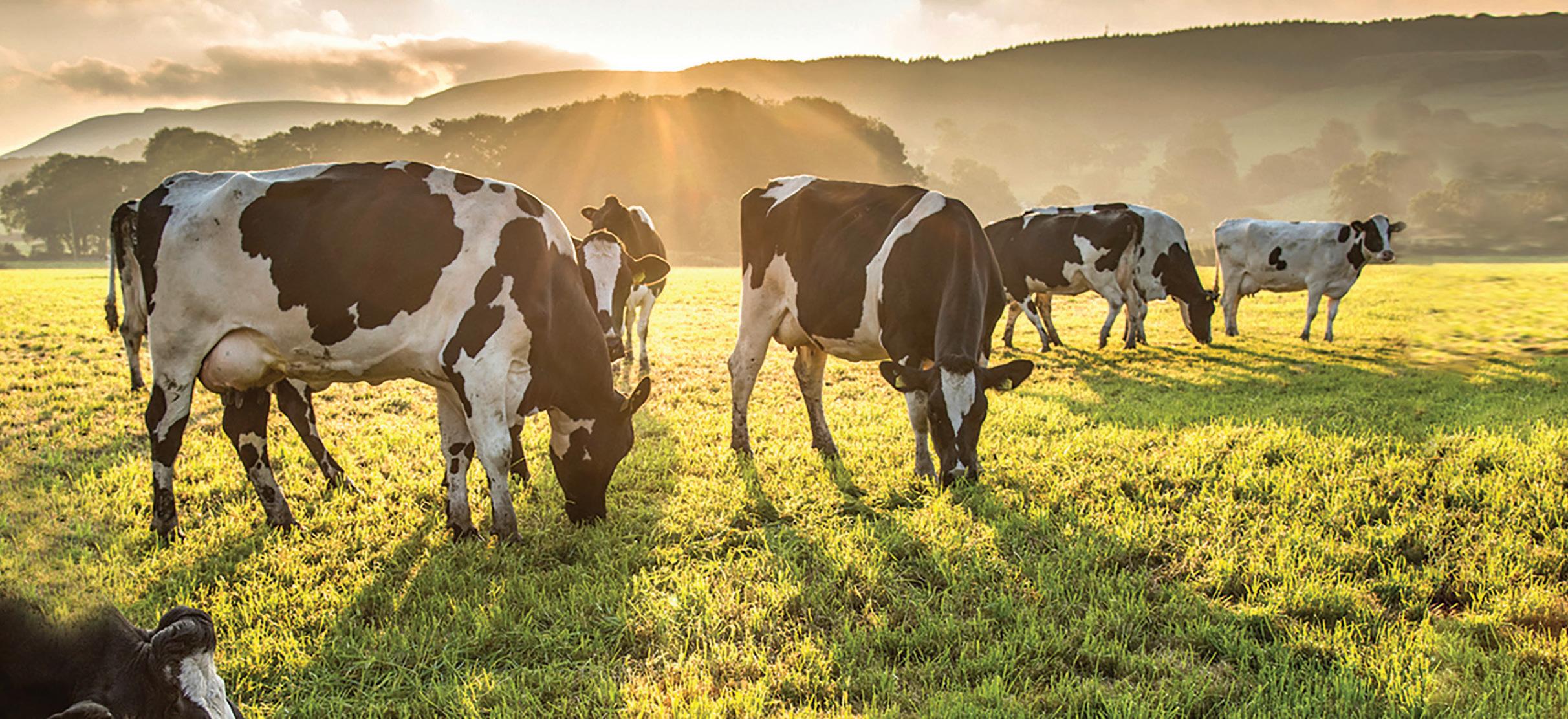
Farmers
Thursday 4th April
10am
10.30am 100 CAST / OTM CATTLE
To include: 14 Pedigree Aberdeen Angus Heifers & 6 Pedigree Luing Heifers (Fit to Bull)
Wednesday 8th May PEDIGREE SHEEP DAY
Sale for Pedigree Ewes with Lambs & Gimmer Hoggs
Thursday 16th May PEDIGREE BEEF DAY
Sale for all Breeds & Classes of Pedigree Bulls & Females
Entries Close Friday 12th April



Delivery: Tuesday 2nd & Wednesday 3th April
Sale to Commence Friday 5th & Conclude Monday 8th April
Viewing: Friday 5th (9am-4.30pm) & Saturday 6th (am only)
Saturday 27th April
Farm Dispersal on behalf of R&EA Gardner, Kendal
To Inc: 4 Massey Ferguson Tractors & a range of well maintained grassland machinery & livestock equipment.
Monday 1st April
10.30am SPRING LAMBS, PRIME HOGGS & CAST SHEEP
Followed By SHEEP WITH LAMBS AT FOOT
Friday 5th April
10.15am 150 REARING CALVES & WEANLINGS
10.15am 150 CAST / OTM CATTLE
11am DAIRY CATTLE 11.15am 300 STORE CATTLE






Claughton


9.00
Tuesday 2nd April 2024
Wednesday 3rd April, 2024
10.30 a.m. Weekly Sale of Cast Cows & OTM Cattle Followed by TB Exempt Cattle
Tuesday 23rd April, 2024
Dugdale Nutrition Spring Calf Show & Sale
Wednesday 24th April, 2024
Dispersal of 150 Pedigree Holstein Friesian Youngstock from R & A Jolleys, Robanne Herd
Saturday 1st June 2024
Early
200

Tel: 01228 406200
253 DAIRY CATTLE SELLING BORDERWAY MONTHLY DAIRY DAY
Wednesday 3rd April - 10.30am
PLEASE FOLLOW US ON FACEBOOK TO VIEW
Comprising: 121 freshly calved cows/heifers - 1 Holstein bull - 70 dry cows - 35 In-calf heifers - 20 bulling heifers – 6 heifer calves
Breeds represented include Holstein Friesian, Jersey, British Friesian, Fleckvieh & Ayrshire
FRESHLY CALVED ANIMALS
The sale includes: Another outstanding consignment of freshly calved cows and heifers all producing large volumes of milk from many of the top dairy farms in the North.
LARGE CONSIGNMENTS
Other consignments of freshly calved animals include CLACKMAE (12) NEITHER PRATIS (8)
BROUGHTON (8)
DRY COWS 70 Dry cows sell due in May from Cumrew Farming Partners who are a spring calving herd of highly productive
NEW ZEALAND FRIESIANS with a large number of them producing their live weight in milk solids each year
IN CALF HEIFERS 35 well bred In Calf heifers sell due in May including a group of 16 from Shorrock Farm
YOUNGSTOCK a special batch of bulling heifers sell from Shorrock Farm
Wednesday 3rd April – 1.00pm
Wednesday 10th April
Show 9.30am Sale 11.30am
32 Holstein & British Friesian Bulls Sell
The very BEST Holstein & British Friesian bulls are represented in this SPECIAL sale and are consigned from the following herds: Belaw, Errolston, Gerrard, Lillyhall, Nerewater, Nortonhill, Northshields, Panda, Stowbeck, Whinnow, Winnoch, Warnelview
This fantastic bull sale has top sires suitable for all markets, so commercial milk producers, breeders, and farmers who have heifer rearing units, will find something to suit their own specific requirements. All bulls selling have been tested free of BVD. Please order your catalogue 01228 406230 or view it online at www.harrisonandhetherington.co.uk
Tel: 01833 640281
Tuesday 9th April – 11.00am
Entries close 10am Monday 1st April
Tel: 01768 371385
Sale bidding starts 10.00am Wednesday 3rd April until 10.00am Thursday 4th April
Sale includes Part dispersal sale of CONTRACTING EQUIPMENT
on behalf of Gary Stamper, Kirkbride due to a change in work policy And 1st part dispersal of FARM MACHINERY & EQUIPMENT on behalf of Messrs Sowerby, Oakbank Farm, Kirkby Stephen

Saturday 6th April – 10.00am
Sale of farm machinery & implements also plant At Woodacre Lodge Farm, Hazelhead Lane, Scorton, Preston PR3 1BN
For cataloguing and promotion purposes please advise entries by Tuesday 2nd April
Entries will also be accepted on the day until 9.00am
For further details contact
David Holliday 01110 189804
Lynne Grieve 07803 242344, Kerry Foster 07961 069822
Present entries include - Ford 5640 SL - L719
NTV, 2002 Massey Ferguson 230, Massey Ferguson 265, Case International 484 (GRM 854V), Massey Ferguson 390 FWD (P822 CEC), Massey Ferguson 690 FWD (GTL 31Y), Massey Ferguson 165 (OJM 314L), Massey Ferguson 590 2WD (RRT 499W), Massey Ferguson 135, Nuffield 460 (TES 893), Fordson Super Dexta (CAO 287B), 2011 VALTRA
Model N121, 2003 JOHN DEERE 6320 Tractor
40K, 2007 JOHN DEERE 6930 Premium tractor, 40Kph, 2008 MASSEY 6475 Tractor, 40Kph , Case JXU105 & Q40 Loader 5800 Hrs, Kubota M135 GX Tractor & Loader, Massey Ferguson 165 Multipower
1966, 2020 John Deere 6120R, 1 x 2ft Race Gate
Brand New, 5 x 6ft Drinker Hurdles Pin Type Brand New, Teagle 1010 Straw Bedder, Deutz K430, New Holland T7 – 200 Auto Command, Merlo P30-10, Case Puma 160, Front Links & PTO, Dumper 5.5
Ton Compair Holman Swivel, 14 Tonne Tipping
Trailer, Broughan 16T Silage Trailer, Accord Optima 6 Row Maize Drill, HI Spec 2600 Gallon Vacuum
Tanker, 2017, 18ft Ifor Williams KFG 35 Tri-axle Flat Bed Trailer, Claas 1300T, 10 Rota Tedder, 2020, 2013 (63) John Deere 855d Gator, 2019 (69)
Weidemann T6027 Telehandler, 10ft Wide Toe Tip Bucket, Mastenbrook 20/20 Draining Machine, Wylie 14 Litre Push Off Buckrake
Full list available on our website


Tom Greenow - Market Manager 01200445376
Rachel Capstick 07713075659
Jack Pickup 07710708326
Eleanor O’Neill 07706347505
Matthew Middleton 07860659803
Saturday 30 March
9.30am WEEKLY CAST SHEEP followed by PRIME LAMBS & PRIME HOGGS
HEAD
Enquiries to Matthew Middleton
10.30am GOATS, 250+ OUTFITS OF SHEEP & LAMBS, 15 IN LAMB EWES
Catalogue now online. Enquiries to Rachel
Tuesday 2 April
10.00am
Intake to the yard on Monday 8am to 2pm loadall onsite.
Catalogue online Monday 5pm.
2.00pm ON FARM MACHINERY DISPERSAL
on behalf of A & SE DUCKWORTH, Paa Farm, Paythorne BB7 4JD
A comprehensive Farm Sale of Machinery, and Sheep Equiptment including: Class Disco 305 Mower, Post knocker, Muck Grab, Honda 420 Quad, Hi-Spec 2000g Slurry Tanker, JD6630, Case Int 885 4wd with Loader,Shear Grab, ATV Trailer, Bateson Sheep Trailer, Cattle Handling System, Bunded Fuel Tank, Trailed Bale Feeder, Bale Squeeze, Bucket, Sheep Snacker, Gates, Marshall Silage trailer, Wooden Hurdles, Workshop Clearance, Feed Barriers, Hay racks, misc sheep equiptment and farm sale sundries
With consignment from
BARGH BROTHERS, BRACEWELL
JD 5090M Tractor cw533 Loader 3500hrs with 3in1 Bucket, 6ft Allbutt Shear Grab w unbrakable tines on JCB brackets, 6’6” 3in1 Bucket, 12ft6 IFOR TA510 cattle trailer, Amazone ZA-X 1402 fert
VAT applicable - Catering onsite – Prior viewing by strict appointment with an Auctioneer
Thursday 4 April
10.30am PRIME BEEF
followed by CULL CATTLE
10.30am REARING CALVES
11.00am DUGDALE with LELY SHOW & SALE OF DAIRY

Entries to Eleanor BY FRIDAY 29TH APRIL PLEASE
Saturday 6 April
9.30am WEEKLY CAST SHEEP & PRIME HOGGS
10.00am FORTNIGHTLY BREEDING & STORE CATTLE SALE
10.30am SHEEP WITH LAMBS & IN LAMB SHEEP
Entries please for the catalogue by Tuesday 2nd 12noon
Thursday 11 April
10.30am PRIME BEEF followed by CULL CATTLE
10.30am REARING CALVES
11.00am WEEKLY DAIRY
12.30pm STIRKS
Entries by Tuesday 9th 12noon
Saturday 15 April
9.30am WEEKLY CAST SHEEP & PRIME HOGGS
10.30am SHEEP WITH LAMBS & IN LAMB SHEEP
Entries please for the catalogue by Tuesday 9th 12noon
www.gisburnauctions.com

Auctioneers: Jeremy Eaton - 07747 780481
• Kyle Hawksworth - 07538 539077
Monday 1st April
SALE OF REARING CALVES Sale 10.30am
PRIME, CAST & FEEDING CATTLE Sale 11.30am (TB exempt section available)
SALE OF SPRING LAMBS
Sale 12.30pm followed by MONTHLY SHOW & SALE OF PRIME HOGGS & CAST EWES
Sheep Scanning available onsite 12noon – 1pm
Easter Show & Sale of EWES WITH LAMBS at FOOT Show 11.00am Sale 11.30am
Followed by INLAMB EWES & STORE SHEEP (Entries to Ted or Rob for Online Catalogue
Saturday 6th April
LIVESTOCK ONLY SALE
STIRKS, WEANED/SUCKLED CALVES, BREEDING & CULL GOATS, STORE & BREEDING SHEEP (Entries close Monday 1st April)
Dairy Cattle
MONDAY 1ST APRIL
FORTNIGHTLY DAIRY SALE OF IN MILK COWS & HEIFERS & SPRING YOUNGSTOCK SPECTACULAR
Circa 20 head of In Milk Cows & Heifers And the Youngstock Spring Spectacular including 25-30 yearling, bulling and in calf heifers from the Coates, Drake, and Jennings families Catalogues online
MONDAY 15TH APRIL
FORTNIGHTLY DAIRY SALE OF IN MILK COWS & HEIFERS & SPRING COLOURED BREEDS SALE
Jersey consignments of in milk, in calf and calves including a major reduction of youngstock from the Knayton herd of Pam Crosby, as well as entries from the Regatta, Clanel and Greyleys herds –there will be lots of choice of all classes of stock (Entries close 4th April)
Catalogues available soon
For more details on either sale contact Sarah Liddle on 07710 795585

HAWES, NORTH YORKSHIRE, DL8 3NP
Tuesday 2nd April
1500 Prime Hoggs at 10am
300 Cast Ewes & Rams
Tuesday 16th April
Opening Sale of Ewes with Lambs at Foot
Telephone: 01969 667207, 015396 20895, 07974 126397. 07711 469280
Wednesday 10th April
Sale of FEEDING BULLS, PRIME CATTLE, BEEF FEEDING COWS, STORE & BREEDING CATTLE Inc Beef Feeding Cow Show & Monthly Primestock Show
(Entries close Wednesday 3rd April)
Pedigree Cattle Sale
Wednesday 24th April- BLUE WEDNESDAY
Show & Sale of PEDIGREE BRITISH BLUE BULLS & FEMALES
(Entries close Monday 1st April) & NATIVE CATTLE
Special Sale of PEDIGREE ABERDEEN ANGUS, HEREFORD & OTHER NATIVE BULLS & FEMALES (Entries close Monday 1st April)
Wednesday 8th May - CRAVEN LIMOUSIN DAY Annual SHOW & SALE OF PEDIGREE LIMOUSIN BULLS & FEMALES
(Entries via Taurus, close Monday 8th April) Inc Tuesday 7th May - NORTHERN LIMOUSIN
EXTRAVANGANZA
(Entries close Monday 29th April)
Wednesday 22nd May - LINGFIELDS BEEF CATTLE FAIR
MULTI BREED SALE OF PEDIGREE BEEF BREEDING CATTLE
(Entries close Monday 6th May)
Saturday 25th May - PEDIGREE BELTED
GALLOWAY CATTLE (Entries to the society)
Saturday 1st June
AIREDALE ANGUS ON FARM SALE
Draft Sale of 80 head of Cows with Calves or In Calf, Young Bulls & Embryo’s
For D & J Isherwood
Claiming Dates
ON FARM SALES – CRAVEN AREA
SATURDAY 4TH MAY
On Farm Dispersal of Machinery & Implements at Owlet Hall Farm, Austwick for JR & DL Ogden
TUESDAY 21st MAY – NORTH CRAVEN
THURSDAY 6th JUNE - SILSDEN
SATURDAY 28th SEPTEMBER - SKIPTON




Bakewell
Market Results - Monday 25th March
819 Cattle, 1,727 Sheep
Full report available on our website
PLEASE NOTE: The Market will be held on Tuesday 2nd April
OTM & Finished Cattle to start at 12 Noon *********************
T HURSDAY LUNCHTIME WEEKLY SHEEP SALE
Entries/Enquiries, contact
Peter Oven: on 07973 982443
Or Ivor Lowe: on 07977 449126
Follow us on Facebook for up to date details on Special Entries
Summer Grazing Auction - Derbyshire
Monday 8th April
To Include:
16 Acres at Elton/Winster, 15 Acres at Hope (2 lots)
290 Acres Moor Grazing at Hope
To Let by Tender - 56 Acres at Grange Mill 83 Acres at Kniveton (3 lots)
Mowing Grass - 92.77 Acres at Kniveton (3 lots)
For Further details, call the Bakewell Office on 01629 812777

FRIDAY 5 APRIL (10.45am)
Dispersal Sales
MELBOURNE FARM, BAKEWELL, DE45 1QW
FRIDAY 5TH APRIL 2024 AT 10.30AM
Genuine Dispersal - All Cattle Sold
Kramer 750 Loader With Attachments
Massey Ferguson 3625 2WD
Primex Tanker, Ifor Livestock Trailer
Machinery, Foot Crush, Electronic Calf Feeder
Cattle Equipment, Herringbone Parlour, Bulk Bin Sundries & Effects





OVERFIELD FARM, TISSINGTON, DE6 1RA
FRIDAY 12TH APRIL 2024 AT 10.30AM
Kubota M7040 4WD c/w LA 1153 Loader (13)
Ford 7810 4WD Series III
John Deere 855D Diesel Gator
Mitsubishi Shogun 5 Door 4WD
SATURDAY 30TH MARCH
120 Breeding & Store Cattle of all classes inc
15 Sim Bulls/Hfrs, 10/12mth, J Medley
6 LimX Hfrs 10/12mth, WJ Harrison
15 AAx Bulls/Hfrs 17-23mth, D Sykes
8 AAx Str/Hfr 12mth, KW Terry
3 Lim Bulls, 12mth D Todd
3 Lim Hfrs/Bull, 10mth P Oxley
Store & Breeding Sheep inc
120 Store & Breeding Pigs
Pigs 9am Sheep 9.45am Cattle 10.45am
Entries Welcomed
WEDNESDAY 3RD APRIL
395 Prime Cattle 410 Prime Sheep
Machinery, Trailers, Cattle Equipment, Gates & Troughs Workshop Items, Sundries & Effects

Catalogues are available to download at www.bagshaws.com

AT MARKET DRAYTON MARKET, TF9 3SW
(moved from Woodlands Farm, Wellesbourne, for sale convenience)
DISPERSAL SALE OF THE PEDIGREE WOODGROVE HERD OF 155 HOLSTEIN FRIESIANS
★ 90 milking cows and heifers to be sold in calving order ★
★ 30 in calf heifers due April/June ★ 18 maidens ★ 16 calves ★ ★ 8,900kgs 4.20%F 3.10%P cc180 ★ CUBICLES ★ HERRINGBONE ★
★ Grazed herd Spring to Autumn ★ All year calving to BB/Lim/HF★ ★ DAIRY EQUIPMENT (3 phase electricity) ★
★ 10/20 Fullwood Parlour, 20 Westfalia Feeders, 2 Bulk Tanks (6,000L & 2,700L), Water Heater, 110 Cantilever Cubicles, 110 Mayo Mats (7 yrs) ★
★ On Behalf of DR & CL Elliott ★
ON FARM MAJOR TWO DAY SALE
MONDAY 8 APRIL & TUESDAY 9 APRIL
MARKET
01630
Jonty
AT FIELDS FARM, CHOLMONDELEY, MALPAS, CHESHIRE, SY14 8HN (on A49 Whitchurch to Tarporley road)
DISPERSAL SALE OF THE PEDIGREE CHOLMONDELEY HERD OF 800 HOLSTEIN FRIESIANS
DAY ONE - MONDAY 8 APRIL (10.00am)
★ 540 milking cows and heifers to be sold in calving order ★
★ 9,574kgs 4.20%F 3.33%P cc139 ★ CUBICLES ★ HERRINGBONE ★
★ Low yielders graze Spring to Autumn ★ All year calving to HF/BB/AA ★
DAY TWO – TUESDAY 9 APRIL (11.00am)
★ 90 in calf heifers ★ 100 maidens ★ 70 calves ★
★ On Behalf of Willis Dairy Farmers Ltd ★
MARKET DRAYTON MARKET LTD
01630
Catalogues
GWILYM
Contact Office for Details
175 Prime Pigs
MART OFFICE: 01757 703347
Pigs 9am Sheep 9.45am Cattle 10.30am
RICHARD HAIGH: 07768 594535
Contact Office for Details
MART OFFICE: 01757 703347
www.selbymart.co.uk
RICHARD HAIGH 07768 594535
www.selbymart.co.uk














Next Sale Tuesday 9th April
Note no unloading
Easter Bank Holiday
Friday 19th April
Hazel Grove, SK7 6NW
Sale of the Season.
2019 J.D. 6115RC, 2019
Kubata U48-4, 2021 MF RB
3130 Baler, 2018 McHale

S307 Wrapper, 2022 KRI22
Krone Vendo 1020,
RK662

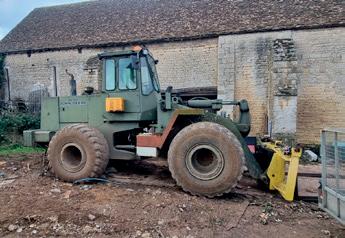



Herbst



info@ashleywaller.co.uk www.ashleywaller.co.uk www.easyliveauction.com




SATURDAY
APRIL 2024 at 10.30AM PROMPT
To include: Fiat Agri ATR Laverda 3650 Combine 12ft Header 1988, McCormick MC115 4WD Tractor, frt links and pto, 40kph, 3 spools, 3,400Hrs 2012, McCormick CX80 4WD Tractor with Trima 260 Pro Loader 2002, Manitou Hvy Duty Fork Lift, Mecmar 12t Electric Grain Dryer 2015 as new, Rau Vicon Deltra 34 2,800l Trailed Sprayer, Excellent Range of Arable Equipment
Catalogues Next Week
and catalogues please see www.abarnett.co.uk

RELATIONSHIP FINDER
Are you brilliant on the land or with animals –but not so good at finding a soulmate for yourself? Would you like to find a partner who shares your Christian faith and rural interests and way of life? If so ‘Friends1st’ can help. We are the introduction specialists for Christians. Give our friendly and approachable team a call on 0121 405 0941 to find out how our service can help you succeed in this area of your life. www.friends1st. co.uk/Christian-farmers-dating
MONDAY 27th MAY 2024

GREAT HARWOOD AGRICULTURAL SHOW
The Showfield, Harwood Lane, Great Harwood, Lancashire, BB6 7UL
www.greatharwoodshow.com

Woodhall Spa Country Show
SUNDAY MAY 19TH.
Green Lane, Woodhall Spa. LN10 6QY Main attraction ‘Waldburg Shires’ Livestock Trade Stands Classic and Vintage Ring Programme and much more. Further info@woodhallspashow.co.uk
B6144 Haworth Road, Cullingworth, BD13 5EE

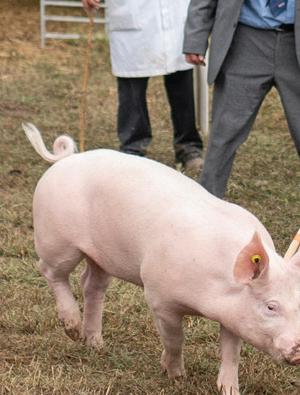










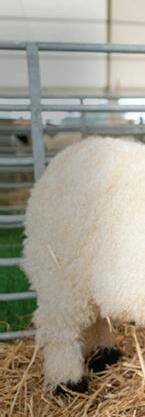









Saturday 11th and Sunday 12th May 2024 (In support of Manorlands hospice) ATKINSONS ACTION HORSES
Plus all the usual favourites Entry fees apply.
Camping available Contact
01535 275535 or woodies22@hotmail.co.uk

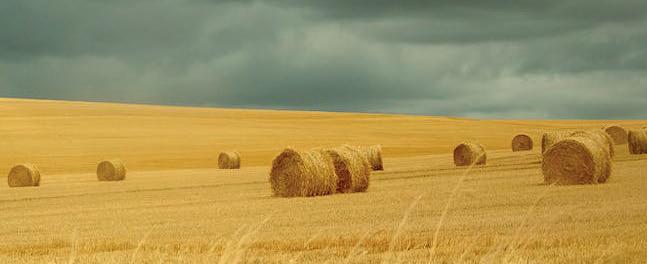

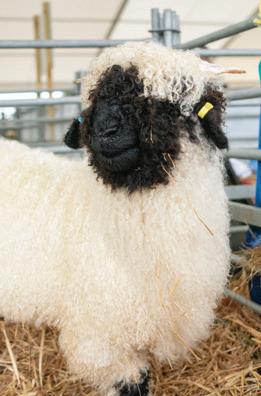

The Social Network for Country Loving People
Do you enjoy the countryside?
Do you like to socialise and meet new people?
If you are looking for new friends in a relaxed and informal environment, then try Country Link – the social network for the countryside. Open to anyone, and with a national network of local groups, Country Link offers a variety of pre-arranged meetings, events, and activities to suit all tastes, encouraging friendship but is not a dating agency.
Take a look on our website, call 07932 537183, or email contact@country-link.co.uk for more information and to find out what is happening in your area.
www.country-link.co.uk









Agriconnect is a business unit within the Arc network, a global events, data, and media platform. Arc is a fast-growing global events, data, and media platform with a varied portfolio content led portals, magazines, and events.
Since 1844, the brands of Agriconnect have been the trusted source of information for farmers and with brands like Farmers Guardian, events, like LAMMA and Farm Business Innovation, and digital platforms, like FG Insights, Agriconnect continues to bring together the British farming community.
• We are now looking for a motivated and driven salesperson to join our Sales team.
• The main function of the role is to develop business through growth in revenue, yield, and to increase customer numbers. You will be required to identify new opportunities and influence companies’ media buying habits within the agricultural sector. Due to the ever-changing nature of the industry, this person will have the ability to spot new avenues and exploit market trends.
• Hours: 35 hours per week – Mon – Fri
• Location: Preston – temporary hybrid remote
• Salary: Competitive, dependant on experience.
• Own, support and fully develop specific market sectors
• Conduct sales presentations by telephone, email or face to face to existing and prospective clients in order to develop existing business and generate new business wherever possible.
• Advise existing and new customers on the most effective solution to meet client needs within the Agriconnect portfolio.
• Continually seek and develop new sales & opportunities.
• Ability to accurately forecast future sales
• Keep abreast of all current trends, activities and relevant news within agriculture and specific sector
• An interest in agriculture
• Highly motivated & driven, with an ability to meet ambitious performance goals
• Be enthusiastic and motivated to continually explore new opportunities, whilst possessing a natural inquisitive nature
• Excellent communication written and interpersonal skills
We offer an excellent package including: A competitive basic salary
• 25 days holiday increasing to 27 after two years
• An extra day off on your birthday
• Free life assurance
• Contributory pension scheme
• Employee assistance programme
Arc has ambitious plans for growth, and this is an opportunity to be part of our continuing success story whilst enjoying a fabulous work/life balance. We strive to create a culture that is open and respectful, where differences are valued and celebrated. We want everyone to be able to reach their full potential, so we are committed to cultivating a company that promotes inclusion and belonging.
To apply for this role, please email
amber.tabiner@agriconnect.com



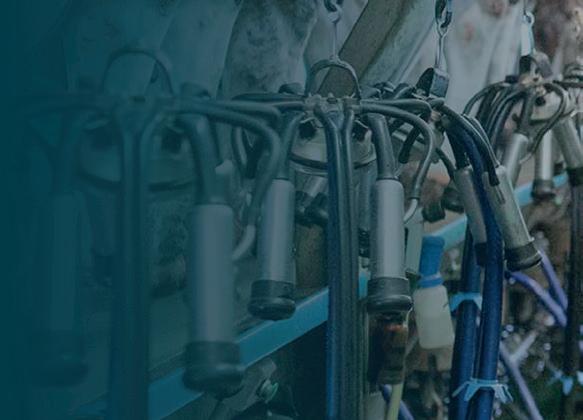







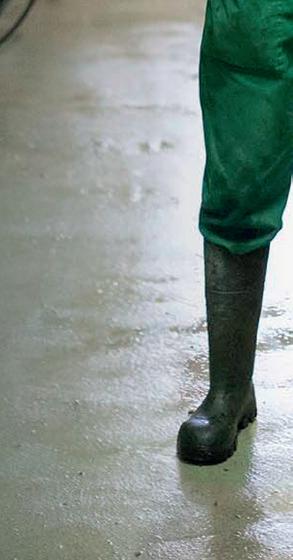



Employer: Farms for City Children
Location: Gloucestershire
Salary: £38,000
A new opportunity has arisen for a full-time Farm Operations Manager to join our worthwhile charity, which exists to remove the barriers that prevent children and young people having meaningful access to the natural world. Through a week on one of our three heritage farms, Nethercott House in Devon, Lower Treginnis in Pembrokeshire and Wick Court in Gloucestershire, children and young people experience increased learning and engagement, improved connections and wellbeing and leave us with enhanced environmental citizenship. Visiting children are immersed in the natural world of countryside through a food and farming offer that allows them to participate in the seasonal tasks of the day: sowing, growing and harvesting in our kitchen gardens; caring for livestock and looking after the land; and cooking up a home-grown feast in the farmhouse kitchen. Spending time working alongside real farmers fosters children’s independence and helps them to grow in confidence, develops their self-esteem, and encourages them to become more resilient. In partnership with our commercial farming neighbours, children experience the benefits of collaboration, enjoy plenty of physical activity, good food, and fresh air, and discover the magical rural environment that is full of new words, sounds and experiences to inspire their creativity.
ABOUT THE ROLE
This is a hands-on role responsible for the management of the farm, including buildings, equipment and livestock at Wick Court, a 50-acre smallholding raising pigs, beef cattle, poultry and sheep.
The role will set and deliver the direction of the land management of the farm. It will ensure that animals are cared for in line with the charity Animal Welfare policy and that biosecurity measures keep our beneficiaries and animals safe. The postholder will spend a proportion of their time delivering fun and educational sessions on the farm to the young people we work with.
The Farm Operations Manager is an integral role and as part of the operations team, will support also maintenance and management of the 16th century manor house, and may be asked to support all areas of operations of the charity at Wick Court.
The successful post-holder will have experience working directly with livestock, including administering veterinary medications, and lambing. They will be passionate about nature friendly farming and be looking for environmentally sensitive ways of managing the land for food production. They will also have experience working in partnerships, managing budgets and suppliers.
MAIN RESPONSIBILITIES
Be responsible for all farming operations at Wick Court, currently a smallholding raising pigs, poultry, sheep, including managing equine and our horticultural enterprise
• With the Farm School Manager, develop and deliver a sustainable and environmentally sensitive land management strategy for Wick Court
• Work closely with the Farm School Manager to ensure the farming environment and farming activities for visiting children are safe, stimulating and purposeful
• Oversee and lead on animal husbandry, ensuring animal welfare standards are maintained in line with our policies, and further developing our veterinary health plans and procedures
For more information on any of these vacancies or to see all our current roles, please go to: JobsInAgriculture.com



Our client - a fast growing and expanding leader within the environmental consultancy, compliance and by-product recycling sector - is seeking to appoint an experienced, energetic and highly motivated Agricultural Recycling Manager to take responsibility for the day to day management and delivery of their recycling service contracts. This key and crucial rolepart of a wider expansion of the business - offers huge variety and requires a candidate who thrives in a fast paced, multilayered environment, able to balance multiple elements culminating in the application of recycled waste material to agricultural land. You will be the point person from the outset - sourcing and securing farm land - through to spreading operations of the products and, working alongside the rest of the team, everything in-between which includes, but is not limited to, the following tasks: selling the benefits of the products to potential farmer clients and land owners, gathering of key data for spreading applications such as collection of soil, product and water samples, previous fertiliser application data, topographical information, cropping details and storage management plans alongside field mapping, pollution risk assessments and health and safety assessments. Liaising with the land owner, producer, transport & spreading operator you will ensure all elements come together in a safe and timely manner and within contract budgets.
Location: North of England
Closes: 27 Apr 2024
Job Sector: Dairy
Contract Type: Permanent
Salary: Highly competitive salary plus benefits
Our client - a fast growing and expanding leader within the environmental consultancy, compliance and by-product recycling sector - is seeking to appoint an experienced, energetic and highly motivated Principal Environmental Consultant to lead and develop their rapidly expanding consultancy services, whilst providing technical leadership and support across the groups complimentary sub divisions.
Since its formation in 2006, the award winning business has enjoyed sustainable and profitable growth, adapting and enhancing its range of services to its client base that includes farmers and growers, public bodies and multinational industrial corporations.
Building on success to date, this new role - part of a wider expansion plan - will further enhance and develop the business ensuring that the company remains at the forefront of this niche industry.
Location: Nationwide
Closes: 27 Apr 2024
Job Sector: Arable & Agronomy, Consulting work, Crop science, Management, Sales & Marketing, Technical
Contract Type: Permanent
Salary: Excellent salary plus benefits
For more information or to apply, head to JobsInAgriculture.com

following conditions:
1. Advertisement copy shall be legal, decent, honest and truthful, and shall comply with the British Code of Advertising Practise and all other codes under the general supervision of the Advertising Standards Authority: and shall comply with the requirements of current legislation.
2. While every endeavour will be made to meet the wishes of advertisers, the publisher does not guarantee insertion of any particular advertisement.
3. In the event of any error, misprint or omission in the printing of an advertisement or part of an advertisement the publisher will either reinsert the advertisement or relevant part of the advertisement as the case may be, or make a reasonable adjustment to the cost. No reinsertion, or adjustment will be made where the error, misprint or omission does not materially detract from the advertisement. In no circumstances shall the total liability of the publisher for any error, misprint or omission exceed
a) The amount of a full refund of any price paid to the publisher for the advertisement in connection with which liability arose. OR
b) The cost of a further corrective advertisement of a type and standard reasonably comparable to that in connection with which liability arose.
4. The publisher reserves the right to withdraw, amend or alter any advertisement it considers necessary.
5. Cancellations or advertisements are accepted providing they comply with the cancellation deadlines which are published at regular intervals.
6. Advertisement orders are issued by an advertising agency as a principal and must be on the agencies official form (when copy insutructions not constituting an official order are issued they must be clearly marked at the head “Copy Instructions – not an order”.
7. Advertising Agency commission will only be granted to those Agencies who are currently recognised by the Newspaper Society at the time of placing an advertisement order and copy. The rate of commission is determined by the publisher.
8. When credit is allowed payment is due within 7 days. Monthly accounts are due in full each month. “We reserve the right to charge additional costs and interest for non payment within our credit terms”.
9. Only standard abbreviations are permitted by the publisher. List available on request.
10. Classified display advertisements must be at least 3cms in depth for every column wide, and the minimum size of any advertisement is 2 lines.
11. Every endeavour will be made in order to forward replies to box numbers to the advertisers, as soon as possible after receipt by the publisher, but the publisher accepts no liability in respect of any loss, or damage alleged to have arisen through delay in forwarding or omitting to forward such replies, however caused. Circulars and the like should not be distributed through publisher’s box number facility.
12. The placing of an order for the insertion of an advertisement, is an acceptance of these conditions and any other conditions stated on any type of order form by an agency or advertisers are not applicable if they conflict with any of the above.
DELAVAL


New & Used Bulk Milk Tanks
Second hand tanks currently available:
Mueller 8000ltr, 9000 & 12,000 ltr
Fabdec 4000ltr & 6000ltr
Packo RMIB 3800ltr & RMIB 6000 ltr
New Heat Recovery units in stock
01772 780806 www.ddcooling.co.uk

Complete
and
We take a farmer-centric approach to media. Our job is to help farmers run their farms more efficiently and make better purchasing decisions



Reaching deeper and further into UK farming than any other media group


• GRANT FUNDED
• ESTIMATED PAYBACK OFTEN WITHIN 12 MONTHS
• 60% – 70% REDUCTION TO WATER HEATER RUNNING TIMES
• IMPROVEMENT TO THE COOLING UNITS PERFORMANCE
• HOT WATER AVAILABLE ALL DAY
• DOMESTIC OR OFFICE HEATING
• ALMOST ZERO MAINTENANCE
• HUGE REDUCTION IN YOUR CARBON FOOTPRINT POWERED BY








For sale choice of over 20 Bulls, all semen tested. Aged 17 -
Focusing on easy calving, quiet temperaments, high health and performance recording BVD Free, TB 4, Johnes 1
Pre-Movement TB Tested & Semen tested
Contact Lucy on 07921 812971 Alnwick, Northumberland
Pedigree Devon Heifers from the Ashott Barton Herd

Traditional Devon cattle from a closed herd.
Born and reared on Exmoor Ready to go to bull now.
Tel: 01643 831294 (P)
Alderville Polled Herefords
Offer a selection of 10 bulls for sale. 18-24 months old. Easy Calving Good EBVS, TB Tested, Accredited Johnes, lepto and BVD.
Tel: 07999 527108 Derbyshire (P)

Adrefelyn
Aberdeen Angus
Has a selection of working bulls and bulling heifers for sale
From a closed herd. Easy Calving.
Telephone: 01978 780368 or 07986 113221 Wrexham (P)

AA
ANGUS bulls & heifers,TB1, biobest elite health 15 years accreditation IBR, BVD, Lepto Johnes - Tel: 01386 462534 or 07592 798555 abbertonaberdeenangus.co.uk
ANGUS BULLS and heifers for sale or hire.
Tel: 01347 868236 or 07836 370253 Thirsk (P)
Vaccinated for BVD + IBR, TB 4 Area
John Procter, Waterbeck.
Tel: 01461 600257 or 07729 405369
Lockerbie (P)
Available in suitable batches delivered to most parts of the country
Continental Bull and Heifer calves 3-5 weeks old available now. Quality store cattle sourced directly from Welsh/Shropshire Borders Farms, delivered to your farm. Delivery Nationwide.
Livestock Supplies Ltd
Ashley: 07831 887531 Office: 01829 260328
www.livestocksupplies.co.uk
Five Red and Black Limousin stock bulls
High Health Status
Sired by top AI Angus Bulls, bred for calving ease, high growth & maternal traits.
Fully guaranteed & ready to work. Will deliver when required.
Contact Robert Shanks
07974 968150 Kelso (P)
17-22 months. Some Semen tested. TB4 area. Younger bulls also available
Tel Edward: 07770 457453 N. Yorkshire (P)
Ready to work, delivered direct to your farm, very quiet, easy calving. Also females available. Health monitored, closed herd, full pedigree with each animal, Red tractor. Semen Available.
Tel: 077157 64351








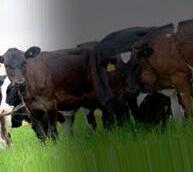





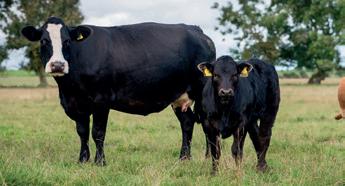






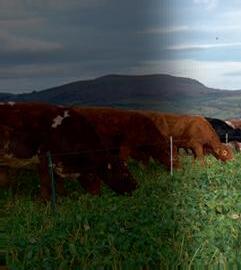









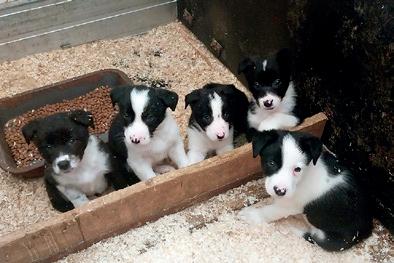

Biscon
Cereal Mixture (Approx. 14% Protein /13 ME) £205
Cereal Blend (Approx. 16% Protein /13 ME) £225
Mixed Pellets (Approx. 18% Protein /13 ME) £245
Mixed Pellets (Approx. 18% Protein/13 ME)
Biscon Meal (Approx. 12% Protein/14 ME)












Inspired

•
•
•
•
•

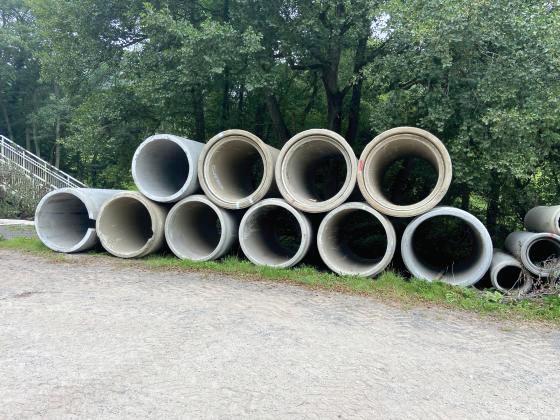
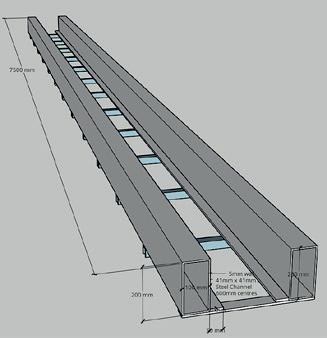









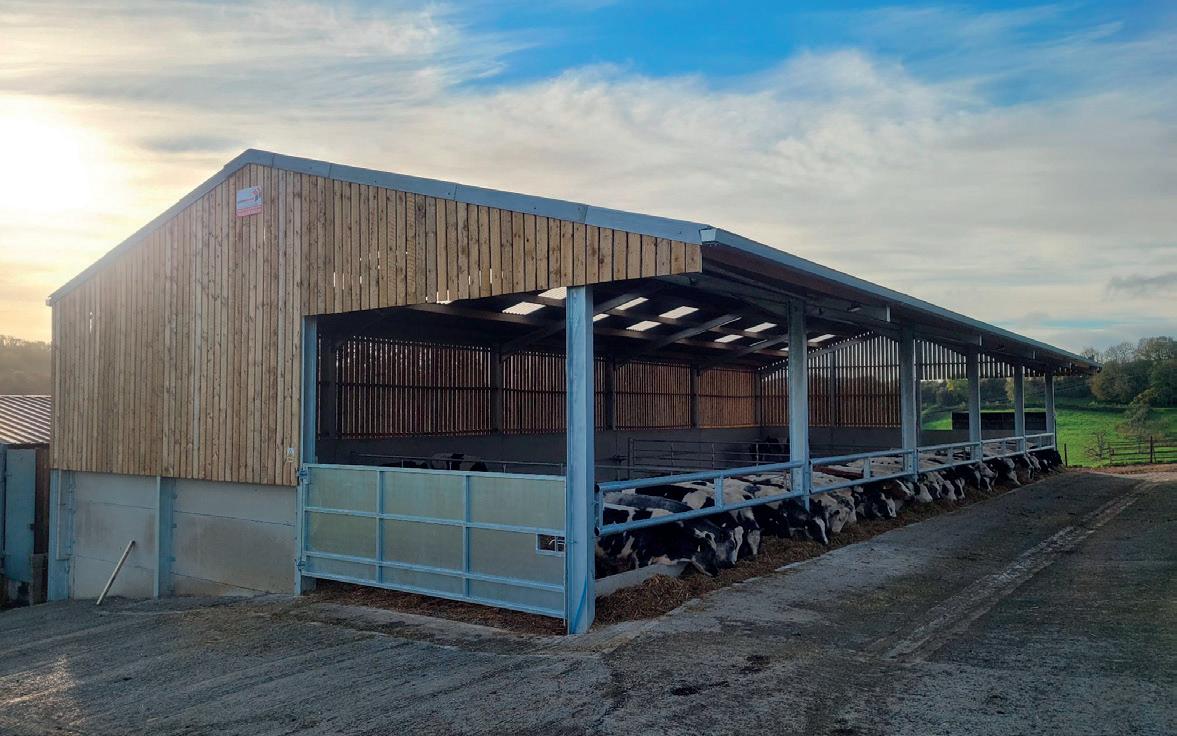












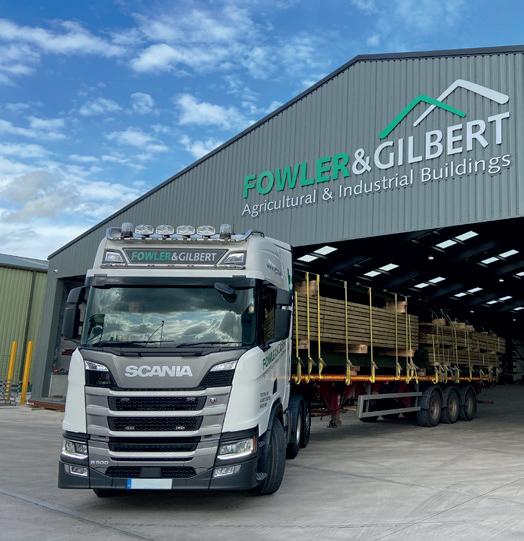

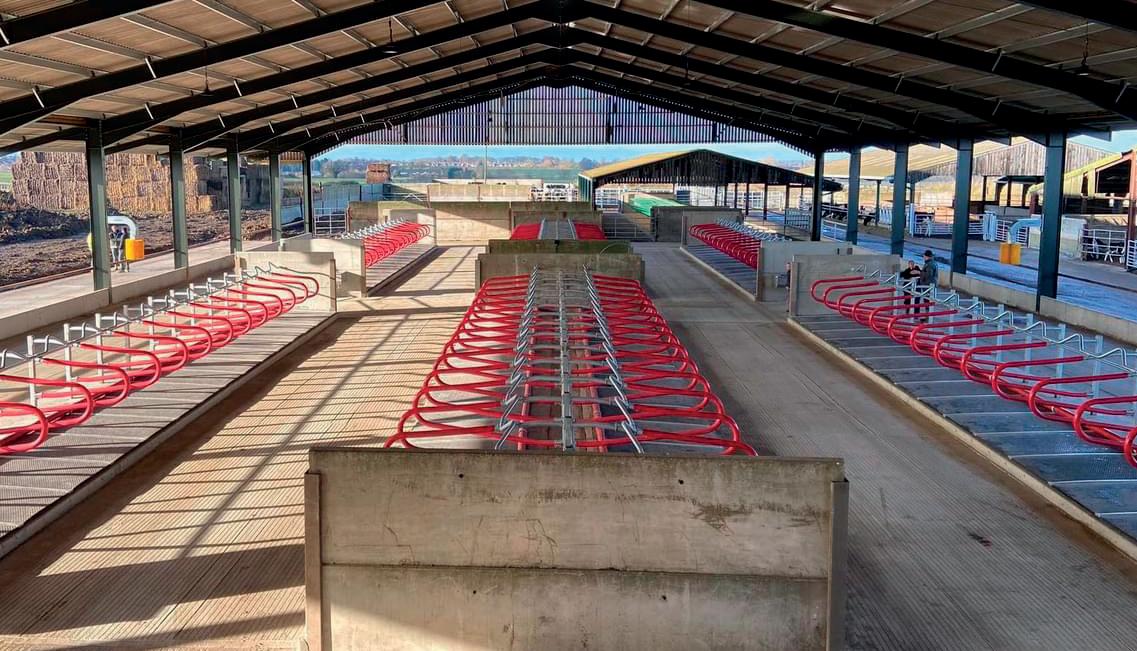
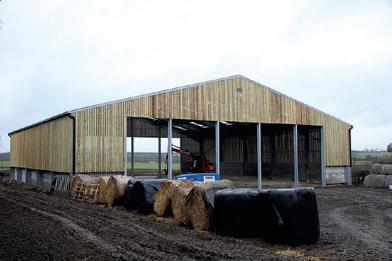
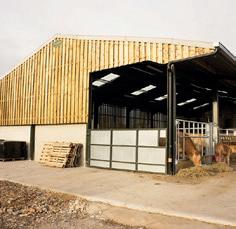
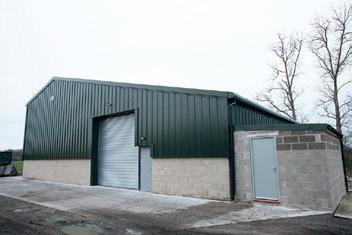












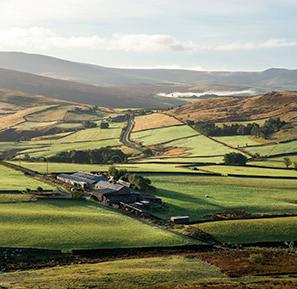


bespok p ke

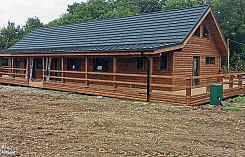

mes holida your quire ywhere, w
regula





Aweek may be a long time in politics – and in football – but in the Scottish land market, it is sensible to take the longer term view, considering the general trends and influences over the past couple of years in order to made educated decisions going forward.
At Dales, we are involved in the legal aspects of many of Scotland’s land deals, year-on-year, and hopefully our experience and observations on the land market will help contribute to readers’ own picture as we enter the busy spell of land dealings in 2024.
Mid-summer of 2022 saw the Scottish land market peak, with a significant rise in the value of all types of land.
This was caused by a lack of land available, unprecedented demand from planting investors, businesses buying for nature-based solutions, non-farming and roll-over cash, along with continued strong demand from lifestyle buyers.
Farms and land for sale in 2023 saw a similar supply and trade.
With the Bank of England base rate increasing throughout 2023 and agflation peaking at around 30 per cent, the cost of running a farm and the cost of money to buy a farm have all dramatically increased.
Agricultural Reform is promising to bring sustainable and regenerative agriculture which will include a whole farm plan.
The Basic Payment Scheme payment regime in Scotland will end in 2026 and the framework for the successor scheme has been launched, but the full extent to which it will actually support the farmer’s bottom line, and therefore their ability to service debt, expand and invest in land, remains to be seen.
The continued ambitious woodland creation targets means that there is strong demand for land for this purpose, so long as it meets the

criteria of the now more limited grants available.
Qualifying land continues to realise values at a moderate premium above agricultural trade. This type of land must now be no more productive than Grade 4.
Demand for development land from major house builders has tapered off, although there are recent signs of demand returning with an apparent shortage of new houses being built.
Opportunities for renewable energy projects relating to wind and hydro continue to present themselves and, while solar projects in Scotland have historically been as rare a sight as the sun itself, improvements in technology and a desire for grid security from renewable sources have seen a recent increase in demand.
There is a huge amount of work ongoing to improve the national electricity grid network.
This will hopefully enhance Scotland’s ability to be the hub for renewable energy that it certainly has the potential to be, and in the meantime, the countryside is awash with land-related deals relating to those future network upgrades, such as battery storage projects, wayleaves for powerlines and land for substations.
Taking the best professional advice in relation to any such dealings is paramount.
George Dale is rural property manager at Dales Solicitors. Call 01563 820 216, or email George@ dalesllp.co.uk


THE process from a local plan’s ‘call for sites’ to a land sale typically stretches beyond the length of a four-year political term.
And yet development is all too easily derailed, or substantially delayed, by short-term political thinking.
That was the message from Ian Barnett, national land director of Leaders Romans Group, as he highlighted the perils of politics in land promotion.
He said: “This is demonstrated time and time again. Earlier this Parliament, Boris Johnson made a conference speech in which he said that he would not support greenfield development and, as his comments ricocheted around town halls up and down the country, many local plans were halted.
“Another impasse occurred following Liz Truss’ comment about ‘Stalinist national housing targets’ and then Rishi Sunak’s substantial changes to national planning policy and the effective scrapping of housing targets.
“Both were the result of a political rebellion fuelled by entrenched nimbyism within local communities.”
He said many local plans were now stalled and landowners were unsure of the future potential for their land.
“In every case, local politics is the root of the problem – local residents resist development and the councillors that represent them fear an own-goal, scored by the notorious ‘political football’.”
Democracy has had an active role in planning since the first Town and Country Planning Act in 1947.
“I am not endorsing a US-style, market-led approach to planning which deprives residents from having a voice, but the next election must not be fought on opposition to development,” Mr Barnett said.
He added there was undoubtedly a role for local voices in development decisions.
But he said it was clear from the new towns delivery programme and the establishment of development corporations, that housing targets were only met when decisions were outside the remit of local authorities.
“An infrastructure first approach which brings together infrastructure, housing, energy and climate change in a de-politicised environ-
ment to expedite the creation of new settlements, is part of the solution,” he said.
He suggested the closest the UK had ever got to this model was the Regional Spatial Strategies which were introduced by the last Labour Government in 2004.
These established a spatial vision and strategy specific to a region, for example, including the identification of areas for development with a 20year timescale while also providing direction for Local Development Frameworks on a local (borough/ district) level.
“They provided a cohesive approach to housing targets, transport planning and regionally-specific policies which is so problematic within the two-tier system.
“Even then, politics hampered progress: they were denied time to crystallise and ultimately withdrawn before they had chance to come to fruition,” he said.
“Saying ‘yes’ to utilising land for development works best top-down, rather than bottom up.
“Ideally, a national spatial plan could kick-start development strategically and effectively.”
Community involvement would have a role to play and only land put forward for development by its owner would be considered.
But he emphasised that the engagement process must be efficient and consistent.
“As Neighbourhood Planning has demonstrated, the potential for a specific community to impact on planning decisions lies in that community’s demographic – neighbourhoods with a professional, prosperous and permanent demographic are likely to exert more power than deprived areas with transient communities,” he said.
He added recent politics had also demonstrated speeches ‘berating development of greenfield land and the surrender of housing targets’ might bring about short-term political success.
“But to enable the sale of land suitable for development, create new settlements, and in doing so achieve the political goal of providing the housing that this country needs, it requires long-term commitment.
“A Government which could enable this – if necessary, by relinquishing some local political power – could achieve a lasting legacy for which they would be proud.”






Rothersyke Farm, Egremont, Cumbria CA22 2US
For Sale by Informal Tender a well-located block of land & buildings suitable for mowing, grazing and arable cropping in part, (Lot 5 is woodland) split into five lots: Lot 1 – buildings & 71.88 ac (28.88 ha)
Guide Price £475,000
Lot 2 – 12.84 ac (5.20 ha)
Guide Price: £90,000
Lot 4 – 19.46 ac (7.87 ha)
Guide Price: £150,000
Lot 3 – 4.60 ac (1.86 ha)
Guide Price: £45,000
Lot 5 – 1.42 ac (0.57 ha)
Guide Price: £5,000
Closing date for offers to be received is by 1st May 2024 at 4pm
Contact: 01782 522117 or george.pullin@whittakerandbiggs.co.uk john.wilson@whittakerandbiggs.co.uk
www.whittakerandbiggs.co.uk
Approx 64 acres (26ha) Well fenced, level ground seasonally wet. Suitable for 12 – 18 head of cattle. May suit traditional native breeds.
Terms negotiable -payment available.
For further information contact: patricia.turnock@norburypark.co.uk Norbury Park Estate, Gnosall Stafford.

0.5 to 3 acres
Green belt/green field land
Must be adjacent to existing built up area with access. Up to £100k/acre
Call Max 07968 449642



max@gouch.net
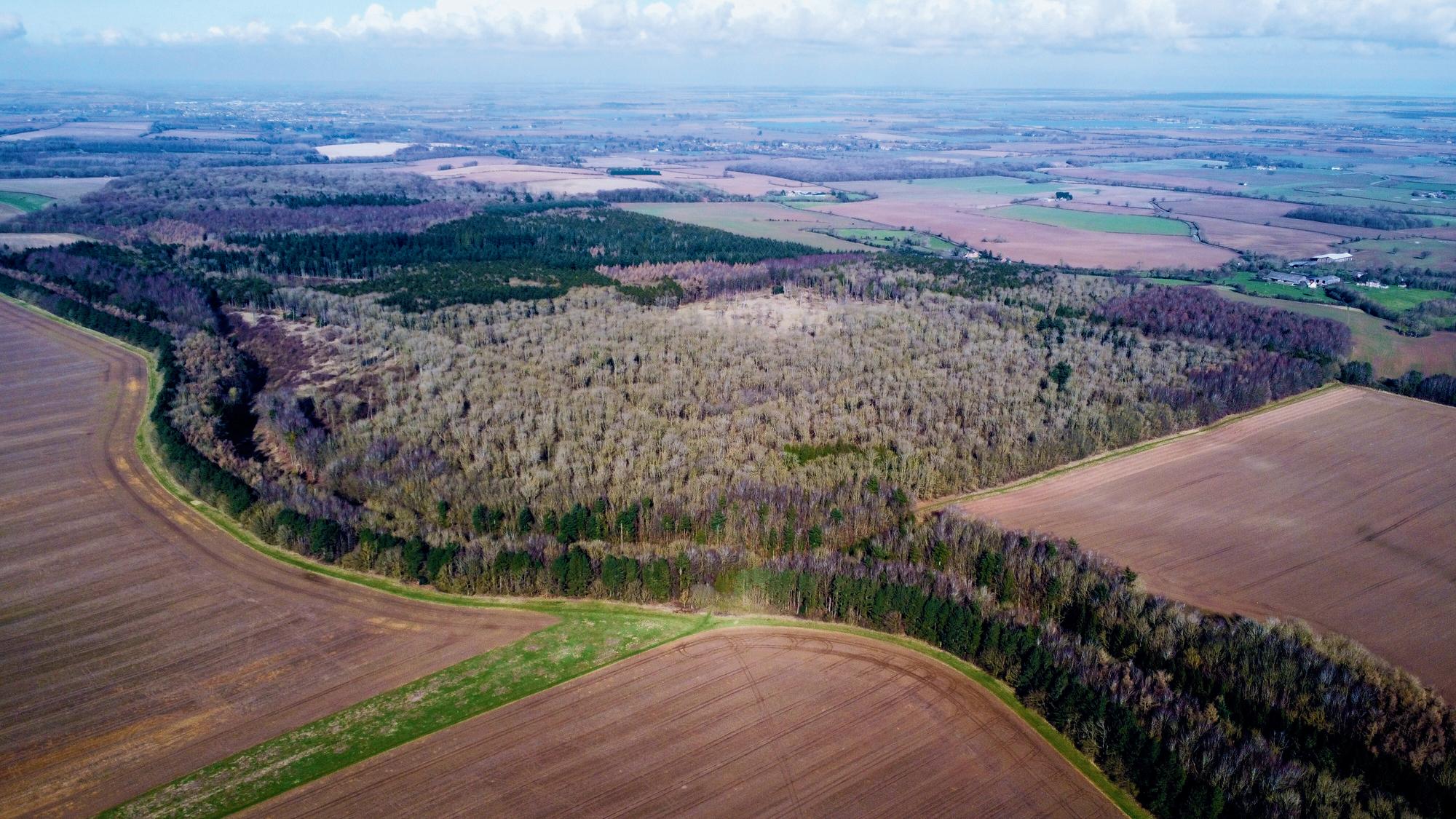





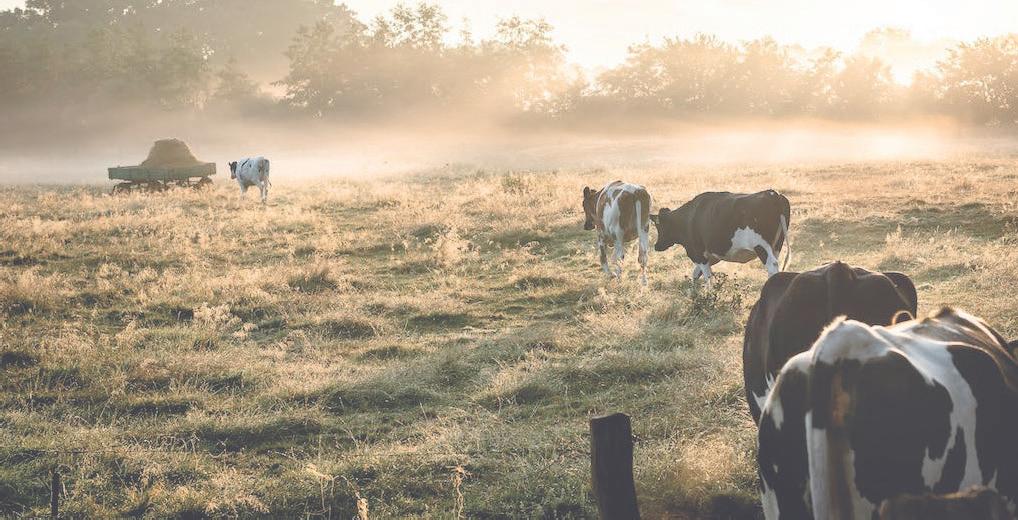








landowners. Contact me for a confidential and expert consultation at no cost. All areas of the UK covered.

Farmers Guardian, Fginsight.com and fgbuyandsell.com (hereinafter referred to as ‘Farmers Guardian) may contain advertisements, links to other Internet websites or online and mobile services provided by independent third parties, including websites and telephone contacts of our advertisers and sponsors (what we call “Third Party Sites”), either directly or indirectly.
It is your decision whether you purchase or use any third party products or services made available on or via Third Party Sites and you should read below carefully. Our Privacy Policy does not apply to Third Party Sites. In no circumstances do we accept responsibility for your use of Third Party Sites or in respect of any Third Party products. By Third Party Sites we mean websites, online or mobile services provided by third parties, including websites of advertisers and sponsors that may appear in Farmers Guardian. By Third Party Products we mean products or services provided by third parties.
Farmers Guardian contains advertising and sponsorship. Advertisers and sponsors are responsible for ensuring that material submitted for inclusion on Farmers Guardian complies with international and national law. Farmers Guardian (nor its websites) is not responsible for any error or inaccuracy in advertising or sponsorship material.



Any agreements, transactions or other arrangements made between you and any third party named in, on (or linked to from) in Farmers Guardian and its websites are at your own responsibility and entered into at your own risk. Farmers Guardian promises to develop and operate with reasonable skill and care and will use reasonable efforts to promptly remedy any faults of which it is aware.
Farmers Guardian does not provide any other promises or warranties about its products and services. Farmers Guardian is provided on an “as is” and “as available” basis. This means that Farmers Guardian does not make any promises in respect of Farmers Guardian or the services and functions available on or through Farmers Guardian, Fginsight.com and fgbuyandsell. com or of the quality, completeness or accuracy of the information published on or linked to from Farmers Guardian, Fginsight.com and fgbuyandsell.com other than as expressly stated above.
The above disclaimers apply equally to your use of Farmers Guardian, Fginsight.com and fgbuyandsell.com without limiting the above; Farmers Guardian and its websites are not liable for matters beyond its reasonable control. Farmers Guardian does not control third party communications networks (including your internet service provider), the internet, acts of god or the acts of third parties.
Farmers Guardian liability will not be limited in the case of death or personal injury directly caused by Farmers Guardian negligence in those countries where it is unlawful for Farmers Guardian to seek to exclude such liability.
Any individual, who is in doubt about entering into a loan agreement, should seek professional advice or consult an authorised person who can assist in relation to entering into a credit agreement. Before acting on any information you should consider the appropriateness of the information having regard to these matters, any relevant offer document and in particular, you should seek independent financial advice.
All loans, loan participations and financial products or instrument transactions involve risks, which include (among others) the risk of adverse or unanticipated market, financial or political developments and, in international transactions, currency risk. Lending against non-traditional physical collateral exposes investors to specific risks such as the potential for fraud, theft, damage and illiquidity.


73 TOYOTA HILLS E/CAB 4WD
TOP SPEC ALLOYS. DELIVERY MILES.
5YR WARRANTY £28,500
23 LANDROVER DISCOVERY SE DYNAMIC
PAN ROOF, E/TOWBAR, BLUE, 6200 MLS
69 NISSAN NEVARA TENKA
MANUAL PICK UP, BLUE, LOW MILES, NISSAN WARRANTY DEC OUTSTANDING CONDITION £17,850
19 LANDROVER DISCOVERY COMMERCIAL BLUE, 1 OWNER, TOP SPEC, AUTO HIGH MILES, FULL SERVICE HISTORY
18 TOYOTA HILUX
INVINCIBLE 4DR 4WD
BLACK HIGH MILES, MANUAL V/TIDY
67 TOYOTA HILUX
INVINCIBLE 4DR 4WD
MET BLUE, ALLOY LINER, LOW MILES OUTSTANDING £18,750
13 TOYOTA HILUX
INVINCIBLE 4DR 4WD
GREY MANUAL, 94900 MILES, VERY TIDY £7750
60 TOYOTA HILUX
INVINCIBLE 4DR, 4WD
GREY MANUAL, MOT, IFOR CANOPY, VERY TIDY
11 SUZUKI JIMNY 4WD
PETROL, 90K, 10 MONTHS MOT £3500
04 SUZUKI JIMNY 4WD
PETROL, ON RETENTION, CHEAP TO CLEAR £1500
CLH SHEEP TRAILER
C/W SPARE WHEEL / DIVISION, USED 4 TIMES £1975 NO VAT CALL 07976 252191 COLIN TOWNSEND

















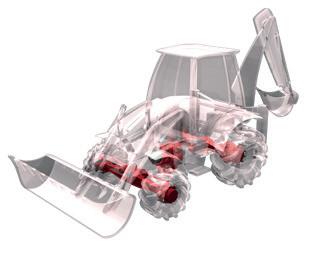











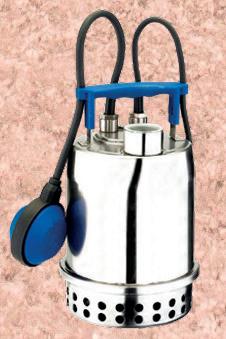




























































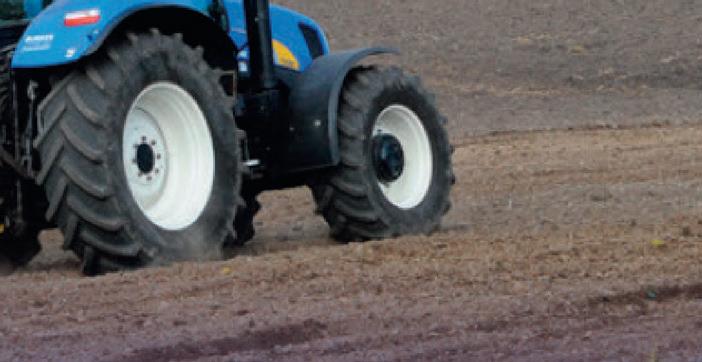



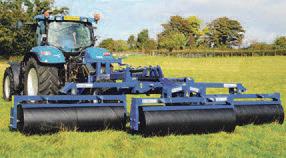



JOHN DEERE 6120M
2020, 1797 Hours, AQ, TLS, 40kph, 2 Spools, 520/480 Tyres, £66,000 + VAT
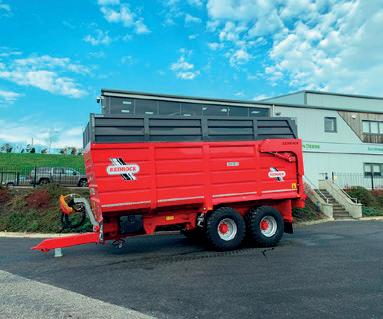
NEW REDROCK 200/20.0 SILAGE TRAILER
28.8/40.0m3 capacity, Sprung Drawbar, Commercial Axles, £29, 850 + VAT


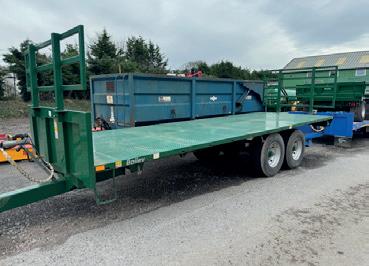
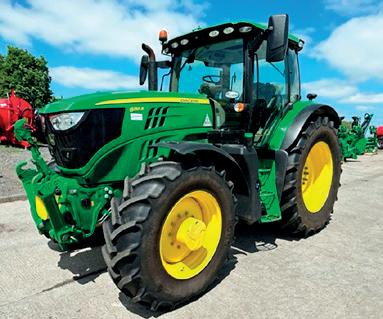
JOHN DEERE 6155R
2021, 1805 Hours, Command Pro, 50kph, Air, TLS, Cab Suspension, £115,000 + VAT

NEW REDROCK 12T 26FT FLAT TRAILER Fixed Axles, 2’ Removable Headboard, Hyd Brakes, £11,000 + VAT
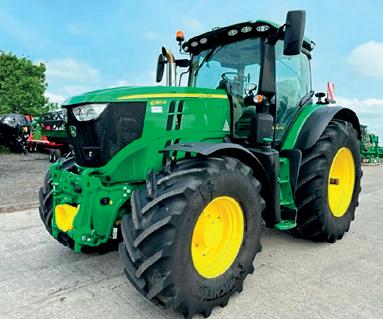
JOHN DEERE 6250R
2022, 963 Hours, Command Pro, 50kph, F/Link PTO, AT Ready, 710/42, £174,500 + VAT

NEW SIP 650/ 20T TRAILED TWIN ROTOR RAKE Hyd Rotor Lift, 3yr Warranty, 6.66M, £18,950 + VAT

JOHN DEERE 8300
2020, 363/239 Hours, KP Ready, 639 Header, 710/620 Tyres, £187,500 + VAT

NEW SIP SILVERCUT DISC 300F MOWER Lights, Quick A-Frame Linkage, 3yr warranty, £15,450 + VAT

JOHN DEERE 8600I
2023, 280/110 Hours, Prodrive, 40kph, 639 Header, Remaining Powergard, £267,500 + VAT

NEW SIP SILVERCUT DISC 900C MOWER Hitch, 8.55/8.95m working width, 3yr warranty, £29,500 + VAT

JOHN DEERE 960
BALER
2017, 13 Knife, Central Grease, 1100 Display, 500/55/20, £25,000 + VAT

NEW STRAUTMANN
VERTI MIX 1801
Hyd Brakes, Single Axle, 2 Speed Gearbox, Hyd Brakes, POA





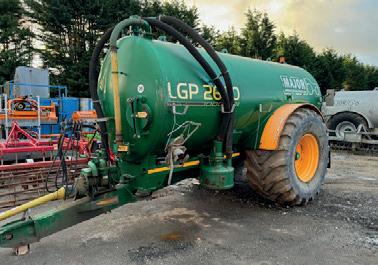
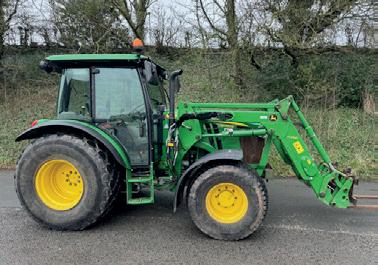



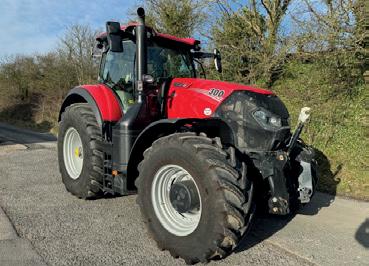

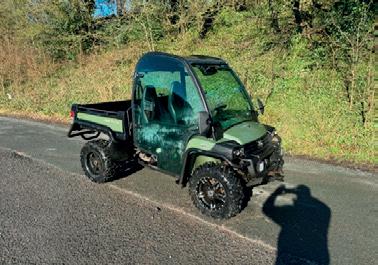





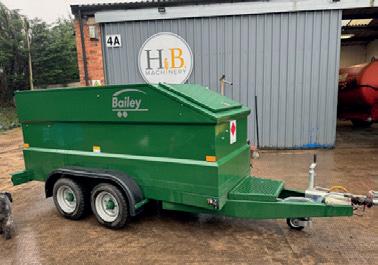
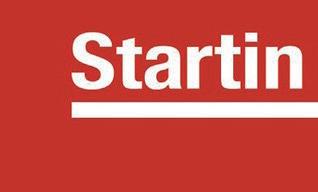


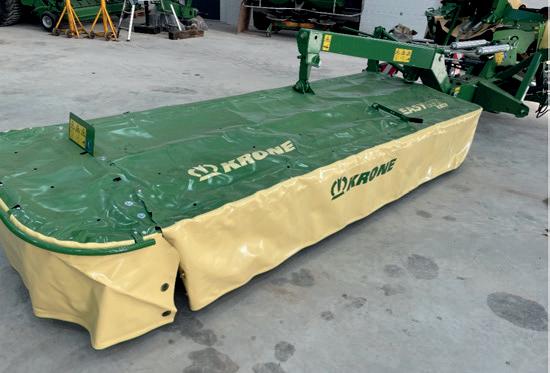
Easycut
Easycut
Easycut
Easycut R360 Mounted Mower
Easycut F320 CV Front Mounted, Mower Conditioner, Push Headstock
Easycut F320 CV Pull Front, Mower Conditioner


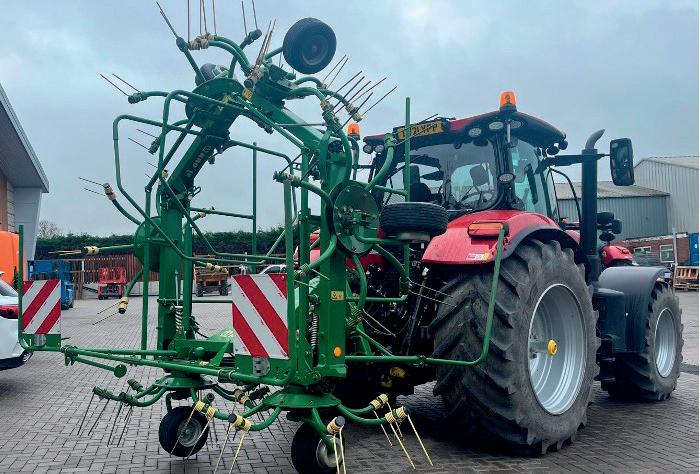
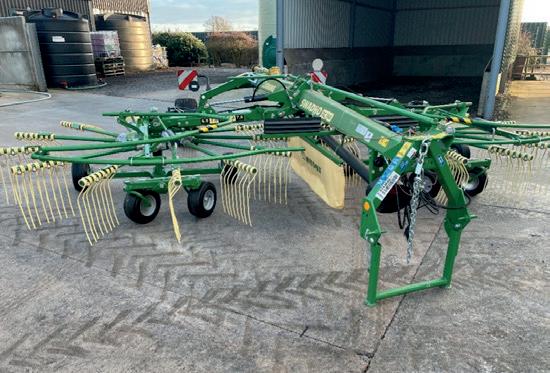


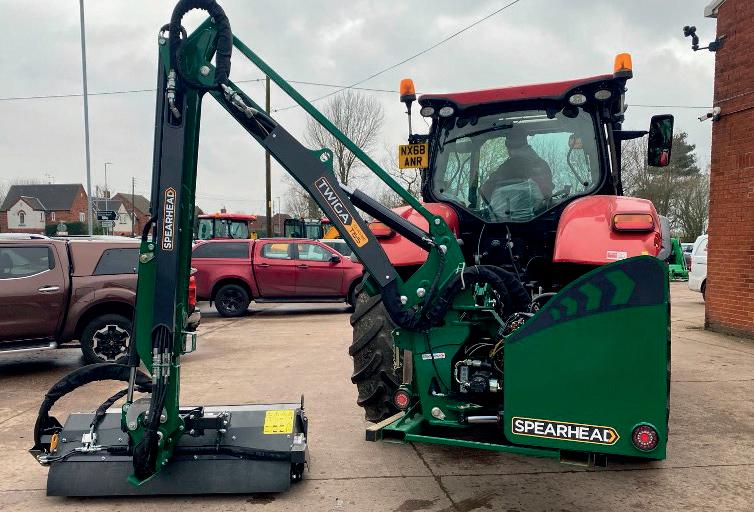

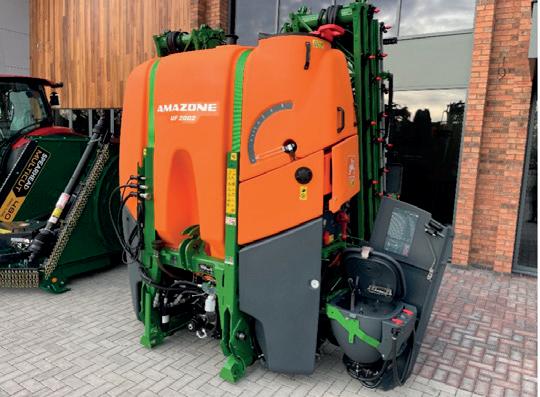




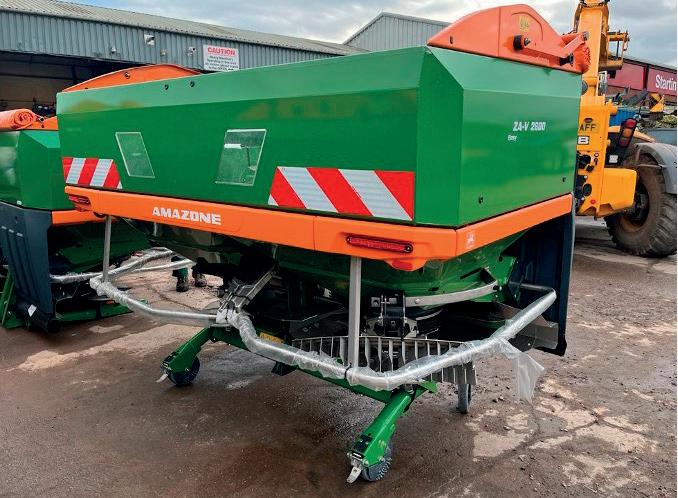
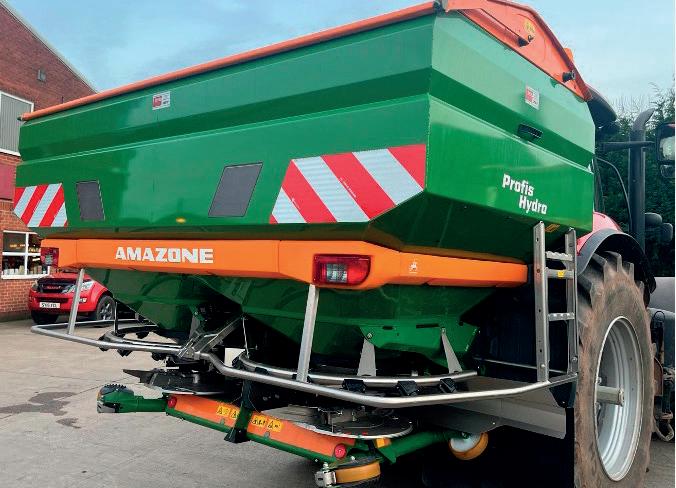
Rate control V2 Discs
NEW ZAV 2600 Easy Set terminal v3 Disc Roll over cover RH Limiter
NEW ZAV 3200 Profis Tronic Isobus
NEW ZATS 4200 Profis Hydro C/W Flow Control Argus twin Isobus TS 3
2022 ZAV 3200 Easy Set terminal v3 Disc Roll over cover RH Limiter
Ex Demo condition
2019 ZATS 3200 Super Hydro Profis
2019 ZATS 4200 Profis Tronic Hydro Isobus, Argus Twin


NEW MULTICUT 480 Proline Flexwing 6 Blade Mower
NEW 225 SNIPER 2.25M Hydraulic side shift flail mower
NEW SNIPER 230 HD Offset variable parallel arm and variable cowl angling
NEW SNIPER 250 SHD Flail 2.5m Front and Rear Mounted Flail Topper
NEW 270 SNIPER 2.7M Hydraulic side shift flail mower
NEW 280 SNIPER SHD 2.8m Front and Rear Mounted Flail topper
2014 MULTICUT 430 Mounted Topper


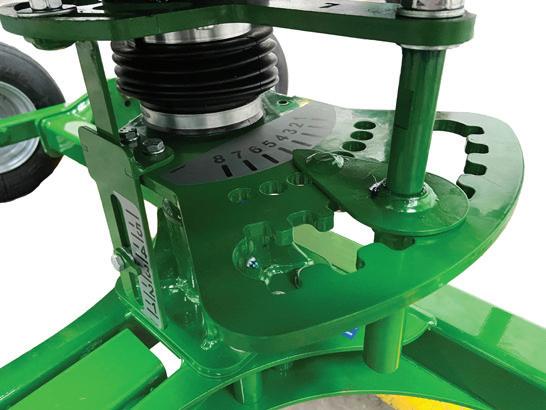
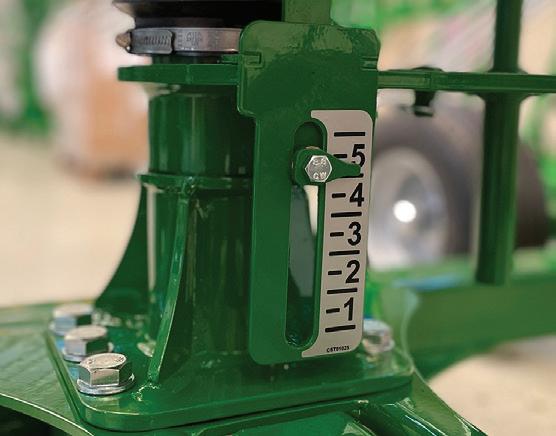
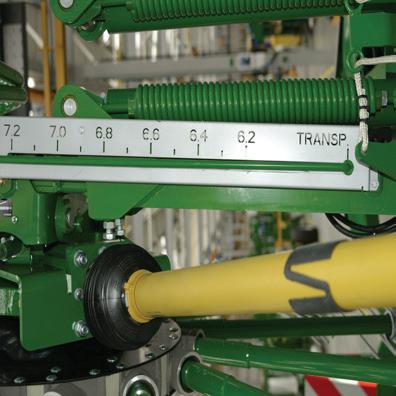




831 – toby.whatley@agriconnect.com


Visitors to LAMMA 2024 may have spotted a new trailer on the Bunning stand in addition to the brace of spreaders. Farmers Guardian finds out why the company has returned to trailer production and what the range has in store.



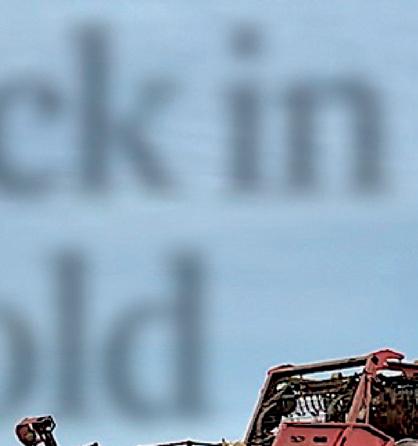

Although synonymous with producing muck spreaders, Bunning has a long history of trailer manufacturing that pre-dates its first spreader by several decades.
So, it is no surprise that the company’s return to the trailer market has been welcomed by customers old and new.
Since it halted trailer production in 2010, Bunning has concentrated on spreader manufacturing, growing both UK and export markets and producing upwards of 400 per year.
LAMMA provided the launchpad to restart trailer production and, Ben Johnson, Bunning’s UK and Ireland sales manager, explains this is down to several key factors.
Mr Johnson says: “Our factory expansion two years ago has allowed us the space to streamline the spreader production, but it also freed-up some useful floor area in some of the existing buildings.
“Coupled to this has been the continual customer requests to build trail-
ers again, which we were motivated to meet.
“With the modernisations we have made to the trailer, we felt it was the right time to reintroduce the line.”
Initially Bunning is offering four models in 14-tonne, 16t, 18t and 20t versions and each model has Bunning’s standard three-year warranty to match that of its spreaders — something that is almost unique in the trailer market and should appeal to farmers looking for consistent backup and longevity.
Spreaders have been Bunning’s sole focus for more than a decade, but the first Bunning trailer, a 6t tipping unit, was produced in 1963 at the company’s Gressenhall factory in Norfolk.
The early days of trailer production were focused on building models to match customer requirements.
Mr Johnson says: “There was not a line of standard models sitting in the yard waiting for customers to collect. The orders were for bespoke trailers that suited customers’ individual requirements for different crops and farming systems.
“As we built to order, users could spec trailers to their wishes.”
Models included bespoke scissor lift, grain, beet, and silage trailers of various sizes and spec, along with high-tip agricultural dump trailers.
Although trailers were sold nationwide, Bunning retailed many models into East Anglia and the eastern counties for specific purposes.
“A lot of farmers liked the modular build of the trailers, which meant they could use it throughout the year on a variety of tasks.
“Silage sides turned a grain or
root trailer into a unit suitable for hauling grass and we built a lot of trailers for sugar beet growers.
“The design of these was adapted to include a chamfered rear chassis allowing farmers to reverse over the grader without the trailer falling foul,” Mr Johnson adds.
Although trailers were one of the earliest Bunning products, the introduction of the spreader range in 1986, and subsequent growth and expansion of numerous models,
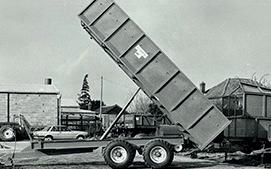
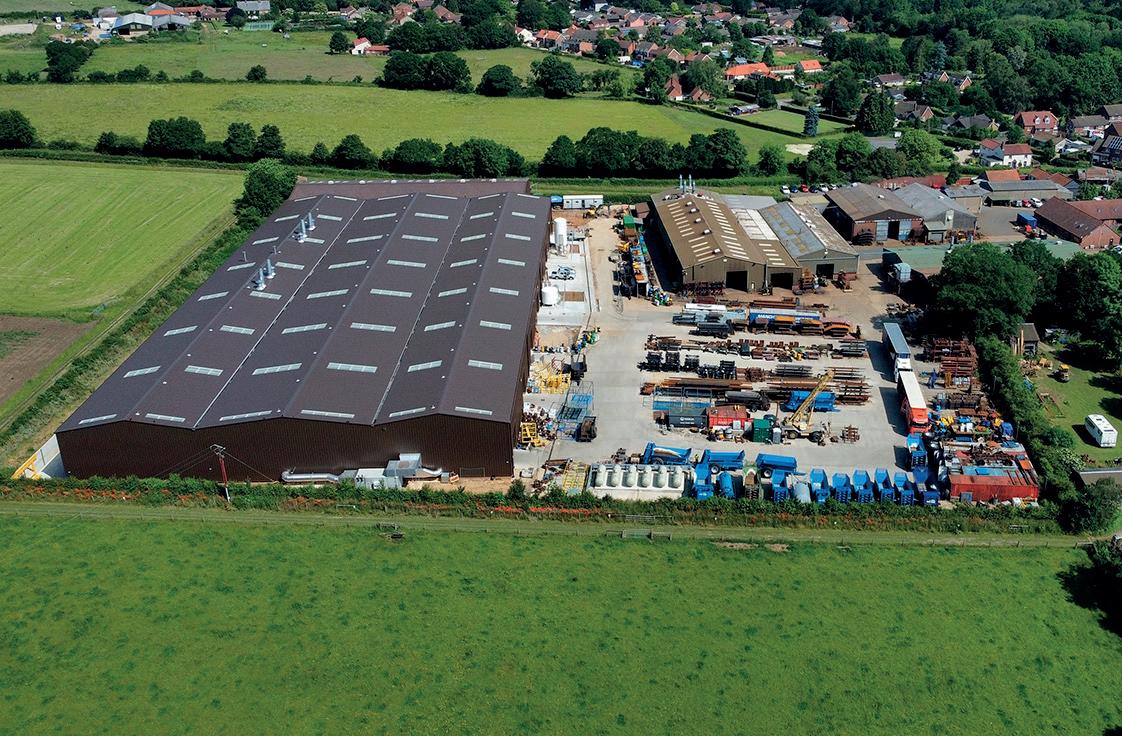

meant the trailers were becoming a smaller part of the business.
Bunning kept developing and engineering more efficient trailers, such as introducing a single tipping ram as standard on all units in the mid-2000s to provide more efficient hydraulic power, along with a 60-degree tipping angle enabling users to heap piles of beet.
However, in 2010, the decision was made to fully concentrate on the spreader production and stop building trailers.
“We had to go with the market demands and our spreader range was what customers wanted.
“When we stopped trailer production in 2010, spreader production was 95 per cent of the business.
“At such small numbers, it was becoming inefficient for the factory to accommodate these trailer builds and the floor space was required to produce spreaders,” says Mr Johnson.
The decision proved correct as the spreader range has continued to expand to form a comprehensive line-up of twin vertical auger and horizontal beater and spinning disc machines from 6t up to 40t.
All available space has been required for spreader production over the past 14 years, but a 6,840sq.metre factory extension on the existing site was completed in 2022, allowing a streamlined production process.
Bunning has installed laser cutters and welders along with a new shotblasting and paint line for the spreaders.
“We have been gradually moving the spreader production from some of the older buildings to the new facility and, in doing so, this has freed up valuable floor space.
“Although spreader demand has remained consistent, we now have additional production capacity,” says Mr Johnson.
Additional resources have been employed to ensure that trailers receive the same level of develop-
We are offering a premium trailer range and we know customers will want flexibility when deciding on what to have BEN JOHNSON
ment, and customer support as the spreaders.
“There has been increasing demand from new and existing users, but also from some of our dealer network who do not have a dedicated trailer range.
Our investment in the business infrastructure has opened the door to the trailer market again,” adds Mr Johnson.
The trailers are built on the design that was refined across several decades. It has been modernised in certain areas to improve strength, and some parts have been redesigned following customer feedback.
Bunning says its trailers will benefit from the experience gained from the expansion of the spreader range, such as modern production fa-

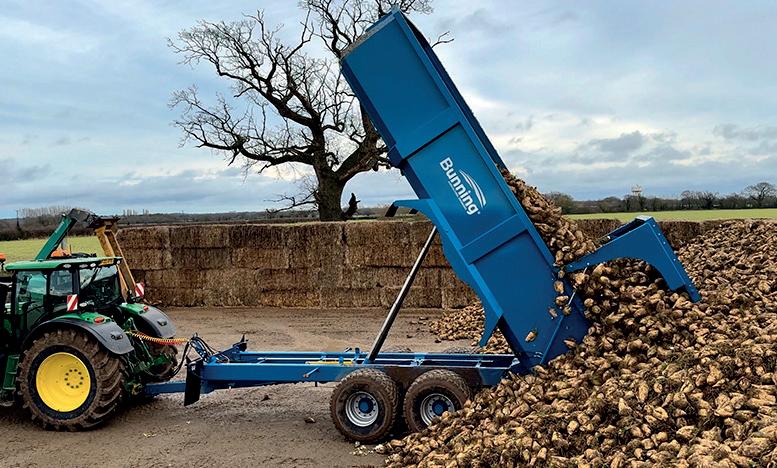
cilities and a high-quality paint line, which will be applied to the new trailers.
Mr Johnson says: “When we built the factory extension, we invested heavily in a £1.3 million paint line, which includes a dedicated preparation booth between shotblasting and painting, and a primer and topcoat applied to every machine.
“The trailers will receive this same treatment, which is a big appeal for users, and we pride ourselves on our paint finish.”
Features used from earlier models include the 4mm thick steel sides, which only have one weld across the full length and a 5mm floor, offering further strength. A stronger 300x 150mm chassis has also remained after Bunning introduced this on its pre-2010 trailers to improve longevity and strength.
Key areas that have been modernised include a deeper top rail and wider rear corner posts, both now 80x120mm replacing the 80x80mm design, to improve strength and appearance of the trailers.
Mr Johnson says the tailgate is the
one area that has seen a complete redesign.
He adds: “The design team has worked hard to improve the tailgate.
“It is now tapered to the grain chute from either side to aid unloading, while hydraulic locking pins ensure a tighter seal to the body when it is closed.
“The grain hatch has been redesigned with plastic runners for easier operation and the whole trailer body is tapered from front to back by 100mm, which helps loads exit the trailer,” says Mr Johnson.
The factory is processing trailer orders it has received since launch at LAMMA 2024 and Mr Johnson says being flexible to accommodate customer demand is going to be a key factor.
“We want to listen to customer feedback and find solutions to their problems,” adds Mr Johnson.
“We are offering a premium trailer range and we know customers will want flexibility when deciding on what to have. The extra space and capacity mean we can facilitate requests and provide customers with what they require.”






When you need to move groups of cattle on a regular basis and a four-wheel drive and trailer does not quite meet your needs, a specialist tractor-drawn trailer could fit the bill. Jane Carley speaks to a recent convert.






Moving groups of cattle between outlying parts of the farm or to market can be a time-consuming operation, and may add an extra challenge for businesses with shrinking labour forces.
This was the dilemma for Oxfordshire farm business FH Nixey last year, leading to the purchase of a tractor-drawn stock trailer.
Frank Nixey says: “We have a tri-axle Ifor Williams trailer which has given us many years of service, but with one member of staff retiring and another going part-time after a combined 100 years, I needed to find a more efficient way of moving cattle.”


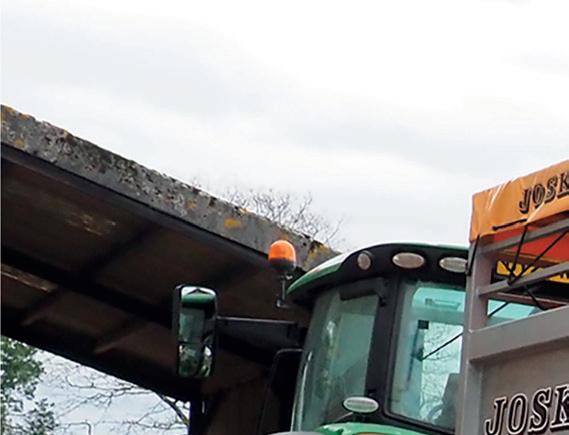
Manor Farm, which is situated in Cuxham, Oxfordshire, is a mixed arable and beef enterprise on 360 hectares; a combination of owned and rented land. Cross-bred cows in the 150-head herd are put to a pedigree Aberdeen-Angus bull,

and the regime is soon to switch from autumn- and spring-calving to spring-only to cut the labour requirement. Some 50 calves are weaned at nine months and then sold on as 12-month-old stores.
As well as the home farm, there is a second site at Milton Common, eight miles away, and the cows may overwinter or graze there before coming back to Cuxham to calve.
They are also transported to the local cattle market at Thame.
“I wanted to find a trailer that would allow me to get the cattle movements done in a morning and then focus on other jobs,” says Mr Nixey.

livestock trailers, so in the end it was a choice between the two.
“The Rolland was longer, but also more expensive, and the Joskin had more of the features that I was looking for.”

“I looked at a box to go on top of a bale trailer, but you end up with a steep ramp which I do not like.
“Our two local dealers sell Rolland and Joskin purpose-built, tractor-drawn








Joskin’s six-metre long Betimax RD 6000 was chosen, which features a ‘reclining’ system, using double-acting rams to lower the trailer body to the ground and give a loading height of 140mm compared to the transport height of 630mm.


Mr Nixey says: “There is no ramp and the cows load really easily. Most of them just walk
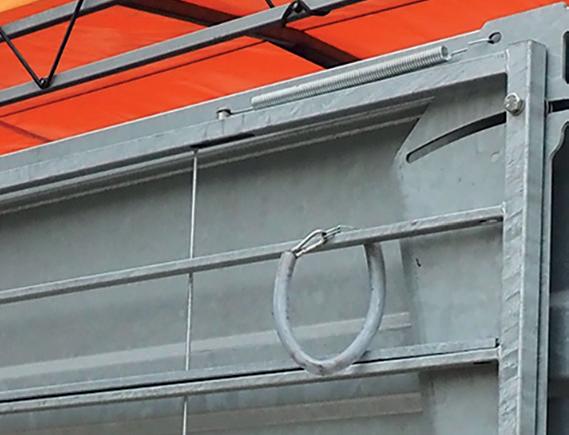
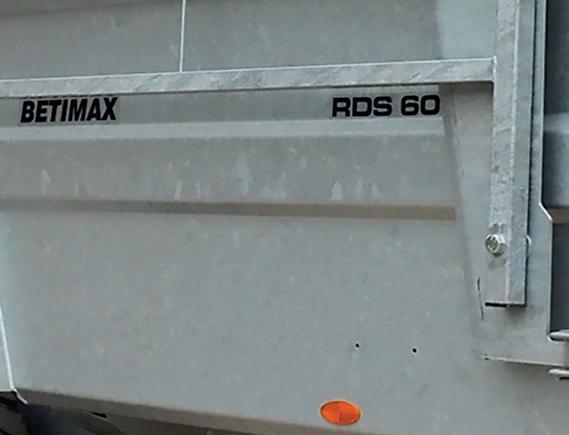
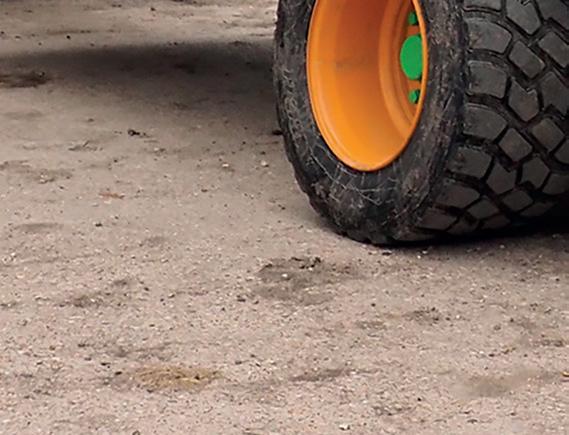
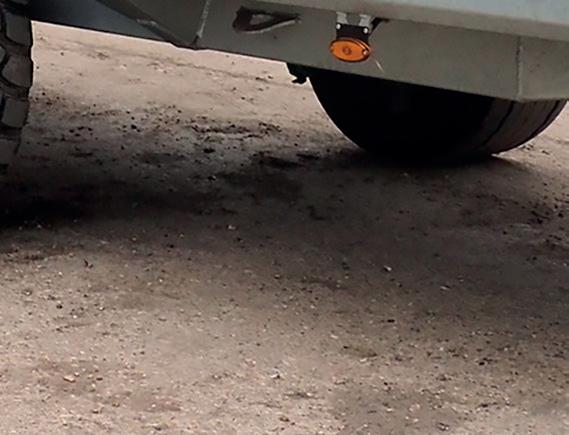
in, and it is much safer. There are also gates which swing round to help guide them in if necessary, although we have got quite good loading facilities so we really only need them if moving the bull.”
Mr Nixey specified a galvanised finish for durability and ease of cleaning, and this option comes with a resin floor.
“It is anti-slip and the cattle seem very secure on it. Plus, as it is not shiny, that also encourages easy loading,” he says.


As is typical of this design, the wheel arches protrude into the body, but are rounded off and smooth to avoid injury.
“You do lose a bit of space but I have had no problems so far with
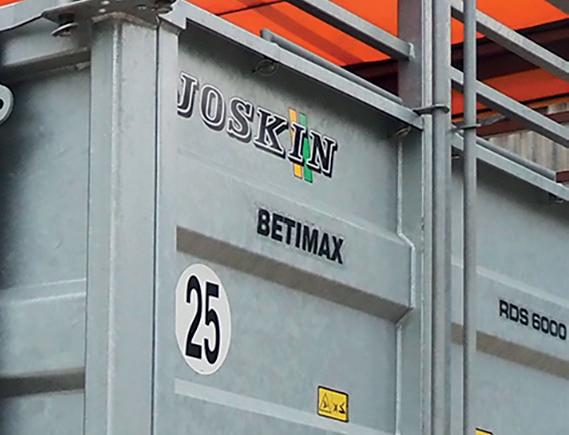






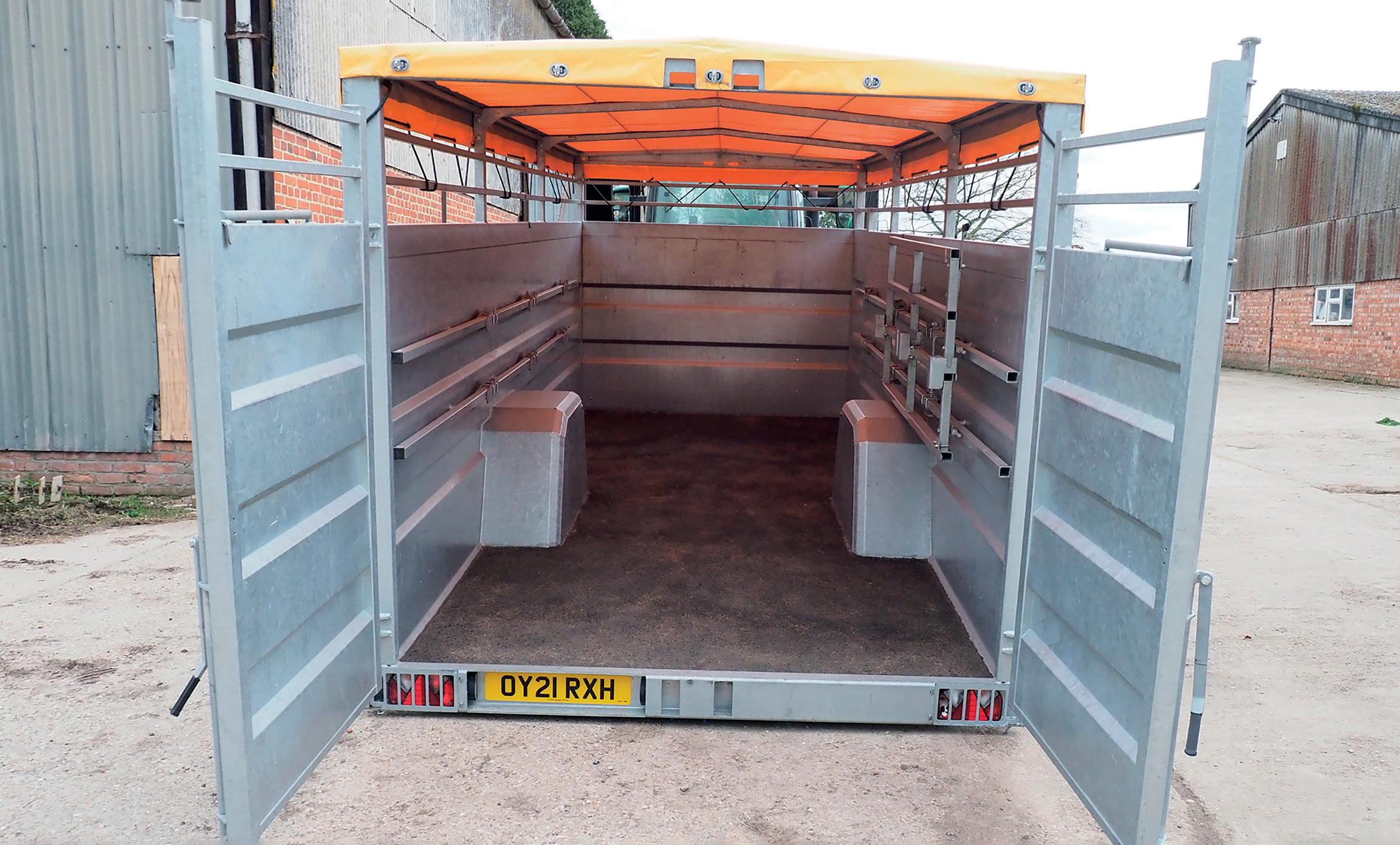
TRACTOR-drawn livestock trailers come under the same construction and use regulations as other agricultural trailers, covering items such as brakes and lights.
Red Tractor Certification has a number of requirements for livestock trailers. These are based on the vehicle being fit for purpose: appropriately designed, constructed, maintained and operated to prevent injury to livestock.

■ Avoidance of sharp edges or projections inside the trailer
■ Non-slip flooring
■ Partitions appropriately designed, constructed and positioned
■ Effectively ventilated
■ Roofed to protect animals from inclement weather
■ Constructed from surfaces that can be easily cleaned
Although the Joskin trailer represents a significant outlay, it has been worth it for the time savings. Plus, it is an investment that should last years
FRANK NIXEY













animals catching themselves,” says Mr Nixey.
There is an internal gate to separate the body into two pens, and it is fitted with a vinyl cover to offer the animals protection from the elements; a requirement for moving cattle to market.
Mr Nixey says: “It stays on all the time for convenience, although it was blown off in a gale. But it is obviously very robust as it was completely undamaged. We have had no issues at all with build quality in this first year.
“The trailer is well-thought-out all-round: the gates pin back
securely and include an extra strut that can be slotted into place to fill the gap at the bottom if needed, and the twin doors – which also have stays – offer some protection when loading.”
An access door at the front of the trailer allows safe entry or exit for the stockperson, although Mr Nixey says that it would be more convenient on the nearside than the continental offside.
With the body tipped, washout water flows to two drain holes at the rear; an inner edge to
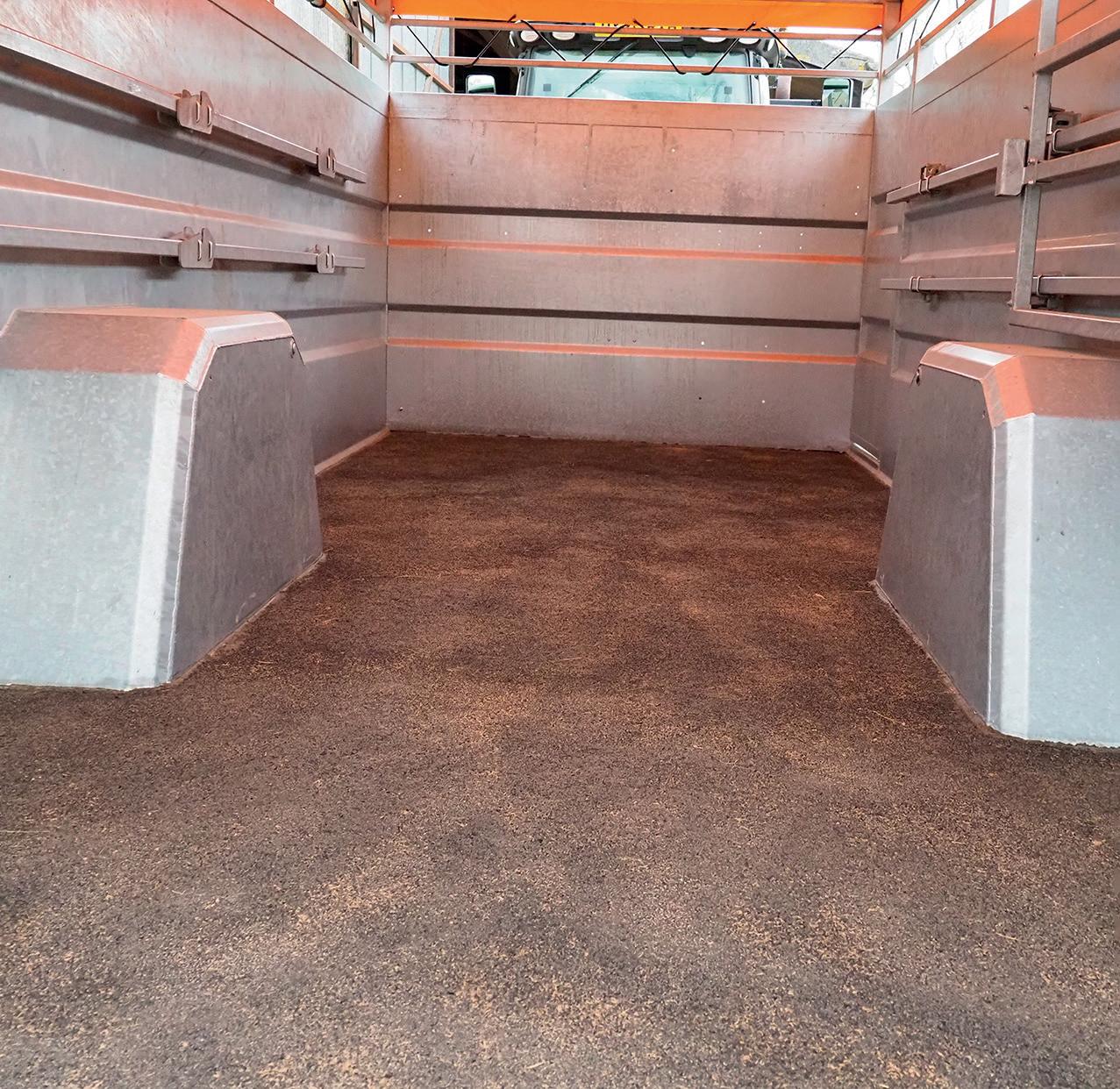




the rear of the trailer prevents faeces leaking out while driving.


The hydraulic axles are specced to 50kph with air over hydraulic brakes, and wide tyres give good flotation if loading up and travelling in the field, says Mr Nixey.
A sprung drawbar means that it travels nicely on the road, he adds, although it can bounce a little when empty.
Specification also includes LED lights that are well-guarded –despite one errant cow which has managed to kick a lens out.
Maintenance is straightforward, with the hydraulics just having
THERE are a number of options for transporting cattle, sheep or pigs, all of which come with pros and cons. An aluminium trailer pulled by a four-wheel drive vehicle is often the most convenient and economical choice unless, like Mr Nixey, you have larger numbers to move.
Farmers Guardian spoke to one farmer whose choice for less frequent movements would be to hire a lorry or use a transporter.
Many old cattle trucks are still doing sterling service and would have been a good investment for the farm over the years, but


a few grease points.
The Betimax can hold 10 to 12 one-year-old animals, four or five cows and calves, or six to eight cows.
Mr Nixey says: “I can take a batch of 20 of the 12-month-old Angus cross heifers to Thame market in two loads of 10 for a Friday sale – previously, I would have had to split them into batches over several weeks.
“We have kept the Ifor Williams as it is handy if I want to move the bull around, for example, and although the Joskin trailer represents a significant outlay, it has been worth it for the time savings.
“Plus, it is an investment that should last a good many years.”
rising service costs and even emission charges have to be a consideration now.
A box on a bale trailer is another possibility, but the inconvenience of fitting the box when it is needed, plus the steep ramp, are downsides.
Self-build is an option for this, but ensuring the chassis is roadlegal and fit to carry live cargo is a must.
A dedicated livestock trailer that makes use of the pulling power of a tractor could mean a significant outlay – Joskin quotes £22,784 for the Betimax RDS G 6000.


John Deere continues to move forward in its transformation to become a leading technology company with its new S7 combine range. James Huyton reports.


J OHN Deere recently launched its latest S7 variant to its combine range and readers, familiar with the brand, will notice certain visual design characteristics based around the brand’s flagship X9.
There are considerable updates to the operator cabin styling, bringing it in line with the manufacturer’s aforementioned flagship range.
John Deere claims that updates to the S7, including its latest engines and advanced precision agriculture features from the larger X9, will boost productivity and output.
Four models will make up the new range of combines, with the entry level S7 700, powered by a nine-litre JD9X engine. The S7 800, 850 and 900
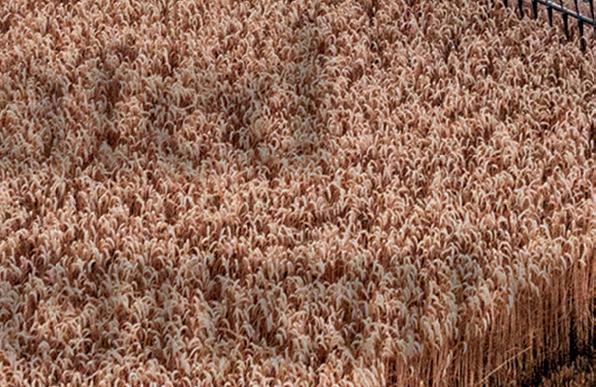
variants will be powered by the same 13.6-litre JD14X engine that powers the larger X9.
John Deere also claims the JD14X engine with ‘HarvestMotion’ is capable of achieving maximum power at a reduced engine speed of 2,000rpm; with the lower operating rpm potentially having benefits to fuel consumption.
Incorporating the same cabin from the flagship X9 also brings with it certain technological refinements.
It features the G5 Plus CommandCentre, with functionality to the brand’s AutoTrac guidance system, allowing further interlinked automation and record-keeping through the manufacturer’s DataSync system.
Integrated into the cabin roof, John Deere’s latest StarFire receiver gives a claimed 25mm pass-to-pass accuracy.
Aimed at improving unloading

efficiency, John Deere has also given the S7 an adjustable augur spout, controlled from the cabin.
Focusing on precision agriculture in recent years, the manufacturer has made considerable strides with linked fleet control.
The latest S7 will be no different, taking this advancement and putting it into operation through the JDLink system, which is capable of linking

both harvester and tractor for simultaneous on-the-move automated unloading.
John Deere claims the S7 will also introduce further advancements with predictive ground speed automation.
Using a system of cameras and satellite imagery, the manufacturer claims the S7 has the capacity for automated real-time adjustment of forward speed to suit crop conditions.

SOUTH West-based John Deere dealer Masons Kings was recently recognised for its 40 years of industry service.
Presented with the award of recognition by John Deere division sales manager, Joedy Ibbotson, Roger Prior, owner and director of Masons Kings, said: “Masons Kings
remain committed to its steadfast motto — providing premium support for premium products.
“This commitment not only reflects our past achievements, but serves as a guiding principle for future endeavours in serving and supporting the needs of our valued customers and the community.”

COMPLIANCE can be achieved at a basic level by simply switching to EID cattle tags at an increased cost of about £1 per unit compared to standard visual tags, says Mr Mackey. Producers who also keep sheep will already be familiar with the system, as it was introduced for the national flock more than a decade ago.
Mr Mackey adds: “An option beyond entry level tagging is to
SOME systems will transfer data automatically between the tag reader and the software programme, while others require manual intervention to prompt data downloads, says Mr Mackey.
The software programmes can turn raw figures into detailed graphs to show the weight gain history of calves from individual cows, for example.
Mr Mackey says: “This information is much more in depth compared with more standard records which show average cow and calf weight over a 12-month period.

THE timing for mandatory cattle EID has not yet been announced, but it is expected that authorities in England, Scotland, Wales and Northern Ireland will introduce the new rules either late this year or in 2025.
include tissue sampling capability, which will increase the cost by a further £1/unit. It is the ultimate form of identification for calves, and samples can be tested for genomic profiling, disease profiling and as proof of dam and sire.
“In Ireland, tissue sample tagging is part of the national BVD [bovine viral diarrhoea] control programme, and the system could be replicated elsewhere.”
“It can be used to help with breeding decisions that can improve herd profitability.
“Scanning results can be inputted to produce a picture of fertility performance at herd and at individual animal level. Some wand readers and handheld readers can manage additional data like vaccination and worming treatment dates.
“Software applications used to be web-based, but smartphonebased systems are now the norm.
“Access to the relevant software will generally require a monthly subscription, at a cost to the business of about £20-£30 a month.”
January 2023.
Mr Mackey says: “The programme for the rest of the UK has not been confirmed, and we could see different timings for each country. This could possibly cause issues when cattle are being traded across borders.”
MR Mackey anticipates that some producers will invest roughly £500-£1,000 in an EID tag wand reader or a handheld reader. Another option is to buy a handling system with a panel reader for scanning EID tag information, or to have one retro-fitted.
He says: “EID tag reading on-farm is not compulsory, but it comes with a range of potential benefits. The major advantage is
CONNECTIVITYpresentsoneofthe mainchallengestosystemoperation, saysMrMackey.
“Itcanbeveryfrustratingifthe operatorhasproblemswithgetting thewandreaderto‘talk’tothe smartphoneorofficePC,forexample. Forthatreason,itisbesttoask detailedquestionsaboutaftersales supportwhenenquiringabout purchasingtheequipment,”headds.
“Themostcrucialaspect,in practicalterms,istomakesurethat thereisaphonenumbertoringif thingsgowrong,andthattherewillbe anexperton-handtoanswerqueries.
“WiFiandmobilephonesignal strengthareoflessersignificance becausemodernequipmentwill
saving time. Depending on the system, the reader can automatically send data to the farm’s existing software management programme to update animal movement records and other official information.
“EID tag reading is fully traceable and removes errors in the system. It eliminates the need for paperbased recording, which can be challenging in a practical situation.”
communicateviaBluetooth.Theonly timethatpoorsignalstrengthcan interferewiththeprocessiswhen dataisbeingsentovertheinternet toGovernmentsitesliketheBritish CattleMovementSystem.
“Nevertheless,mostfarmshave adequatebroadbandspeedfor sendingdatafromEIDsystems.
“Somecrushloadbarswill haveaphysicallywiredconnection tocommunicatewithweighheads, whileothersoperateviaawireless connection.Ifawiredconnectionis felttobeofbenefit,theequipment shouldbeselectedaccordingly.
“Thenewkitmayalsoneedtohave thepotentialforintegrationwithexisting softwareprogrammes,”hesays.
WHEN sheep EID tags were introduced to the regulatory system, some producers initially complied with the tagging rules and then later found there were potential benefits in extending the technology further, says Mr Mackey.
He adds: “Future-proofing should also be considered when purchasing equipment. Anyone who prefers to keep their options open should probably prioritise Bluetooth functionality, which will facilitate add-ons.
“Some weigh heads have this capability and some do not, so that is another question that should be asked of the seller.
“However, I appreciate that there will be a percentage of producers who only want to buy basic EID tags in order to comply with the law.
“Everyone has a greater or lesser degree of interest in using technology, but it is common to find that users will grow in confidence as they become used to a new system.”
Equally important to the choice of equipment is handling the generated data, says Mr Mackey.
“The amount of electronic data that is generated can be overwhelming, and it must be streamlined so that it can be translated into a benefit for the farm business,” he adds.
“Software systems can create dashboards and graphs with the figures in various ways, so it is worth studying how the information is going to be presented before making a final purchasing decision.
“The key is to ensure that the business does not end up with huge amounts of unmanaged data that has no useful purpose.”
LOAD bars can be added to the cattle handling kit to allow the automatic download of cattle weights to farm records, says Mr Mackey.
More sophisticated set-ups can include gate systems for auto-drafting.







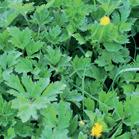
EID tag reading is fully traceable and removes errors in the system. It eliminates the need for paper-based recording, which can be challenging in a practical situation
JOHNNY MACKEY

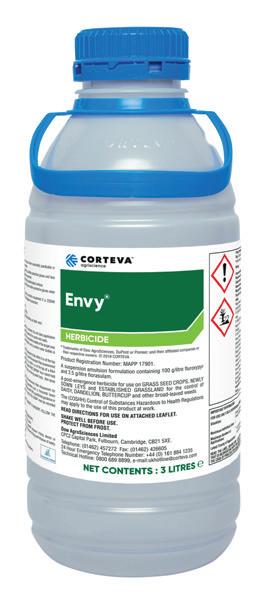
Aims of health risk management on suckler farms can be to optimise the fertility, animal survival and growth rates over each single production season. Farmers Guardian reports.
MEASURABLE gains in livestock health can be valued in various ways; healthier animals enjoy much higher welfare, take less time to manage, improve the mental health of stock-workers, have a lower carbon and environmental footprint and use less antibiotics.
Tim Geraghty, SRUC veterinary investigation officer, says: “No system is risk free and consistently achieving health gains is not easy and requires a collective team focus on long-term strategic planning, mid-term risk reviews and ensuring the routine daily tasks are always done right.
“Putting a monetary value on livestock health risk can be an interesting exercise to help ensure health risk management always gets prioritised.
“One quick and easy way to do this is to estimate the total herd value at weaning for both best-case and worst-case scenarios. The dif-
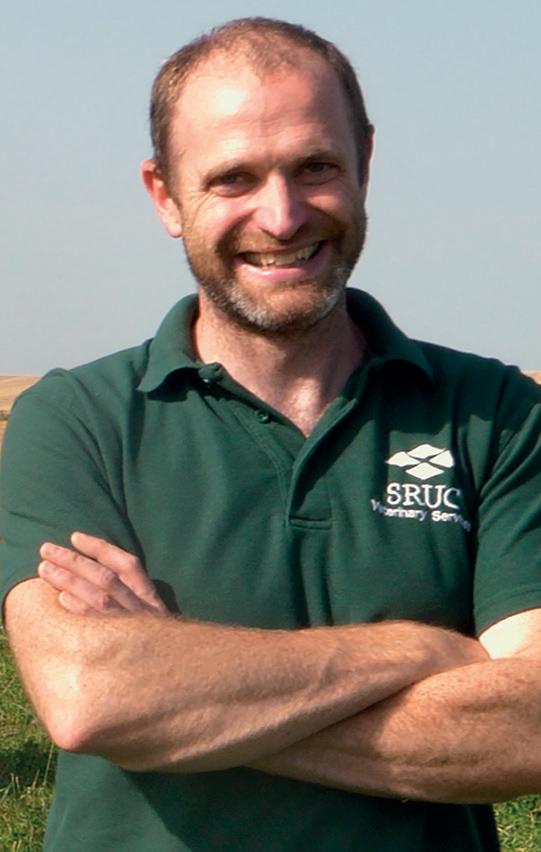
ference between these two figures is the financial value of health risk that the team, the herd and the business faces.
“Knowing what this figure is can help keep the team focused on why it is so important to practice good preventative risk management
Putting a monetary value on livestock health risk can be an interesting exercise to help ensure health risk management always gets prioritised
TIM GERAGHTY
among everything else that is competing for their attention.”
To get started, Mr Geraghty suggests estimating what the per kilo liveweight value of the calves will be at weaning and the approximate value of a replacement breeding cow. As an example, use a 100-cow
TO prevent lead and copper poisoning this grazing season, farmers are being urged to follow five steps.
The steps encourage farmers to check farmland for discarded materials, including electric fence batteries and flaking paint, that are sources of lead poisoning, as well as being mindful of the causes of copper poisoning in sheep.
If exposed, lead can be highly toxic to cattle, causing severe pain, convulsions, blindness, and can very often be fatal.
Stuart McAdam, Food Standards Scotland head of incidents, says lead poising can have a devastating impact and can put consumers at risk.
“Lead is a highly toxic metal which can cause slow or stunted growth, blindness, infertility, birth defects and death. Not only are the health impacts on livestock


herd, with market values of £3/kg liveweight for a weaned calf and £1,750 for a replacement heifer, respectively.
Mr Geraghty says: “Next, estimate the best-case and worst-case outcomes for fertility. Keep it simple by just estimating a ‘percentage pregnant’ value for whatever the herd breeding window is.
“When we have run this for farmer groups, the range for a typical 10- to 12-week breeding is often from around 70 per cent [worst] to 95 per cent [best].
“We will assume that cows that are empty will need to be replaced for half the value of a breeding female, to account for the cull sale value.
“Now estimate best-case and worst-case outcomes for adult and calf survival. Typically, we find that farmers estimate adult survival might range from 99 per cent [best] to around 92 per cent [worst] and we assume these are dead losses to the business.”
FOOD Standards Scotland recommends the following five steps to avoid lead and copper poisoning this grazing season:
1 Check that vehicle and fence batteries are stored securely and out of reach of animals
2 Check fields and fences for fly-tipping before putting animals out to pasture
distressing, but there are financial implications such as veterinary fees, carcase disposal and loss of market value.
“Contaminated meat, offal and milk containing lead at levels above legal limits is unsafe and illegal to sell. In addition, there is a
3 Check buildings and equipment for old lead paint peeling off
4 Check what feed sheep have access to. Some concentrates and minerals are for cattle only
5 Check the supplements are right for the sheep, as breeds such as Texel, Suffolk and North Ronaldsay are more susceptible to copper poisoning
minimum 16-week withdrawal period which can cause delays across supply chain and incur costs for testing.”
Incidents of lead poisoning, which are primarily caused by lead batteries, old paint, bonfire ash and fly-tipping, often peak in spring when cattle are put out to pasture.
Best-worst case calf survival can be broken down to abortion (0.5-5 per cent), stillbirth (1-10 per cent), losses in the first week (1-8 per cent) and older losses (0.5-5 per cent).
“Using these approximate figures would give a cumulative best-case scenario of 3 per cent calf losses, but a scary, and thankfully unlikely, worst-case of 28 per cent,” Mr Geraghty says.
Estimating best- and worst-case growth rates to weaning, or 200 days in less seasonal systems, can generate a lot of discussion between farmers, adds Mr Geraghty.
There are differences of opinion about what is ‘optimum’ and system type and breed can have a big influence. A typical value for ‘best’ might be around 1.25kg/day and worst-case as low as 0.7kg/day.
Mr Geraghty says: “Having set up best and worst cases for each
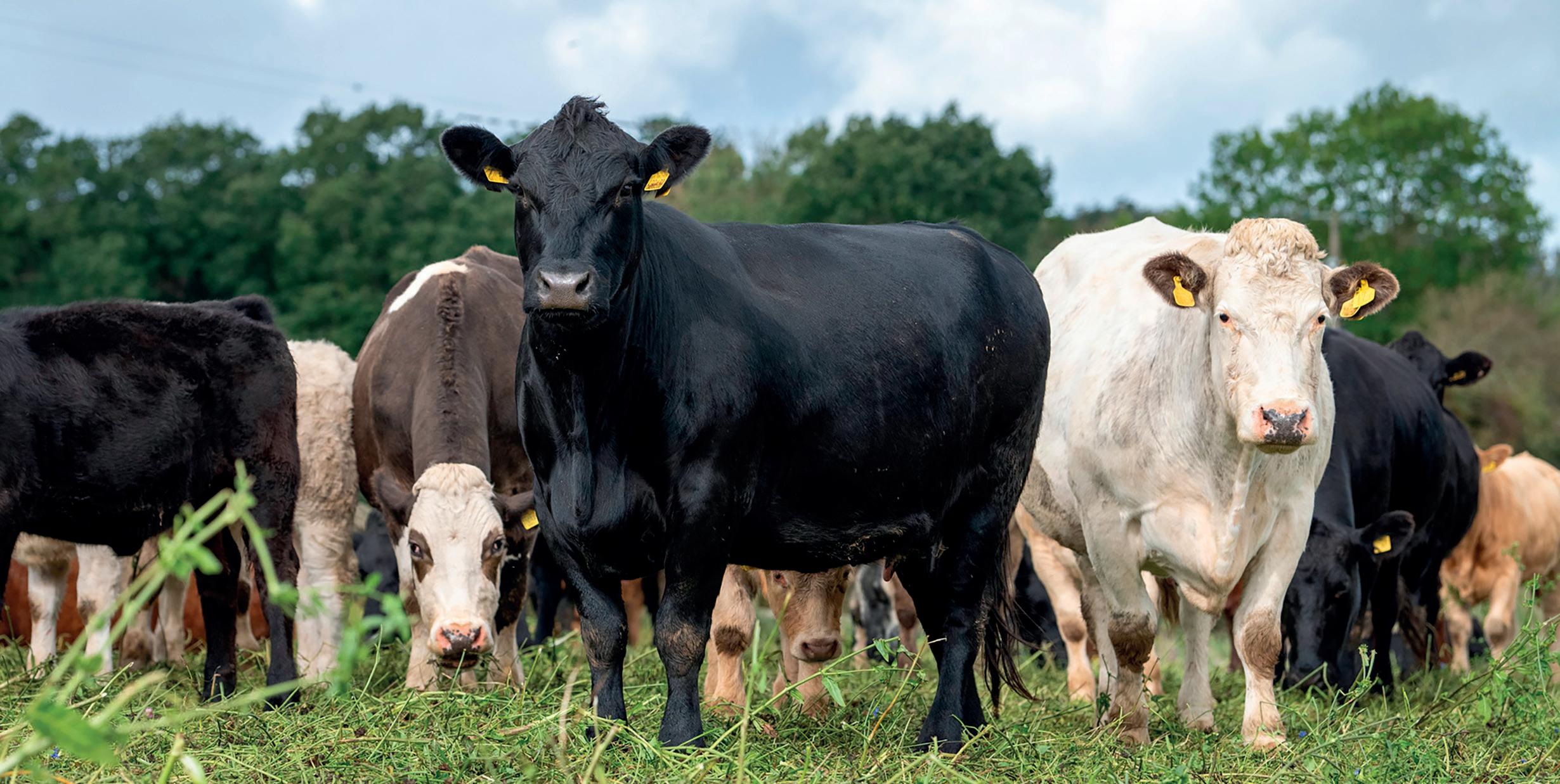
category, bring it together to look at total herd valuation on day of weaning. Work out how many calves you will have, at what weight, and their total value.
“Add this to the residual value in the cow herd that survives to weaning. In the best-case in our worked example, where fertility has been excellent, losses very low and high growth rates achieved, the herd would have a total herd valuation of £255,782 on the day of weaning. Meaning if the entire herd was sold that day that would be its approximate value.
“In the worst case, with many fewer, lighter calves and less adult cows in the herd, this would drop to £189,014. The difference between the two is the risk valuation, and sits in our example at £66,768, or more than £650 per cow in the herd.”
Mr Geraghty says in reality, the worst-case scenario is very unlikely to occur, but achieving best-case consistently is also very rare.
However, he adds the challenge is to land as close as possible to the best-case in the given year, with all of the unique strengths and weaknesses of your system, and the challenges and opportunities that come with the given season.
“I am an advocate for breaking the year down into more manageable blocks to keep things focused.
“One team discussion on health risk management, ideally including your vet and focused on the immediate health risks facing the herd delivers real gains in very little time.
“Timing can vary, but pre-winter, pre-calving and pre-breeding work very well. With a risk valuation of £650/cow it is time well spent, and by keeping that money on-farm we also safeguard welfare, the environment, our teams’ wellbeing and will reduce antibiotic use,” he adds.

Give your lambs the best start with our high energy and high protein lamb creep.
Hitting the market at the right time can make a significant amount of difference in the value of a lamb. Our team are here to help and can improve your margins this season with a profitable finishing program.
Ewbol Prestige Lamb promotes high growth rates and feed efficiency. Suitable for creep and intensive lamb systems.
9 High in digestible fibre and starch for high DLWG.
9 18% protein, high DUP to promote muscle growth.
9 Addarome flavour enhancer to stimulate higher intakes.
THE debate over whether UK flocks should be vaccinated against avian influenza still goes on across the industry, said Gordon Hickman, head of exotic disease control at Defra.
Speaking on behalf of the joint industry and Government vaccination taskforce group, Mr Hickman said the group had been studying the vaccine strategies on the continent, particularly in France, where there has been a mandatory vaccination of meat ducks for 12 months involving 64 million birds.
However, he said there had still been two cases in vaccinated duck flocks.
He said: “So we have seen that a vaccine is not a dead cert.”
Mr Hickman reminded the seminar delegates that current rules in England mean that only zoo birds meet eligibility criteria for vaccination following authorisation from APHA.
And Mr Hickman said this existing legislation meant it might be
Poultry farmers and industry experts attended this year’s NFU poultry research seminar to discuss the latest news in the poultry industry. Ellie Layton reports.
difficult to roll out a vaccination plan quickly.
He said the taskforce group had been assessing what they wanted from a vaccine, with the primary focus being on keeping trading doors open and also receiving acceptance from poultry consumers.
Mr Hickman said that a blanket vaccination policy would mean an increase in demand for vet visits and the taskforce group did not believe that the cost benefits would stack up.
Vaccinating UK poultry flocks for avian influenza has been described as ‘cost-prohibitive’ because an EU surveillance
Scotland
14.7kgdrymatterperhectareperday (5.9kgDM/acre/day) 29.1 6.3 20.9
The North 31.4kgDM/ha/day (12.7kgDM/acre/day) 30.3 8.0 16.7
Wales
16.2kgDM/ha/day (6.6kgDM/acre/day) 28.9 8.3 35.1
The South 28.6kgDM/ha/day (11.6kgDM/acre/day) 32.9 9.3 14.7
Grass growth Soil moisture (cb)
Soil temperature (degC) Rainfall (mm per week)

Region Seven-day forecast 14-day forecast
NorthEngland 29kgDM/ha(11.7kgDM/acre) 32kgDM/ha(12.9kgDM/acre)
SouthEngland 35.5kgDM/ha(14.4kgDM/acre) 36.4kgDM/ha(14.7kgDM/acre)
Scotland 21.7kgDM/ha(8.8kgDM/acre) 21.7kgDM/ha(8.8kgDM/acre)
Wales 34.1kgDM/ha(13.8kgDM/acre) 32.8kgDM/ha(13.3kgDM/acre)
Dry matter 19.1 per cent
Metabolisable energy 11.2MJ/kg DM
Crude protein 19.8 per cent
Sugars 9.9 per cent
requirement for swabbing and testing, including 60,000 extra vet visits in the UK, would set producers back £1,500/month for every shed housing immunised birds, significantly straining profit margins.
Although the cost of the vaccine itself and its administration is unlikely to be high, the EU has set a high bar for its trading partners on testing flocks to ensure there are no ‘silent’ infections circulating in vaccinated flocks.
Mr Hickman said surveillance was the ‘real killer’ in relation to the cost benefit of vaccination.
“If we follow the requirements
If we follow the requirements the EU has set out ... it is very prohibitive in terms of cost GORDON HICKMAN
the EU has set out for intra- and third-country trading, it is very prohibitive in terms of cost,” he said. And he said it was the cost that
BULLETIN 1
Week beginning March 25
n As we enter the grass growing season, a quick recap of GrassCheckGB 2023 (see graph above) shows that the average yield was 8.8 tonnes of dry matter (DM) per hectare (3.6t DM/acre), which was above the four-year average of 8.3t DM/ha (3.4t DM/acre) despite a dry summer
n Looking at the current season’s data, the growth rate has just started going up in England (both North and South), with Wales forecast to follow shortly over the next fortnight
n Test your soil if you have not done so already and build a robust soil nutrient management plan for the whole season
GrassCheckGB is a collaboration between the Centre for Innovation Excellence in Livestock, Agri-Food and Biosciences Institute, Rothamsted Research, AHDB, Hybu Cig Cymru, Germinal, Handley Enterprises, Sciantec Analytical, Yara, Pilgrim’s UK and Quality Meat Scotland. Regular updates will appear in Farmers Guardian.
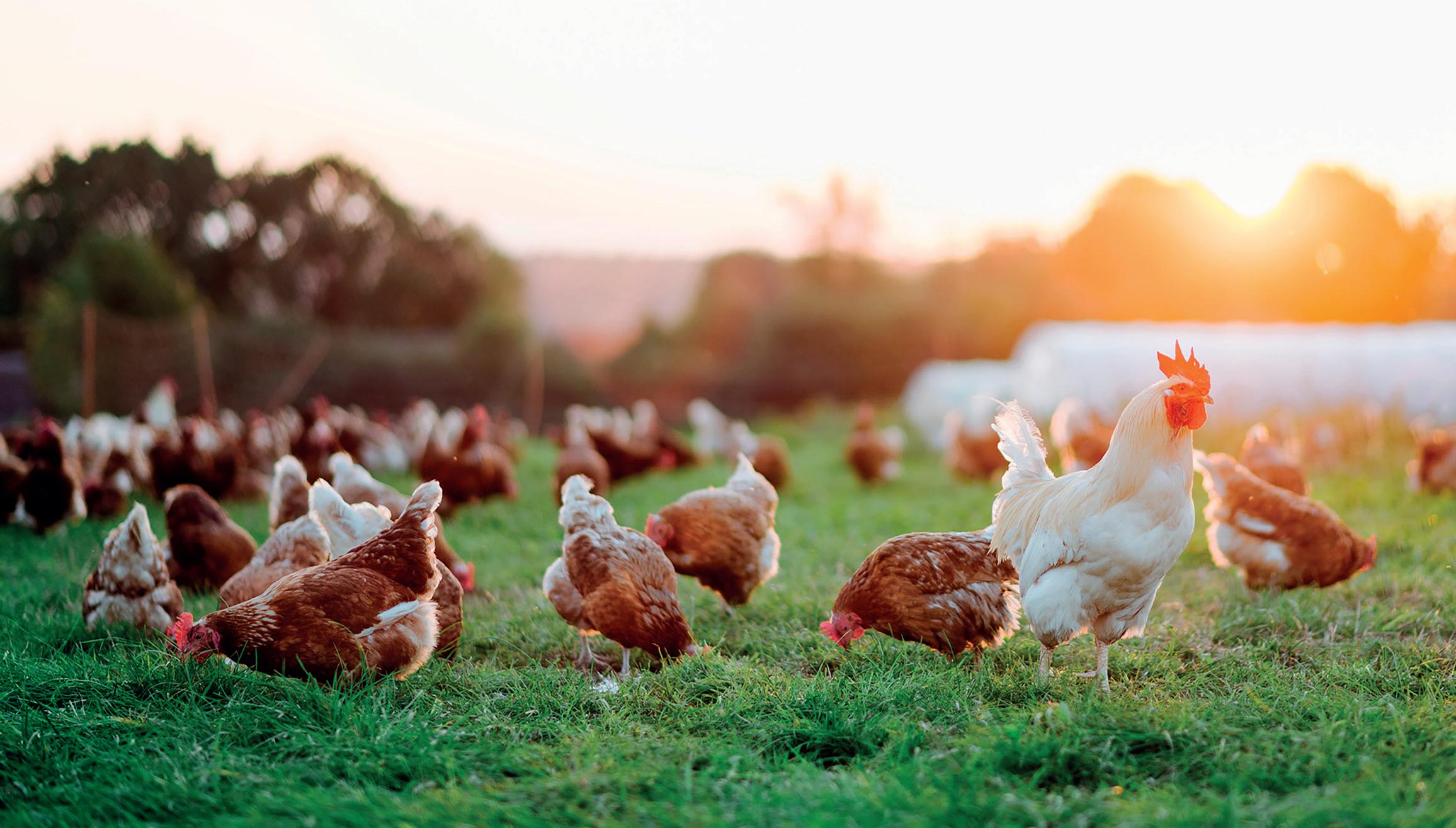
had made producers doubt the vaccination concept the most.
Mr Hickman said a poll of poultry producers at the British Free Range Egg Producers Association’s most recent conference reflected current opinion on vaccination.
“Before producers were advised of the cost and other considerations, a show of hands confirmed about 90 per cent would consider vaccinating their own flocks, when they were later polled, not a single producer appeared to support it.”
IN order to better protect the UK poultry sector from avian influenza, poultry registration is now compulsory for all flocks regardless of flock size.
Gordon Hickman, head of exotic disease control at Defra, said this would mean all poultry keepers receive important updates relevant to them, which in turn, will help manage disease outbreaks.
Surveillance
Mr Hickman said: “The information on the register will also be used to identify all bird keepers in disease control zones, allowing for more effective surveillance so that zones can be lifted at the earliest possible opportunity and trade can resume more quickly following an outbreak of avian disease in Great Britain.”
The changes follow the UK’s worst ever outbreak of avian influenza, with more than 360 cases across Great Britain since late October 2021, including
in a significant number of backyard flocks.
Bird keepers will need to officially register their poultry on the national register by October 1, 2024, and will have to provide contact details, the location where birds are kept and details of the birds including species, number and what they are kept for.
Currently, only those who keep 50 or more poultry must register, limiting the effectiveness of national disease control measures.
For Scotland, keepers should register from September 1, 2024, when there will be a new Scottish Kept Bird Register in place.
The requirements will be set out in legislation shortly and keepers will also be legally required to update their information on an annual basis.
Further information on the registration of birds and the form to complete can be found on gov.uk, gov.scot and gov.wales





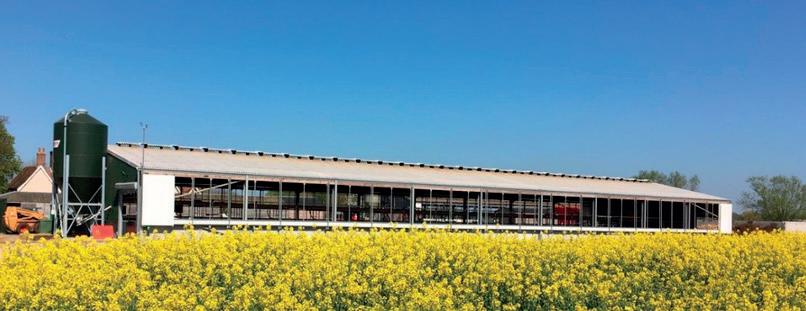



The Control of Worms Sustainably (COWS) group has launched a survey to find out more about lungworm and its treatment across the UK. Sara Gregson reports.
Cases of lungworm in cattle, caused by the parasite Dictyocaulus viviparus, remain high and may even be increasing. COWS is seeking to learn more about when outbreaks are occurring, what type and class of stock is most affected, what clinical signs are seen and how well animals are responding to treatment.
Helen Carty, veterinary centremanager for the SRUC and a member of the COWS group, says: “In recent years we have been aware of reports of suspected lack of efficacy of wormers to treat lungworm infections in cattle.
“But it can be very hard to determine if this is because the worms are developing resistance to the treatments, or if the treatments have just not been applied properly.
“Could the animals have been under-dosed or an out-of-date bottle of wormer used?
“Many farmers use a pour-on when they hear cattle coughing out in the fields. If the cough goes away it is presumed that the wormer has worked.
“If they cough again, what should a farmer do then? It can be hard to know if the cough is because lungworm are still present, or have the cattle devel-
oped a bacterial infection because their lungs have been damaged?”
Clinical signs of lungworm are most commonly seen in first-year grazing cattle in late summer and autumn, but can occur earlier in the year and increasingly in older and adult cattle.
The most characteristic clinical sign of lungworm infection is widespread coughing within the herd. Lungworm outbreaks can cause severe losses and even death.


MARK Pass, an SQP/RAMA who is also a member of the COWS group, advises all cattle farmers to remember the five ‘right’ ways of doing worm control, including for lungworm.
1 Use the right product which will target the specific parasite that has been identified. Test, do not guess for accurate diagnosis
2 Treat the right animal. There is nothing to be gained from treating animals that are not carrying parasites; in fact this is likely to hasten parasite resistance to products

3 Treat cattle at the right time. Monitor growth rates and take regular faecal egg counts throughout the grazing season,
which will offer guidance on the need to treat for roundworms
4 Dose cattle with the right rate. Ensure dosing equipment is well maintained, calibrated and clean. Weigh each animal to calculate the correct dosage
5 Administer the treatment in the right way. Farmers should read the product label always before treating and ensure the selected product is given in the correct way, for example, subcutaneous injection, oral drench or pour-on
Find out more by visiting the COWS website at cattleparasites.org.uk
As with many other parasitic nematodes, infection is acquired by the ingestion of infective larvae from pasture. The epidemiology is complex and outbreaks are often unpredictable.
Where lungworm is a known problem, there is no easy way to predict when lungworm will hit and waiting until coughing starts is less than ideal. Using a preventative vaccine will allow farmers to relax about what is arguably the most serious risk at grazing to youngstock.
The live vaccine, which is produced fresh each year, is given orally to calves aged at least eight weeks old. Two doses are given, four weeks apart. Vaccinated animals should not be mixed with unvaccinated stock or allowed to graze on pastures recently used by
COWShasdevisedapro-forma surveyhostedinSurveyMonkey availableontheCOWSwebsite forvetstofillinwiththeirfarmer clientswhentheycomeacross casesoflungworm.Thecollated, anonymiseddatafromthesurvey willbeusedtoformthebasisof futurediscussionsaroundtheissue.
Ifthereisasuspectedlackof efficacy,vetsareencouragedto ensuretheVeterinaryMedicines Directorateandpharmaceutical companyarenotified.Theresults ofthesurveyandsubsequent discussionswillbereleasedin2025.
unvaccinated animals until two weeks after the second dose, to allow immunity to develop.
In his MSc thesis looking at the lungworm situation in the UK, COWS member and suitable qualified person (SQP)/registered animal medicines adviser (RAMA) Mark Pass, found there to be many barriers for farmers using vaccination, including the cost, two-dose regime, timing of dosing and oral administration.
The residual effects of long-acting products or sustained release bolus preparations given to control other infections such as roundworms, may interfere with the development of immunity following lungworm vaccination. Therefore, farmers should avoid vaccination during the period of their activity, or not use them until 14 days after the second dose has been given.
Post-vaccination, natural infection by pasture larval challenge is also necessary to enhance the immunity induced by vaccination. Subsequent exposure at grass allows development of immunity against the adult stage worms in a controlled fashion.
Routine worm egg count tests do not detect lungworm, so vaccination is an added security where lungworm is known to be present on the farm.
ED Jones runs a mixed beef and arable farm on 50 hectares (123 acres) of owned land with further rented land, in the south west corner of Cheshire. Since finishing milking in 2006, he has moved the business into a range of enterprises, including the rearing of dairy beef calves. Along with permanent grassland, he also grows cereals including barley, wheat and beans to provide for his beef growing and finishing rations.
Mr Jones says: “I started off buying black and white store cattle from the markets, but have now switched to buying calves, all from one local dairy farmer. This has limited the amount of disease we are bringing in.”
The calves are from Irish Friesian cows that calve all-year-round and have been served by either Aberdeen-Angus or British Blue bulls. To begin with, they were castrated, dehorned and given an intranasal vaccine for pneumonia on arrival. But the stress of this combination created ideal conditions for coccidial calf scours,
The cost and effort of vaccinating the calves is much higher than using worming treatments, but this is more than worthwhile
ED JONES
Trust Ecosyl 100 additive to help conserve your silage. With its 1 million beneficial ‘MTD/1’ bacteria applied per gram of forage treated and 30-year track record, it’s been independently proven to boost ‘milk from silage’. www.ecosyl.com
which subsequently needed treating.
Mr Jones now delays castrating and dehorning until the calves have settled and has also switched to a medicated calf nut and the problem has subsided. Daily liveweight gains have returned to a more consistent level, reducing the number of days until the animals finish. Mr Jones aims for a minimum gain of 0.8kg/ day in the first 15 weeks.
The calves arrive on-farm at between three and four weeks of age and are milk-fed via a teat bucket twice-a-day. There is also chopped straw and calf pellets on offer, with intakes of these gradually increasing until they are weaned at six weeks of age.
There are currently 190 cattle housed on the farm in different age groups and when ground conditions allow the first and second season youngsters will go out to graze.
Two autumns ago, the herd suffered from rapid onset coughing in one group and three calves died. The vet confirmed these deaths were due to lungworm infection. Since then Mr Jones has always vaccinated calves with Huskvac to prevent this problem happening again.
“The vaccination regime takes planning, especially as we are taking in calves all year round,” he says.
“I start talking to my vet and SQP Mark Pass at Christmas about ordering vaccine and to get everything planned and implemented well in time for turnout.
“For example, for one group we give the first dose on March 3, the second dose on April 2 and then turn them out from mid-April.
“The cost and effort of vaccinating the calves is much higher than using worming

treatments, but this is more than worthwhile knowing we will not be losing calves to lungworm again.”
The first season grazers go out to the grass fields in the arable rotation which offers safe grazing, allowing a trickle of immunity to lungworm all summer before coming inside in the autumn to either grow on or to finish.
Faecal egg counts are taken every month in summer to check roundworm levels, and animals are treated if the results show more than 200 eggs per gram. A very small group that graze away from the home farm are treated with Moxidectin 10 per cent LA, given more than two weeks after the lungworm vaccination course is complete.
This deviation from ‘best practice’ is because they cannot be routinely monitored while away at grazing. All animals have a dose of ivermectin against roundworms at housing to remove any roundworms and lungworm that remain.
Finished cattle are picked out every three weeks and sold direct to Dunbia, weighing 650-700kg liveweight and grading out at mostly R, with many also achieving U-grade.

A growing number of conventional suckler herds are managed extensively on systems which follow basic organic principles. Wendy Short reports.
Vet Dr Rob Hall, of LLM Farm Vets, explains the implications for veterinary medicine usage for suckler producers considering organic conversion.
One common misconception is that organically managed herds cannot be vaccinated against the major diseases.
Dr Hall says: “The Soil Association, for example, encourages a holistic farming approach. In terms of animal health, this means a focus on disease prevention through careful nutritional management, lower stocking density and slower growth rates for beef systems.
“There is a strong emphasis on disease prevention, and vaccination can play a key role. It has the potential to greatly reduce the need for antibiotic medicines, which should be kept to a minimum.
“Therefore, vaccinations of all types are permitted by the organic standards, as long as they are used in conjunction with disease prevention measures.”
Anthelmintics can be used for cattle, but there is a requirement to demonstrate the need.
“Wormers should not be given just because the cattle have lost weight, or there are signs of loose dung. A faecal egg count should be conducted to confirm the need for treatment.
“The low stocking rates which usually apply to organic production help to minimise the risk of worm infestation. A well-thought-out worm prevention strategy must be part of the herd management plan, if anthelmintics are used,” says Dr Hall.
The restrictions surrounding reproductive treatments are frequently misconstrued.
He says: “Organic producers who have recently converted to the system are often under the impression that there is a blanket ban on the use of hormones.
“While oestrus synchronisation is not permitted, some measures related to absence of heat are exempted. A cow can be given medication to treat a cystic ovary, for example. Another permitted intervention is for the treatment of a uterine infection.
“The greatest risk period for infection and reproductive disorders in cows is following a difficult calving.

In accordance with the preventative principles, breeding for easy calving will help reduce the chance of reproductive issues. Carefully managing the body condition score of dams throughout the year is another key factor for a successful breeding season.”
Anaesthesia and pain relief, in the form of non-steroidal anti-inflammatory drugs, can be used for treatment without obtaining special permission.
Dr Hall says: “In fact, they are encouraged – where appropriate –because organic standards aim for a high level of animal welfare. Sick animals must be treated at the earliest opportunity. They must also be clearly identified, and the most common way
Vaccinations are permitted by the organic standards, as long as they are used in conjunction with disease prevention
DR ROB HALL
to comply with the rules is to use a marker spray or tail tape.”
The approach to feeding supplementary vitamins and minerals differs from standard production systems, he says.
“The priority for organic herds is to take steps to ensure that the livestock receive most of their required nutrition from forage, mainly in the form of grazing and including herbal leys.
“Vitamins and minerals must have come from natural sources, wherever possible. Synthetic products are restricted, and the governing bodies provide a list of approved substances. Producers will need to provide evidence of a deficiency before any action can be taken,” adds Dr Hall.





A cow which has received more than three courses of medication (excluding vaccination and parasite treatments) within a 12-month period will lose its organic status, along with any unborn calf, he says. To restore the calf’s organic status, it will have to undergo the conversion period.
Any medication that is administered must be used with reference to the extended withdrawal periods which are applicable.
Dr Hall says: “The withdrawal periods for animals that are entering the food chain are doubled, compared with the number of days which apply to conventional production.
“Products with a zero-day withdrawal will require a minimum 48-hour withdrawal period, with the exception of vaccines which do not have a required withdrawal. This rule will need to be taken into account when the sale of cull cows or finished animals is being planned.”
The record-keeping requirements for organic production go above and beyond those which apply to the Red Tractor standards. They include the start and end date of treatments and the period of extended withdrawal, but the certifying bodies can provide templates, which make it easier to comply.
Organic certification for suckler


herds does offer opportunities for achieving a premium for beef sales, but producers must factor in the potential additional costs associated with the conversion period, adds Dr Hall.
“In England, the Soil Association conversion period for organic grassland is normally 24 months, although it may be shortened if the applicant can demonstrate that the land has been managed according to the standards before entering conversion. For livestock to be marketed as organic, their dams must have been
managed according to the standards for at least 12 weeks before calving.
“Organic cattle must have access to grazing whenever weather and ground conditions allow, and this commonly means an extensive production system.
“Coupled with the relatively high cost of certified feed that may have to be bought in, beef animals will generally take longer to finish, compared with standard production methods. These elements have to be
included in any projected costings including the conversion period, during which livestock cannot be marketed organically.
“Nevertheless, veterinary and medicine treatment for organic suckler herds is fairly straightforward.
“Farmers who are considering a move to organic production are often encouraged by the range of options for livestock treatment, once they have fully understood the practical application of the rules,” says Dr Hall.





Myerscough College in Lancashire is diligent when it comes to managing its 60-cow suckler herd, so it was a mystery when animals suddenly started to get sick.
Suckler cows presented with neurological signs, including wobbly gait, says the farm’s vet Ian Cure, of LLM Farm Vets.
He says: “They were not doing well in terms of appetence; we even lost one.”
Blood tests revealed they were deficient in selenium and copper, despite having access to mineral licks in fields.
In an attempt to restore herd health, in-calf cows and calves on the point of weaning were treated with Multimin™, a prescriptiononly trace mineral injection containing copper, selenium, manganese and zinc.
It is administered under the skin and it enters the animal’s bloodstream within eight hours, within 24 hours it is being utilised by the liver.
Ian says its long-acting effect coupled with it containing copper and selenium, the two elements the herd was deficient in, made it a good choice.
He says: “The initial problems we saw in appetence, wobbly gait, we have had none of that since. The sucklers have thrived and the calves have continued to grow.”
Although licks are seen as an easy method of providing cattle with trace elements, Ian says there is no way of knowing whether every animal has accessed these and is therefore getting what it needs.
Correcting trace element deficiencies by adopting a new method of supplementation has had a major impact on cow and calf health in the beef suckler herd at a college farm. Debbie James reports. Multimin™
“Licks are fine for the ones which take it, but if you have a number of animals in a field, you might not expect all of them to take the amount that they need.”
Although boluses can work well, there are shortcomings with these too, he adds.
“When you put a bolus in, hope-
fully it will stay in, but it may not. Boluses can be spat out and will the boluses cover what you need them to cover?”
An injectable provides that reassurance, Ian says.
“With an injectable, you can get them all and you know everything has been jabbed effectively and has had the correct amount of mineral for what they need.”



An injectable has practical benefits too, Ian adds.
“Farmers much prefer an injection and not having to wrestle with the head of an animal [when blousing], especially big things, such as suckler cows.
“It is a hell of a lot easier to just put them down the crush and then inject them.”
Amanda Waring is the red meat lead at Myerscough College, where she manages the suckler herd, which is made up of AberdeenAngus, Hereford cross and British Blue cross cattle.
For her, the ease of administration of Multimin™ is a big plus.
She says: “I am not a particularly tall person and bolusing an angry Angus can be quite a task.”
Injectables have welfare benefits for the stock too, Amanda says.
“I like to keep a cow which is incalf with as little stress as possible and, with this product [Multimin™], you can just quietly move them into the crush, give them the injection and quietly move them

out again. There is no wrestling to be done.”
Multimin™ is delivered in small amounts – 1ml per 50kg for animals less than one-year-old, 1ml per 75kg from one to two years old and 1ml per 100kg for animals over two years.
Since addressing the trace mineral shortfall, Amanda has noticed improvements across all age groups.
She says: “They tended to thrive after they had had the injection. Not only did they look much better in their coats, but I felt their appetite was better. It turned them around.
“They started looking happier and, because they were eating, they looked healthier and they were starting to finish quicker because they had their appetite back.”
Amanda has also seen a good response from giving it to calves at weaning.
“After being treated, they became
more settled more quickly on the diet they were on.”
The effectiveness of injectable trace minerals has been backed up by several major studies.
One involved suckler beef cattle being given a trace mineral injection pre-calving and before a fixed-time artificial insemination protocol¹.
The findings showed an almost 10 per cent higher conception rate in cows which had received the injectable compared to those which had not.
Although the overall pregnancy rate was no different, a greater proportion of the group which had the trace mineral injected calved in the first 21 days of the calving block compared to the non-supplemented.
There have also been studies involving calves on rearing units, an environment where the disease challenge can be quite high.

Findings have shown an almost 10 per cent higher conception rate in cows which received the injectable compared to those which had not.
Vet Kate Ingram, technical adviser at Virbac Animal Health, says those studies had shown administering injectable trace minerals had reduced pneumonia and scours².
Although Multimin™ is frequently used to correct a trace mineral deficiency, it is more widely used by farmers to give their animals a top-up ahead of periods of high demand, such as the transition period, weaning, disbudding and castration, or to maximise the response to vaccines, as it has been shown to increase immunity³.
Kate says: “Those periods of high demand will depend on an individual farm and their system, so I would recommend farmers speak to their vets about when the pinch points are, when their animals experience stress or higher rates of disease.
“It may be that Multimin™ can fit nicely into that system to help address those.”
It also sits well with the preventative approach now taken in livestock health, with every farm encouraged to reduce reliance on antibiotics as a cure.
Ian says that 20 years ago about 80 per cent of farm vet work would revolve around treatment, but that has now shifted to preventing conditions occurring.
He says: “It has swung to 20 per cent of our work being reactionary and 80 per cent prevention. It is about vets going out on farms, identifying a problem and putting in a solution for the future, predicting and preventing problems.
“At Myerscough College, we had a problem, we found the solution and now we have got it for the future.
“That is ultimately how farms are going to improve their productivity and overall profitability.”

A mixed livestock farm in Shropshire has a rich history in continental cattle, but recently has added native genetics to strengthen the system. Ellie Layton reports.
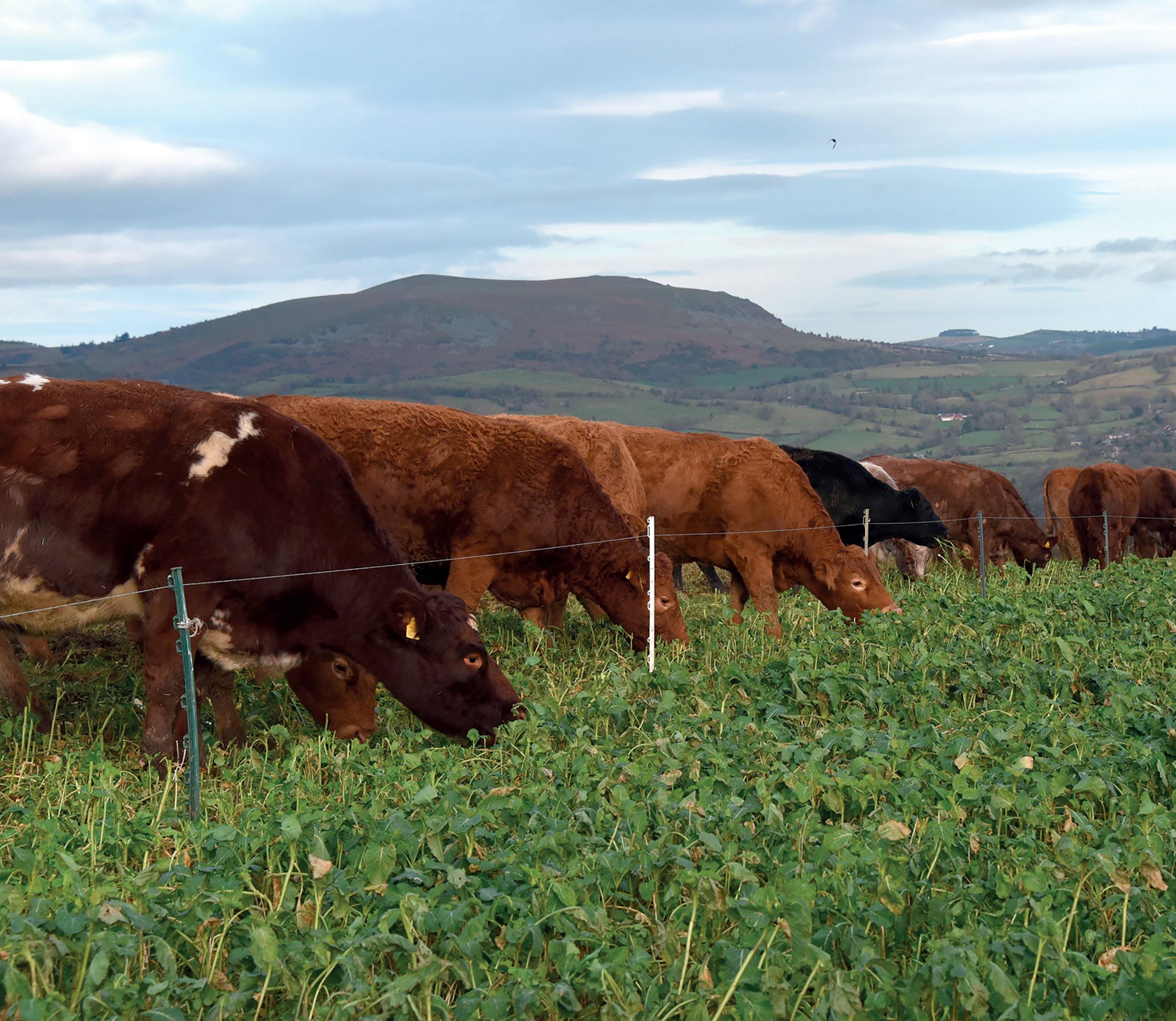

Simon Bedell runs Linch House, a 223-hectare (550 acre) farm near Bishop’s Castle, Shropshire, which is home to one of the oldest Limousin herds in the UK.
The farm peaks at 831 meters (1,250 feet) and straddles the English-Welsh border, with one field is split by the border.
Livestock is at the heart of the farming system as Mr Bedell believes it is key to a thriving farm.
The majority of the farm is made up of grassland with 162ha (400 acres) in permanent pasture, 40ha (100 acres) of which is improved hill. 8ha (20 acres) of the hill is planted with fodder beet to be grazed.
The farm also grows 40ha (100 acres) of oats and barley. Half of the barley is crimped and fed to the cattle.
Mr Bedell’s father Jack, who died in 2004, founded the family’s passion for the Limousin breed, being one of

the first farmers to import them into the UK in 1971 and the breed still has a large influence on the system today.
Mr Bedell says: “At the time, Aberdeen- Angus and Herefords were popular in the area, but my father decided to bring Limousins into the country, because they were medium-sized, easy calving with superior carcase conformation and a high lean meat yield, which the native breeds struggled to match.
“He went to the Paris Show and saw some Limousin cattle and decided he needed to import some females, which came over in the breed’s first importation
Ambassador
“My father was the first chairman of the British Limousin Cattle Society and was a real ambassador for the breed.
“There was no need to do much marketing and, as farmers saw how popular they were at the market,

others quickly followed suit.”
Limousins are the foundation of the farm’s herd and had been kept pure until 10 years ago, when Mr Bedell decided to try using a Beef Shorthorn bull on the heifers for their first calf.
“We wanted to reduce our age at first calving to two years old from three. The Beef Shorthorn was chosen for their ease of calving and shorter gestation.
“The heifers have been retained in the herd due to their hardiness, good grazing and milking ability.
“Being on the edge of Bishops Castle, we are surrounded by footpaths so their docile temperament are ideal for those fields,” adds Mr Bedell.
“The 40 pure Limousin cows are run alongside 50 Shorthorn crosses which are run with either a Limousin or our Almeley-bred British Blue bull, which was acquired a few years ago.
“We have retained 25 of each of the continental cross cows which pro-

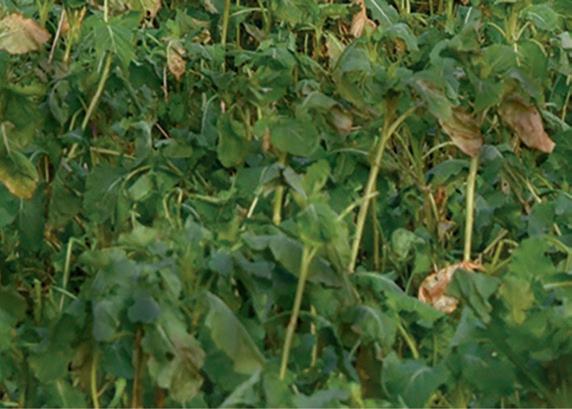

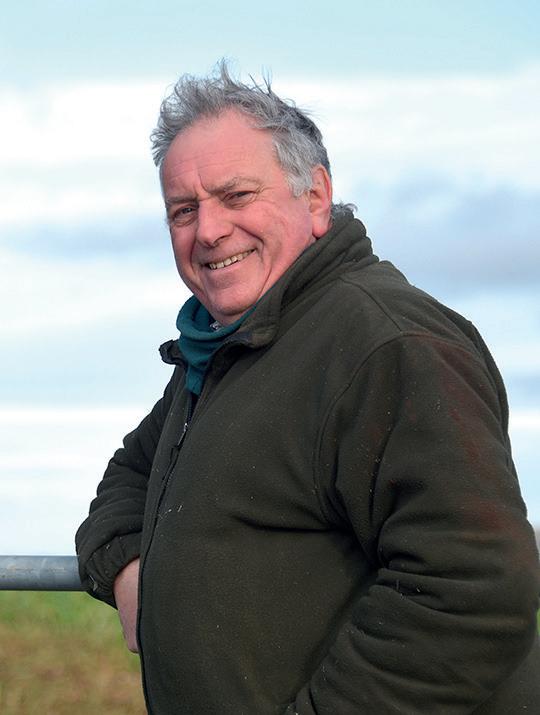
duce shapelier calves. Our 140 head herd runs well together.”
The Beef Shorthorn was originally tried out using artificial insemination until Mr Bedell knew the genetics
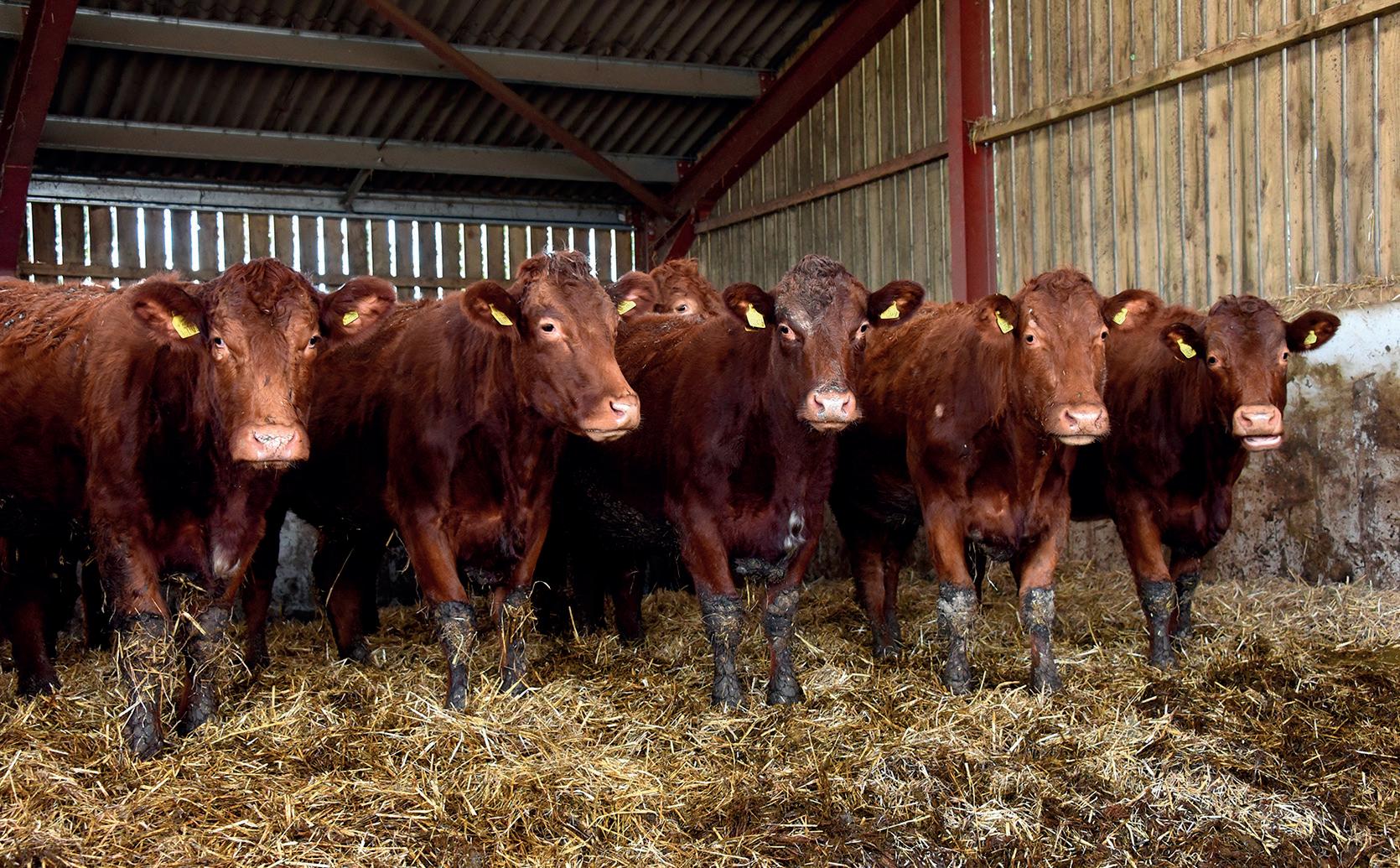

We run our system to keep optimum fertility in both the stock and the soilSIMON BEDELL
complemented the system, which is when he made the investment in a bull from the local Camlas herd.
“To keep calving tight and for the longevity of our bulls, we put around 30 cows to each bull. Our current Limousin bulls are the last two bulls sold from the Roughley herd from John Temple, who has been a family friend for many years.
“We also have Dyfri and Winnington bulls.
“We try to breed animals that have less extreme muscling and plenty of milk, so these genetics suit our herd well,” says Mr Bedell.
Calving starts in mid-March with both the Limousins and Shorthorns.
The farm has plenty of buildings, but to try and save on straw costs, they outwinter most of the cows.
Inside, the cows are only fed silage and are given a salt lick, to prevent them getting too fat before calving.
Outside the cows used to graze fodder beet, but they now strip graze a mix of kale, rape, and turnips where they are moved daily and also have access to hay.
Putting efforts into keeping the grazing diverse to benefit the stock and the soil, alongside the traditional grassland, Mr Bedell bales a blend of
ryegrass and red and white clover which is fed to the youngstock.
The cattle are given mineral buckets and are bolused to make up for the farm’s lack of copper, selenium, cobalt and iodine.
Most of the calves are sold as weaned calves, or at 12 months old, at the Bishop’s Castle and District Quality Cattle Association sale.
The Shorthorn cross steers are finished and sold through a Morrisons scheme to give confidence that the animals have a market regardless of TB status, although Mr Bedell says being in the cull area has helped with the disease prevalence significantly.
He aims to get a 50 per cent cow to calf weaning weight, with suckled calves sold at 320kg to 350kg, while the store cattle are taken to 500kg by feeding crimped barley, protein pellets and minerals.
“Despite the various breeding routes, we are still capable of breeding a consistent product and the cattle are aimed to be sold in groups of five to regular buyers,” he adds.
Mr Bedell is pleased with the blending of the breeds, with the Shorthorn delivering good growth rates and easy calving and the Limousins delivering muscling and pence per kilo.
“Quality means different things to different systems, but to me it is a good grass conversion rate and easy calving in a stylish animal,” he says.
Keen to be as self-sufficient as possible, Mr Bedell grows as much fodder as he can on-farm, although he has to buy-in straw, which he says is a worry for the future.
Mr Bedell says: “We hear the buzz words regenerative farming, but I
believe that regen is simply a mixed farming system, which is what most livestock farmers have been doing for generations.
“We run our system to keep optimum fertility in both the stock and the soil. History is repeating itself
in farming, but here in the Marches area, we have kept the hedges and trees to help our systems thrive, which in turn helps the wildlife.”
Until Mr Bedell started crossing the cows, the farm was primarily a sheep biased system and he was keen to increase cow numbers.
This enabled him to encourage more mixed grazing to avoid the ground becoming ‘sheep sick’.
He reduced the sheep numbers from 1,000 to 500 Texel and Suffolk cross ewes, which is where the numbers still stand today.
All of the lambs are sold liveweight in the local market at Bishop’s Castle after being lambed inside in March. Similar to the cattle, the sheep are fed on fodder grown on-farm.



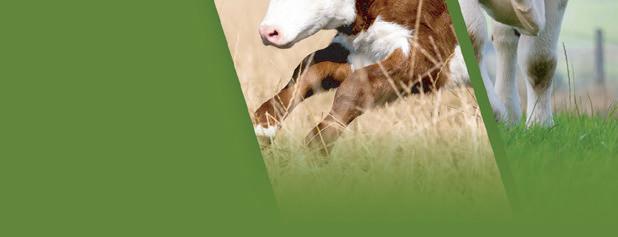






All prices quoted in p/kg.



Source: ScotEID/IAAS
Source: MartEye/LAA




Source:










6-12
Figures show livestock numbers first, then average price per head.


Primestock throughput, price and price change (p/kg).
Week ending March 24, 2024.
SHEEP prices eased ahead of Easter at auction marts in England and Wales this week.
Lamb prices reduced from 8.8p/kg to 373.6p/kg.
In the beef rings, young bulls saw a 2.9p/kg decline to 265.3p/kg, but prices were up for steers and heifers.
Heifer prices increased by 4.3p/kg to 283.2p/kg, while steers saw a rise of 5.8p/kg, reaching 278.1p/kg.
As Farmers Guardian went to press on Wednesday (March 27), UK LIFFE Wheat prices for May 24 were trading at £169.50/tonne, which was an increase of £1.50/t on the week.





O/SdeadweightpricesfortheweekendingMarch23,2024. Source: AHDB
Kirkby
- -
- -
Leek - -
Leyburn -Longtown - -
DeadweightsheeppricesarecollectedfromasampleofGBabattoirs.Thesampleaccountsforabout one-thirdofdeadweightsales;pricesquotedp/kgareaveragesforallqualities12-21.5kg.



GOOSTREY: Mon, hay, square bale to £135/tonne, round bale to £145/t, small bale to £158; haylage, round bale to £130/t, square bale to £158/t; barley straw, square bale to £173/t, round bale to £148; wheat straw, square bale to £120/t; mixed straw, square bale to £108; wrapped silage, square bale to £35/t; loose grass silage to £46/t.
Wednesday, March 27, 2024 (£ per tonne).
Last updated March 26, 2024
BPS ENTS English
Deadline – May 10, 2024*
Price at Average deadlines prices (2023)
Non-SDA - £80.59
SDA - £99.41
Moorland - £24
BPS ENTS Welsh Deadline – May 15, 2024
Price at Average deadlines prices (2023)
£45** £65
BPS ENTS Scottish
Regions 1, 2 and 3
Deadline – April 2, 2024
Price at Average deadlines prices (2023)
Region1 £120-145** £149.47
Region2 £30-35** £40.34
Region3 £10-14** £15.44
BPS ENTS Northern Irish Deadline – May 3, 2024
Price at Average deadlines prices (2023)
x0.9-1.1** x1.0
*FortradingDelinkagerefamounts;25p-80pper£1 ofDelinkagereferenceamount.**Estimates.
ENGLISH DELINKAGE REF DATA: averageof 2020/21/22claims.Seller’s2023claimnotneeded. Estimatedreturn£1.20/£1refamountwithbuyer’s delinkpaymentlessthan£30,000post-transfer.
SubjecttoDelinkagevalues2025-27.
BIODIVERSITY NET GAIN: English:Defra estimates£25,000-£200,000/unitexcluding VATandassociatedfees,subjecttolotsize.
LasttenderMarch8,2024,nextApril19,2024.
NUTRIENT NEUTRALITY: Long-termsales alltypesagricmanexcludingspecialisthabitat creation.Nitrates£3,000-£4,000/unit(£18,000£206,000/ha);phosphates£50,000-£65,000/ unit(£2,000-£169,000/ha). CARBON: Woodland Carbon>£35/WCU>£25/PIU.May2023WCG reverseauctionaverage£19.76. WATER: English abstractionlicenceslessthan£3-£15/cu.m.
Source: Townsend Chartered Surveyors




Last updated March 27, 2024
€1=
Wednesday, March 27, 2024.
1.
2.
3.
Wherestated,data providedbyAHDB.
Last updated March 27, 2024 Source: Straights Direct
Source:
Last updated March 26, 2024
Source: AHDB/LAA/IAAS
Key: All prices in pounds sterling. Currency, £/$1.264; £/€1.171
Guide prices indicated include delivery charge of £6/tonne. ✸ = After safe arrival; F = First half; S = Second half; ● = March; ✥ = April; ✦ = November/January; ◗ = November/December; ▲ = March/June; ✧ = May/June; ✪ = August/October; ❊ = June.
January 2024
Source: AHDB
1.Thiscontractwillreceivea1.33pplguaranteedminimumpayment.
2.Thiscontractwillreceivea0.50pplmemberpremiumpayment.
2.Thiscontractwillreceivea1.54pplTescocheesegrouppayment.
3.Thiscontractwillreceivea1.00ppldirectpremiumpayment.
4.Thiscontractwillreceivea0.40pplactual13thpayment.
5.FormerlyGlanbia-Llangefn.
Retailerpricesupplementsareincludedwhereapplicable.Supplementslistedareinadditiontolistedmilkprices.
UK milk deliveries in December 2023 were down 0.2 per cent on the year at 1,226 million litres. Cumulatively, this was 0.4 per cent down on the year to date.
December 2023 GB milk deliveries were down 0.4 per cent for the same period at 1,021m litres. GB milk deliveries for the year to date were 0.5 per cent down.















For 18 years, farms of all shapes and sizes have taken part in the widely recognised Open Farm Sunday event. Emily Ashworth finds out why it is more important than ever to connect to consumers.
THERE are not many opportunities for farming to welcome millions of people through its gates and allow the public to truly see the inner workings of British agriculture.
And that is exactly why Leaf’s Open Farm Sunday (OFS) event has been such a success.
Since its inception in 2006, more than 2,121 farmers have taken part in the mission to help educate and engage with the public, welcoming a staggering three million people onto farms across the country.
This year feels all the more important given that OFS is celebrating its 18th anniversary, and because it is also, once again, a year of great change in the industry.
I came with my wife and two sons to see the real way in which dairy cows are farmed in Britain. We were blown away at how well everything is run and the attention to detail that comes with farming. All the staff are unbelievably helpful and knowledgeable in their trade.
We will definitely visit again and pass on the good word.
Absolutely fabulous – gives you a real understanding of the complexity of arable farming, balancing a necessity for revenue and looking after the environment.
94%
AfterattendinganOpenFarm Sundayevent,94percentofvisitors feltmoreconnectedtofarmers.
The looming election leaves agriculture with an uncertain future, and as protests continue in key locations across the UK, with farmers leading the way in calls for change, OFS is an important opportunity to engage with those at the end of the farm-to-fork process so they can hear about farming from those who live it dayin, day-out.
The findings from last year highlight the significance of the event: one-in-five visitors said they had never visited a farm before, 96 per cent of visitors said they felt they had a greater appreciation of the work farmers do, 94 per cent felt more connected with farmers, and 93 per cent gained a better understanding of what ‘sustainably-produced food’ means.
Informed choices
Andy Bason runs an 800-hectare (1,977-acre) arable farm at Newhouse Farm, near Winchester. It has been owned by the Cammack family since 1999, and they first participated in Open Farm Sunday in 2019. Having started with an invitation-only process, they have grown in confidence and their event now welcomes 1,500 visitors.
Andy says it is ‘important to showcase what we, as farmers, are doing’.
“It is a great way to show the public that making informed choices about where their food comes from matters,” he says.
“There is a huge demand for knowledge about farming from the public. We, as farmers, owe it to our industry to fill the current knowledge gap.”
There are various aspects to a farm visit at Newhouse Farm, including woodland management, livestock and arable.
Visitors can talk to experts or opt for a tractor and trailer ride, but what Andy enjoys most is the
response, which makes putting on the event worthwhile.
He says: “My favourite moment of Open Farm Sunday is walking around the event and listening to the conversations and comments from the public, which are always positive.”
Each event, on every farm taking part is different.
Dairy farmers Rachael and Richard Risdon, of Woodrow Barton Farm, Exeter, first hosted in 2017.
They have their own story to tell – their 162ha (400-acre) farm was originally across arable and sheep, but it has been converted to an all-grass, spring-calving dairy farm.
They have decided to keep their events on the smaller side.
Richard says: “For our first event, we advertised in the local parish magazines and school newsletter, which led to 60 local visitors.
“Since Covid-19, we have used the free ticketing system to help manage numbers, and we limit it to 150 people.
“Our Open Farm Sunday consists of two guided walks looking at the grazing cattle, livestock and parlour to show visitors the processes of our dairy farm. Then, after the farm walk, we hand out free milk and milkshake samples.
“We are doing this because we firmly believe that people need to connect with where their food comes from.”
According to research from NielsenIQ, sustainability is at the top of the list for consumers. The term is one used heavily in farming conversation at present, especially concerning policies such as the Sustainable Farming Incentive and the Welsh Sustainable Farming Scheme.
There is no doubt that this is
There is a huge demand for knowledge about farming from the public. We, as farmers, owe it to our industry to fill the current knowledge gap
ANDY BASON
at the forefront of farmers’ minds, and most are already farming in ways that adhere to such practices.
But the job now is to convince shoppers. According to the NielsenIQ study, 61 per cent – which is nearly two-thirds of UK consumers – felt sustainability was more important to them than it was two years ago.
Plus, 78 per cent of consumers said that in order for them to make informed choices, it should be mandatory for businesses to give full transparency into their supply chain.
This is where OFS can play a vital role in helping to bridge that void of knowledge that seems to sit between the farming world and those outside it.
Last year, 87 per cent of visitors said OFS increased their trust in British farming – if there is one thing that can help build consumer relationships, it is trust.
FIND OUT MORE
Open Farm Sunday takes place on June 9, 2024. Find out how you can take part at farmsunday.org

TAKING PART
If you want to take part and share farming’s story, visit farmersguardian.com/FarmingCAN

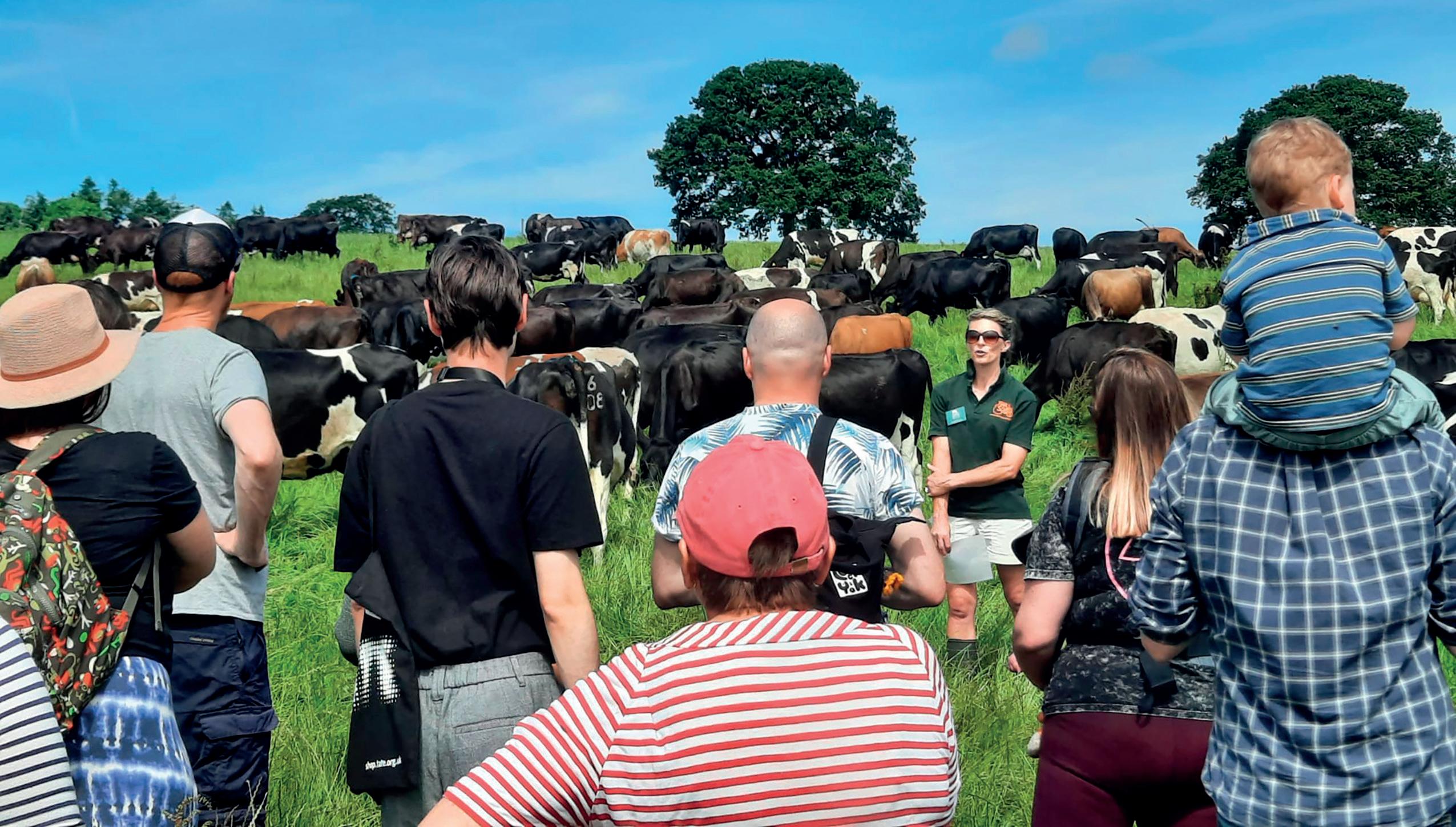

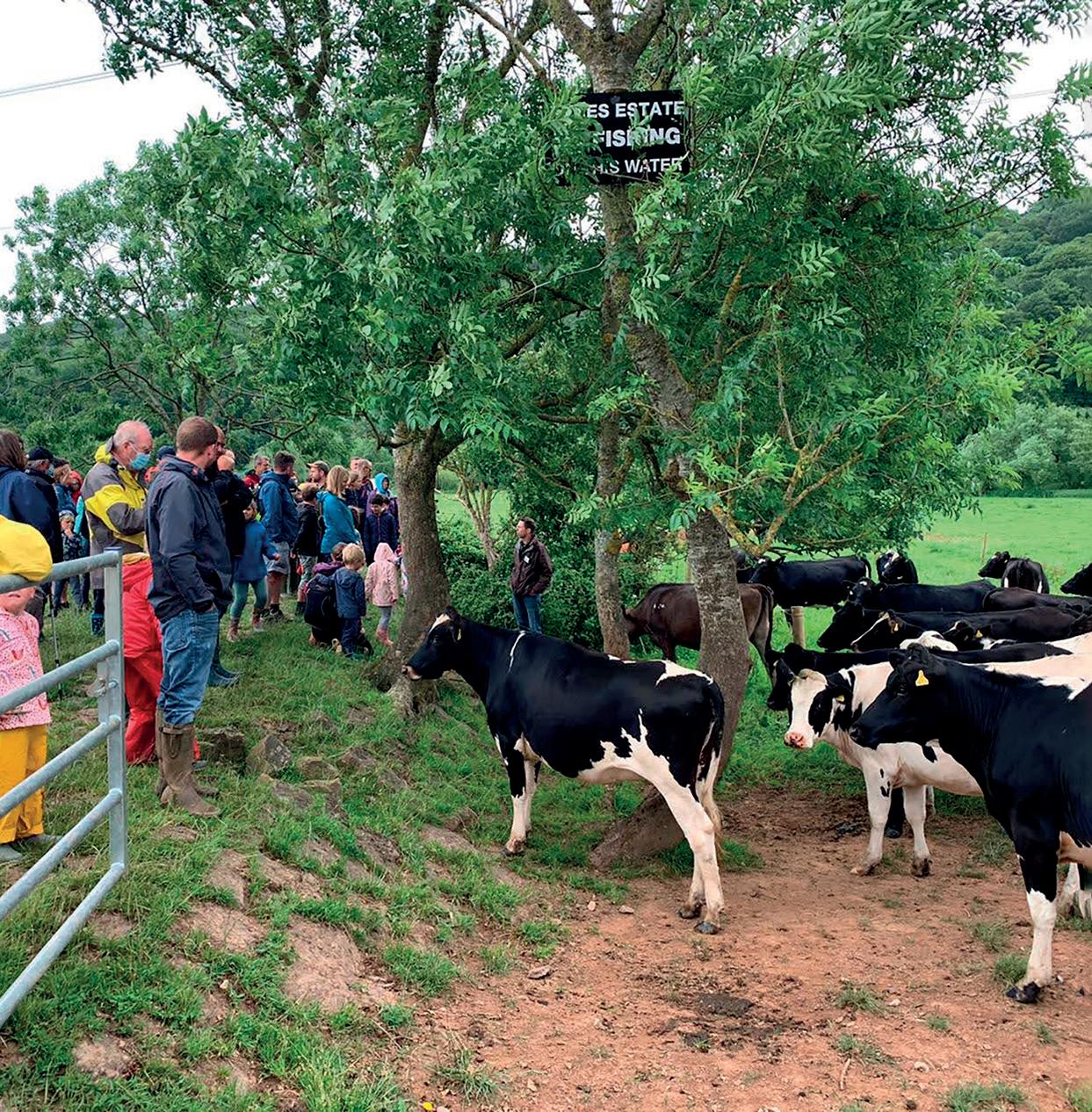


Cumbria
James farms Dairy
Shorthorns east of Kendal, Cumbria, with his parents Kathleen and Henry, wife Michelle and sons Robert and Chris. The fifth generation to farm at Strickley, he is also vice-chair of the Nature Friendly Farming Network.
Iam sat with my feet up while typing this, I have one eye on the laptop and the other on the Sunday evening weather forecast. I wish I had not bothered with the weather though, there looks to be rain every day. Again.
The wet weather is causing a delay to field work.
We still have most of the slurry to spread onto the silage fields, hull muck to spread onto the hay meadows, fences to put up alongside the newly planted hedges, and then there is the turnout of cattle, all of which I had hoped to have happened by now.
Today, however, was a proper spring day, sat drinking tea in the garden, contemplating mowing the lawn, but then deciding to go for a walk around the wood and pond for a bit of ‘vitamin tree’ instead.
Kingfisher
Spring is creeping into life everywhere. Bluebell leaves bulking up ready for their magnificent display of flowers in a few weeks, a solitary peacock butterfly woken by the warm sun and we were also lucky enough to see a kingfisher only a few feet away, probably looking for a nest site.
Getting into nature has been a good way to clear my head of all the bovine TB worry that is still hanging
WITHsomesunshinearound,and warmertemperaturestoo,youwould beforgivenforthinkingthatspringisin theair.
Unfortunately,thesunshineisnot lastingthatlong.Manyfieldsarestill floodedandtheraincontinuestofall.
However,springitis,andtherehas beenanoticeableincreaseinthe numberoffarmerscallingour WeatherLIVEservicethisweek,all askingthesamequestion:‘whenwill theweatherimprove?’.
Ihavewrittenbeforeabouthow, sometimes,weforecastersplaythe roleofpsychologist,anditdoesfeela littlelikethatrightnow.Butthereis
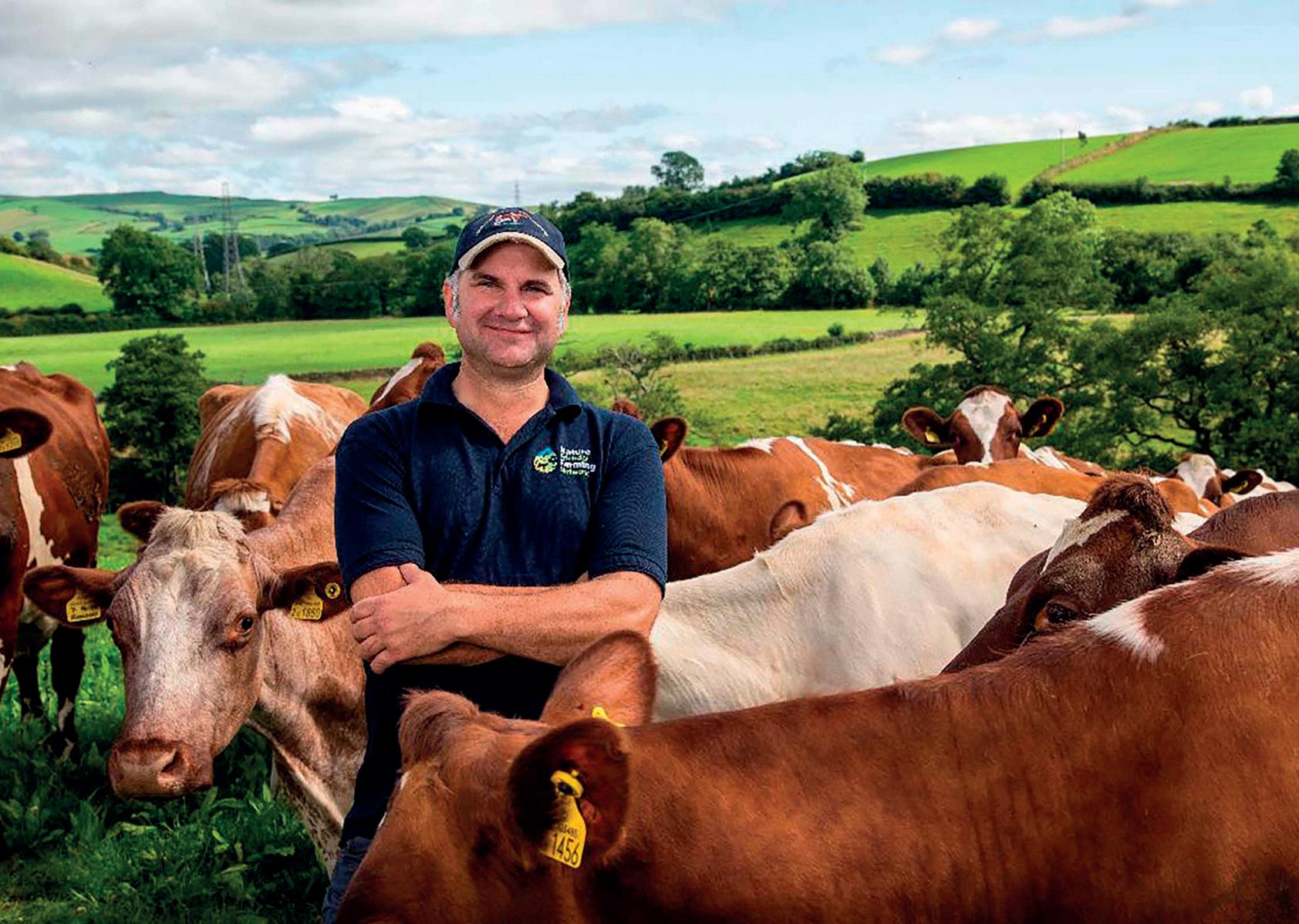
‘Getting into nature has been a way to clear my head of the bovine TB worry’
over us and our cows; we are due to do a whole herd skin test in three to four weeks. Until then we are very much in limbo waiting, fingers-crossed for a good result this time around with a reduction in new reactions. That would be a good way to start the new grazing season.
Following my previous In Your Field piece which focused on our bTB situation, I received lots of very kind messages via email and a nice hand-
written letter from a retired dairy farmer telling me about his experience of the disease and how it was dealt with during his generation.
Hearing how it affects every farm it touches brings home how huge the problem is and how different control methods can help to reduce the disease burden in cattle and wildlife.
I have heard it said that to control bTB effectively and to bring about a reduction in new infections, we need
to use all the tools in the box and that includes Government, farmers and vets all doing their utmost both individually and collectively.
Hopefully you can read Farmers Guardian over the Easter weekend and you find time to relax with family and friends in the spring sunshine, either from the comfort of a garden bench or a tractor seat while catching up with some of that field work.
Happy Easter to all.
somegoodnews,oratleastIhope thereis.
Longerrangemodelsdoseemto besuggestingsomesortofweather patternshiftasweheadintothenew month.Wemayhavetowaitsome time,butIamhopefulthataswehead towardsmid-April,acombinationof eventsconspiretokicktheweather intospring/summermode.
Yousee,weneedtogetridofhigher pressureovernorthernCanadaand Greenland,whichhasthe‘effect’of pushingthejetstreamfurthersouth intothemid-Atlantic.This,inturn, allowslowpressureareastobe furthersouthtooandthenhittheUK.
Butitisnotonlyrainfallbutcolder temperaturesthatareapparentwhen thelowpressuremovesfurthersouth.
Hintsarethatthehighlevelwind patternaroundtheNorthPolechanges aroundmid-April.
TogetherwithawarmingNorthern Hemisphere,thisshouldallowthehigh pressuretothenorthtoweaken, encouragethejetstreamnorth,and returntheUKtoamore‘normal’ weatherpattern.
Thatisnottosaythatweshould expectdayafterdayofdryweather andwarmtemperatures,justamore ‘usual’weatherpattern.
HappyEastertoyouall.

North Wales Dan Jones
West Sussex James and Isobel Wright
‘They are rivals on and off the show field it seems’
Yorkshire
Helen is a fifth-generation farmer who farms with her parents, David and Anne Shaw, husband, Craig, and their children, Alfred and Hattie, at Grey Leys Farm in the Vale of York. The farm comprises 162 hectares (400 acres) of grass, maize and wholecrop for the herd of 240 pedigree Jersey cows and more than 200 followers.
Spring vaccinations are well underway, with cows and heifers being vaccinated against leptospirosis.
Heifers which are due to be turned out for the first time have had their primary dose of lungworm vaccine.
At the same time, we started selecting the heifers that will make up
our show team for the North East Jersey Club Calf Show, which we host at the farm annually.
There are some promising calves coming through and the halter training will begin in earnest soon.
We prepare around 20 calves for the showring, to be shown by children of all ages and experience, so they need to be somewhat well behaved.
I was pleased to be interviewed by our local newspaper about the herd, farm and the vending machines.
Jealous
They sent a photographer, who, unfortunately for me, got a great shot of me being booted from behind by Olive, one of the show cows, who was jealous that Dad had selected a different show cow for a picture.
They are rivals on and off the showfield it seems.
Because of our involvement with student placements, I was recently invited to a seminar about T-levels at the local college. T-levels are two-year
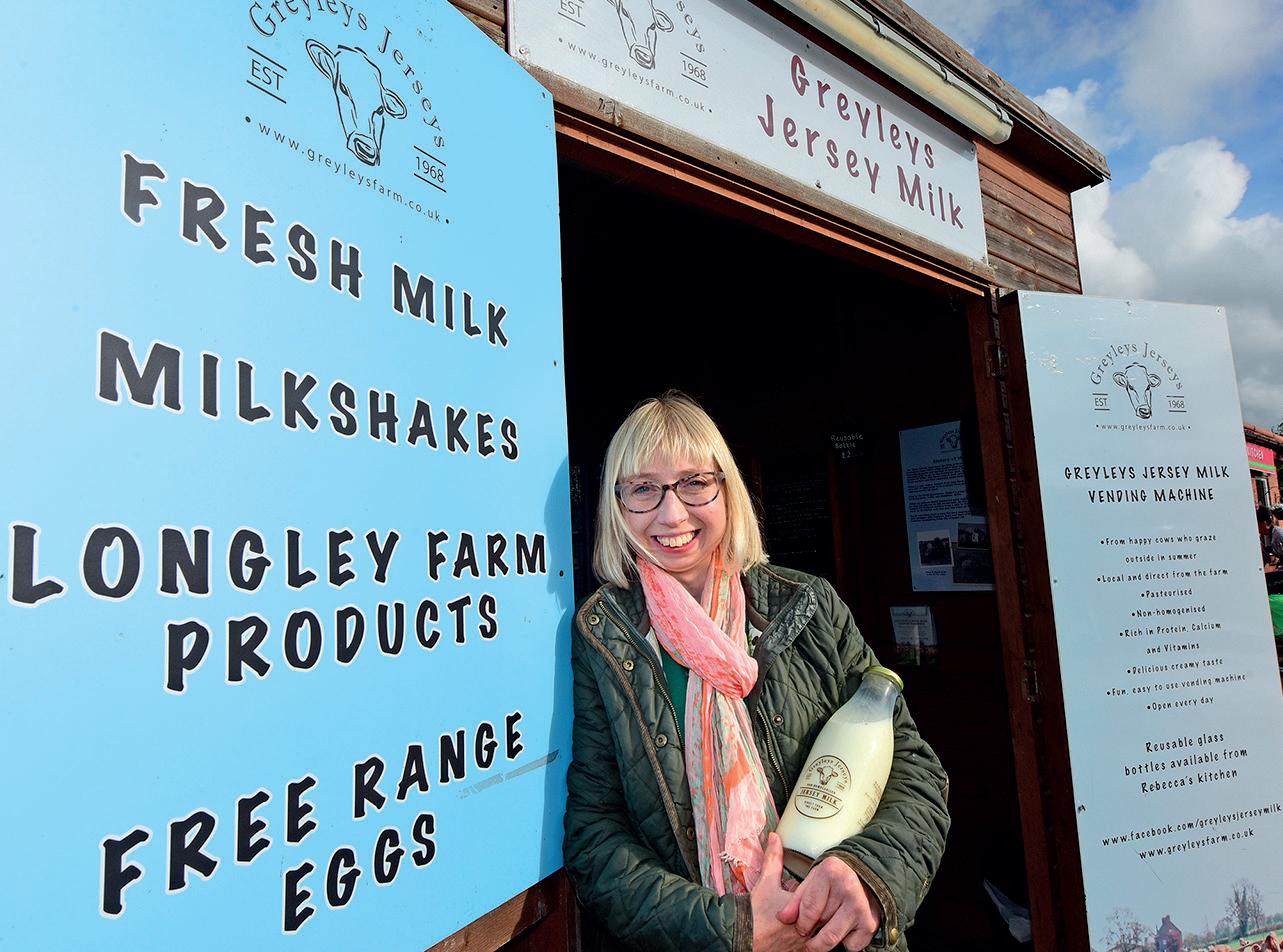
courses that can be done as an alternative to A-levels after GCSEs.
They are offered in a wide range of practical subjects which now include livestock, crop production and animal management.
The course is 80 per cent classroom-based and 20 per cent placement – the student must complete 315 hours of work experience over the two years.
A key difference from other courses is that the timings of the work experience is flexible. It can be done one or two days a week or as a block and can include weekends and holidays.
This may make it more of an option for farmers who could support a

student at a certain time of the year rather than all-year-round.
There will be many eager students looking for placements from September, so contact your local college for more information.
Encouraging and inspiring students is vital for our industry and placements are a good way of providing extra resource on-farm, so get involved if you can.
Finally, I am delighted to have been selected for a position on the NFU national dairy board as a regional appointee for the North region.
I hope I can help make a difference for farmers and I look forward to meeting members in due course.
Sendinyourcorrectentriestobeinwithachanceofwinning£20worthof Love2shopvoucherseverymonth.Sendto:CrosswordNo.1238,Farmers Guardian,Unit4,FulwoodBusinessPark,CaxtonRoad,Fulwood,Preston,PR29NZ.
1 Atmospheric conditions, it’s said, for a castrated ram (6)
5 Warm garment for cow? (6)
10 Sort of macho coffee (5)
11 Type of clause in agreement; way up and down (9)
12 Small alcoholic drink picked up, we’re told for man looking after pigs (9)
13 Standard weight of vehicle? Answer - tons (5)
14 Machine for fastening unmanufactured wool roughly at first (7)
16 Miserably wet hare, probably the result of this prevailing state (7)
18 Display of courage is well done involving adult daughter (7)
20 Beatles last album - leave it undisturbed (3,2,2)
22 Chosen selection of travel items (5)
24 Computer representations of feelings incorporating characters principally (9)
26 Provider of beef cut short conversation with worried sailor (9)
27 Senseless! That is boxing granny! (5)
28 Young cow here if wandering (6)
29 Pony or its grazing ground in SW England (6)
Answers to
2 ChileanadsurprisinglyforaMexican dish(9)
3 Liftwithgreateffortbundlesofcorn withoutsidestrimmed(5)
4 Maybedoescaviarthat’sexpensive,it’s said(3,4)
5 Sailorputuprollofbanknotesforflier (7)
6 Unwillingcattlerunindisarray(9)
7 Professionalclownoriginallylost organiccompound(5)
8 Crosswithoil-producingplantendlessly turningupinfestiveseasons(6)
9 Decrepitcarburntessentiallyinmouth ofvolcano(6)
15 Discontinuesdescribingstateofbare branchesofdeciduoustrees?(6,3)
17 Trickyproblemyou’dbewisetodrop (3,6)
18 StrongchemicalleftinStrand(6)
19 Ordinarylivestockenclosure,warm anddryoutofdoors(4-3)
20 Briefexaminationoflooseendsatfirst drawinginking(4-3)
21 Englishflowerfestival(6)
23 Angrywhenbuccaneerisbeheaded (5)
25 Formofexpressionheardonedayon IsleofMan(5)
Edible, 24 Rinse, 25 Basic.

Lambing continues at a pace here at home and, like the weather, these last few weeks on the political spectrum have been a whirlwind of unseasonal heat and foggy conditions, with rays of sunshine being few and far between.
However, as a glass-half-full person, I am hopeful that the new Cabinet Secretary for Climate Change and Rural Affairs, Huw Irranca-Davies, will bring with him new insight, new vigour and new ideas. We certainly need to see change, and I wish him all the best in his new role. We have already asked for an early meeting so we can begin to speak
with the Minister and his team so that our members’ views receive the recognition they deserve. We want to help shape agricultural policies in Wales that work for Welsh farmers, rural communities, businesses and the environment. Only then will we see real joint working between the industry and Welsh Government.
We recently provided oral evidence as part of the Senedd Climate Change, Environment and Infrastructure Committee’s inquiry into the Sustainable Farming Scheme (SFS). The Farmers’ Union of Wales policy team presented a




strong case for the need to rethink the current proposals.
We have no doubt that by ensuring the mandatory element (universal layer) of the scheme is achievable, accessible and economically sustainable for all, it will deliver far better results in the long-term, rather than focusing on short-term targets which are only six years away.
to bovine TB management and eradication, and the pan-Wales Control of Agricultural Pollution ‘Nitrate Vulnerable Zones’ regulations are topics causing the industry grave issues. These will also be important for discussion the minute we sit down with the new Cabinet Secretary and his team.
We attended Plaid Cymru’s spring conference last weekend, and discussed with Senedd Members the compounded impact that these current policies and proposals are having on the industry.


Gareth Parry, our deputy policy officer, explained to the inquiry: ‘if the scheme is not economically sustainable for all actively farming businesses, the Welsh Government can forget about incorporating a mandatory tree cover target within the universal layer of the scheme on any percentage of land’.
We have been told repeatedly by the Welsh Government that this scheme will not be introduced until it is ready. If we find ourselves in a position where the scheme is not fit for purpose by the end of this year, the extension of the Basic Payment Scheme must be a real option. That will be another of our key asks during our upcoming discussions with the new Cabinet Secretary.
The urgent need to rethink the SFS proposals in genuine co-design also includes other longstanding issues that need to be addressed. The Welsh Government’s approach
The widespread frustration among our members is developing into a significant increase in referrals to rural mental health charities, such as the DPJ Foundation.
To me, such a development is extremely worrying. I would urge anyone struggling and finding things difficult to talk with a family member, a friend, a neighbour, the unions, or one of the wonderful charities which are only a phone call away that can offer support and guidance. You are never alone in this industry.


